- 0 No item in your cart
- SUBSCRIPTION
- Classified Ads
- Technical Specifications
- Destinations
- Address book

- All the magazines
Catamaran basics The daggerboards: understanding and adjusting them

Article published on 01/04/2015
By Emmanuel van Deth
published in n°141 may / june
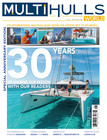
Having a catamaran with daggerboards means enjoying better pointing ability than an equivalent model equipped with fixed stub keels, which are inevitably shorter. It means that you can also optimize drag, speed and even safety. Partially integrated, with foils...an inventory of the daggerboards on our boats and how to use these appendages.
Create a notification for "Technical"
We will keep you posted on new articles on this subject.
1) All the Catanas are equipped with daggerboards. They are very long, and held structurally in their cases by the whole height of the hulls. Simple and strong, but beware of the significant windage in the raised position.
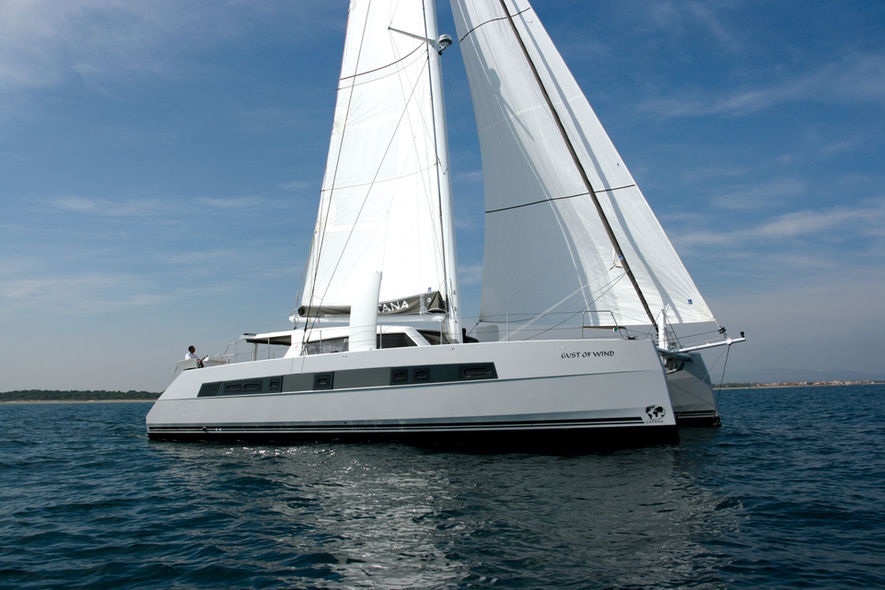
2) The latest Catana models are equipped with curved daggerboards. On the 59, the foil effect is worth 500kg at a speed of 15 knots.
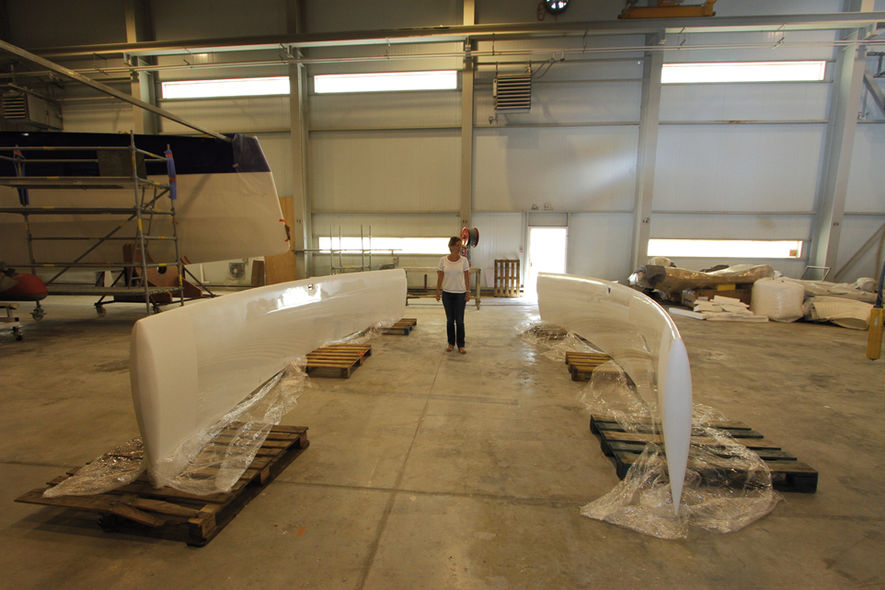
3) The latest Outremers have adopted shorter structural cases, to reduce the size of the daggerboards. Less windage in the raised position and less weight, but the construction is more complex…
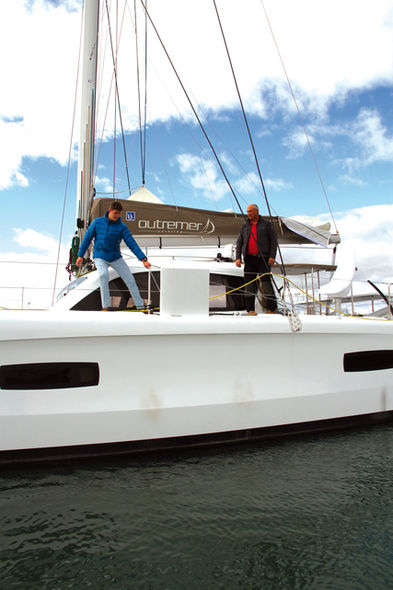
4) Numerous trimarans are also equipped with daggerboards/centerboards. They can be central and integrated into the accommodation, as aboard this Dash 750.
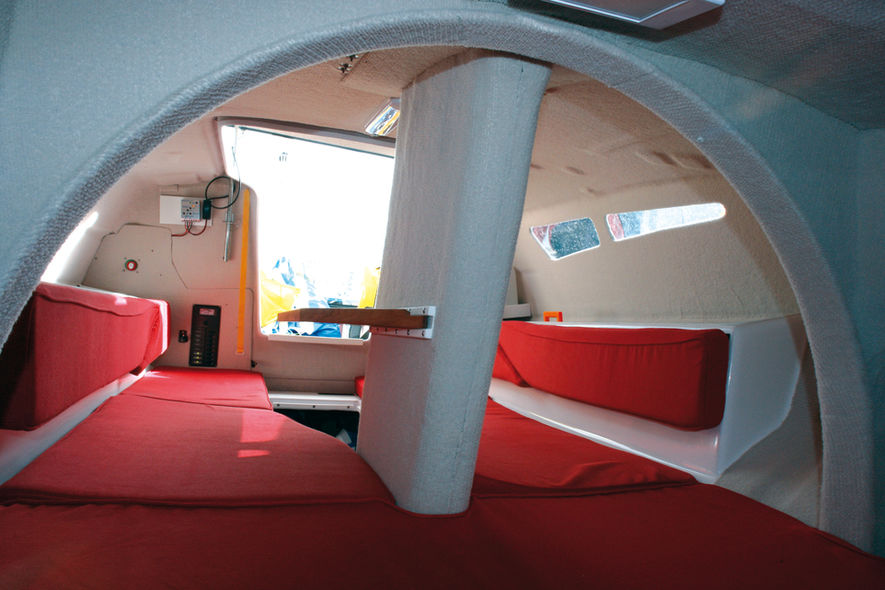
5) Other trimarans, such as the Tricat 25, are equipped with centerboards integrated into the floats.
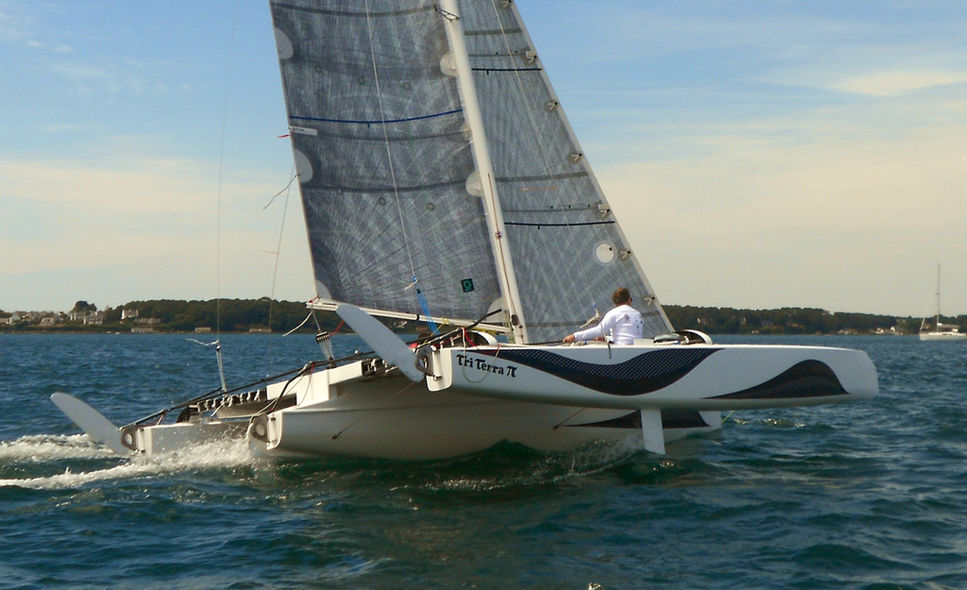
6) Builders such as Outremer provide stopper knots for the daggerboard control lines; a good way to judge the position when the daggerboard is not visible.
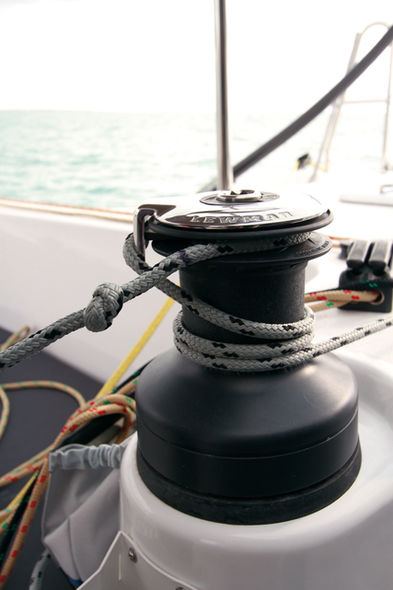
7) Once the daggerboard is out of its case, it is easier to judge: the lifelines are an excellent adjustment indicator!
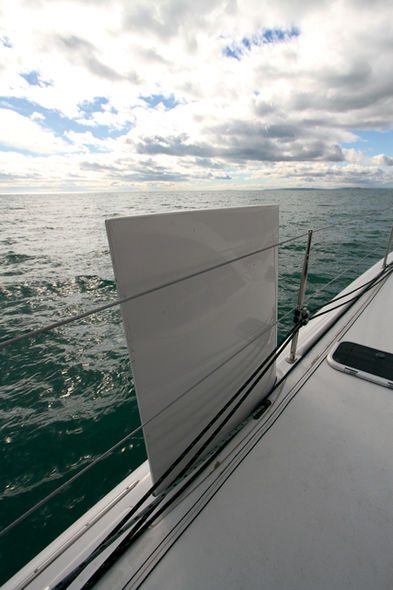
8) To windward in light weather, the daggerboards are fully lowered, to take advantage of maximum 'grip' on the water.
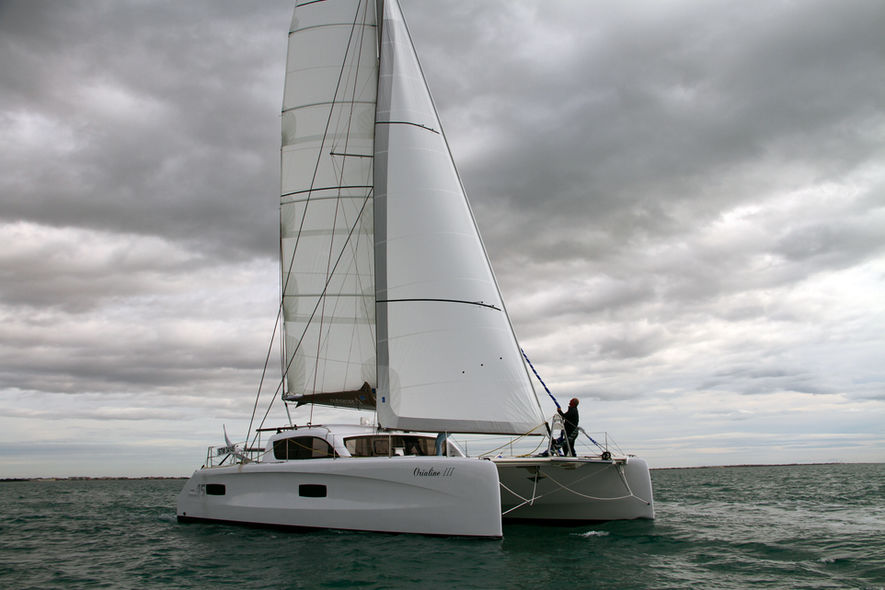
9) When the speed increases, it is worthwhile raising the windward board to optimize drag. Note: a daggerboard which moves is no use. Therefore we raise it!
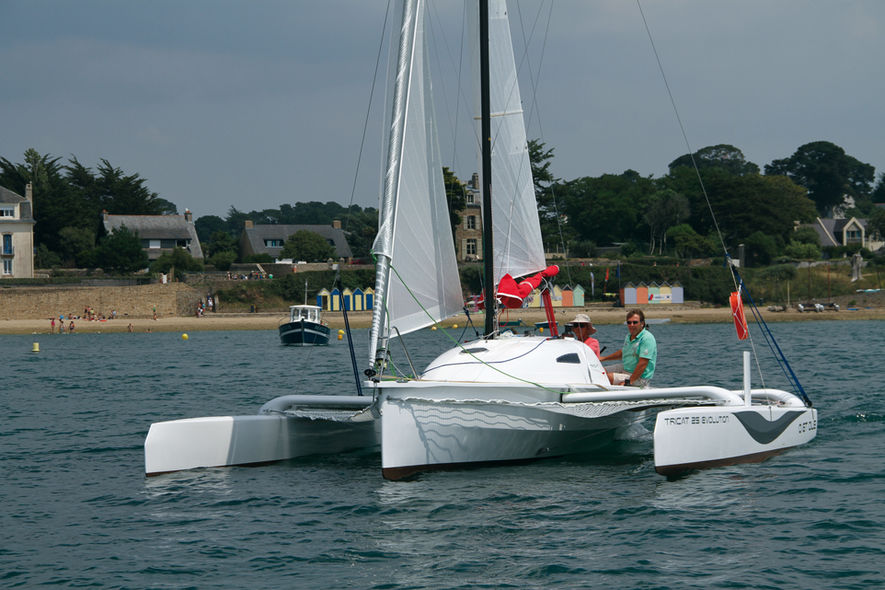
10) But for safety, it is preferable to raise the leeward appendage: in the case of a strong gust, the risk of the boat ‘tripping up’ is thus reduced. The compromise could be to raise both the daggerboards by half... It’s up to you to judge!
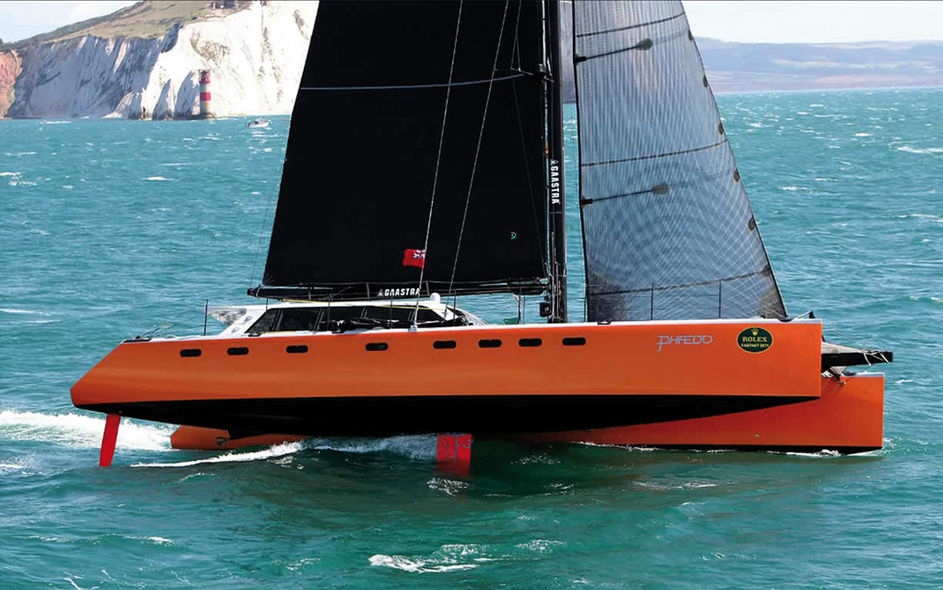
11) Downwind, the daggerboards are no longer useful, especially when the boat exceeds 10 knots... Keeping one third of the surface can however help the helmsman or the autopilot to steer a straighter course.
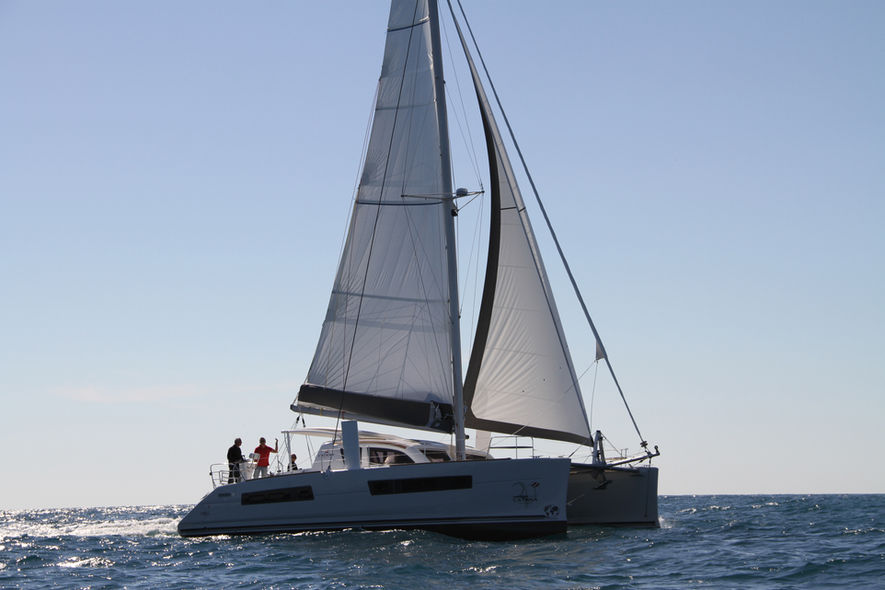
12) Heavy weather? Raise them completely so the hulls slide. On the other hand, with big seas from behind, (just like downwind in more manageable weather) it may be useful to keep a little daggerboard lowered to avoid yawing.
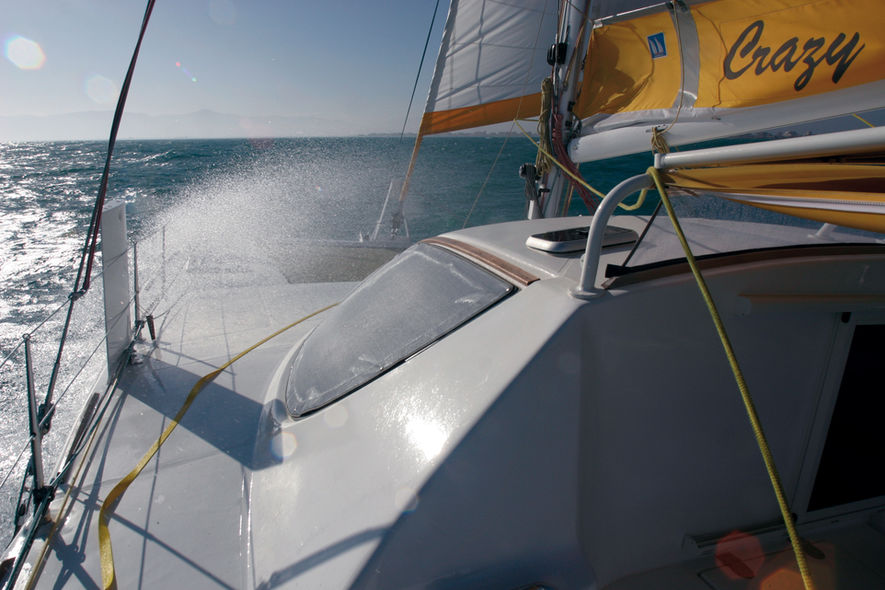
Subscribe to Multihulls World and get exclusive benefits.
Tags :
- préparation ,
- Catamaran basics
Did you like this article ?

Share this article
Most-read articles in the same category.
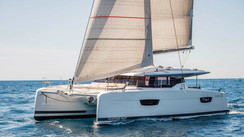
Bending on sails - Everything you need to know for making the most of your multihull
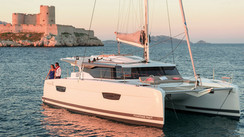
Maintenance - Saildrive legs
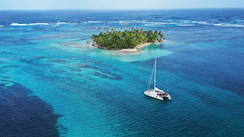
Anchoring - All you need to know about bridles
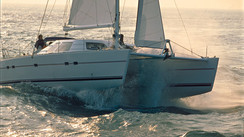
Forepeaks - How do you make the best use of them?
Everything you need to know about trampolines
Davits and arches : Getting your dinghy back aboard your multihull
What readers think.
Post a comment
No comments to show.
Follow us on
Vous avez ajouté " " à vos favoris., vous avez supprimé " " de vos favoris., in order to add this article to your favorites, please sign in..
Log in or Sign up
You are using an out of date browser. It may not display this or other websites correctly. You should upgrade or use an alternative browser .
Catamaran daggerboard design and use
Discussion in ' Multihulls ' started by Steve W , Aug 2, 2017 .
Steve W Senior Member
I am a bit confused over the pros and cons of different types of daggerboard setups. A lot of performance cats such as those designed by Tennant, Grainger etc use boards installed down the inside face of the hulls meaning that the board is vertical when the windward hull us just clear of the water whereas a lot of newer cats are installing them following the outside angle which to me seem less than optimal for a couple of reasons such as being more difficult to operate hanging out over the water usually requiring some kind of apparatus to raise them and also longer boards since you cant cantilever them down inside the trunk so , more weight, also it would seem to me that as the boat lifts a hull the board would be less vertical so provide less lateral resistance so maybe need more board deployed. I'm talking straight boards here, c foils would seem to be worse still at providing lift ( as in to weather, not upward lift) Using a straight board following the angle of the outboard face of the hull does not seem like enough angle to provide significant hydrodynamic lift to me to be worth the disadvantages ( hence c foils) but I could be wrong, just trying to understand the reasoning. Steve.
Doug Lord Flight Ready
If you haven't seen it, this article may be of some help: Daggerboard Debate http://www.proboat.com/2010/04/daggerboard-debate/
jorgepease Senior Member
That was a good article!
farjoe Senior Member
Are there any websites dedicated to the design and construction of homebuilt lifting foils for boats under 6m?
Don't know of any websites so far, but there is an excellent book: "Hydrofoils Design Build Fly" by Ray Vellinga and available on Amazon.
Doug Lord said: ↑ Don't know of any websites so far, but there is an excellent book: "Hydrofoils Design Build Fly" by Ray Vellinga and available on Amazon. Click to expand...
catsketcher Senior Member
Gday Steve One major reason is because of accomodation. Some early cats had vertical boards but these severely impacted the use of the hulls. So you have to go either outboard and cant one way or inboard and cant the other. From there it may come down to safety vs speed. For a non lifting board (all Tennats are non lifting) all the board does is provide a vertical force. In a racing boat that flies a hull and sails at a high angle an inward board will be more vertical when hull flying as well as easier to pull up and down. On top of this you don't have any worries about boards at the marina hanging over the side. Against this is safety. A little Aussie cat, the Seawind 24, had outboard boards that were heavily angled. Owners reported that when hit by a gust the boat would slide to leeward, lifting the leeward hull and pulling down the windward hull. The little Seawind was a pretty great boat. So a cruiser/racer designed by say Lock Crowther, that was not meant to fly a hull regularly would have the outboard boards. On my cat the boards are outboard and only have a modest cant. I have never flown a hull so it works pretty well. cheers Phil
UpOnStands Senior Member
Also, more recent cat designs tend to have more vertical outboard hull sides. This can minimize some of the problems.
Thanks guys, I used to own a Macgregor 36 cat that had a single vertical board in the port hull that you had to crawl past to get into the berth, It was a cantilevered board like Malcolm Tennants boats so the strong points were the bunk top and the hull bottom. On a cat with a single board vertical was probably a reasonable compromise but they went to 2 boards on later models. All beach cats are vertical (until the introduction of lifting foils) as they don't have accomodations to impact, although they are not cantilevered. It seems to me that unless you are getting significant hydrodynamic lift from the outboard boards they would be more of a pita as I would think they would need to be longer and need some kind of frame to raise them ( heavier). Even if you can push them down manually it can be precarious doing so, they can as Phil mentioned hang way out the side when raised and be less effective at preventing leeway as the boat heels and lifts a hull whereas the inboard style board gets more vertical so I would expect you would need less board deployed (less drag). So, what I'm curious about is if the lift generated by a board that is angled inward at, say, 5-8 degrees enough to be worthwhile given all the negatives in every other area in the real world ? I have a friend who bought a cat where the boards have been moved from inboard to outboard so someone thought it would be but who knows if it panned out. Grainger has some interesting thoughts on his website, he considers Mad Max to be one of the fastest cats in Aus and I see it still has its boards inboard. I'm sure the choice of inboard or outboard location at the design stage would depend a lot on the type of layout of the cat, ie, with a net and tube racing cat such as a GBE inboard is very convenient and simple whereas outboard would make more sense on a cat with a bridgedeck cabin but on a net and tube racing cat where efficiency is the only goal which way would you go? My other question relates to the actual use of the boards, how much to deploy on the various points of sail at different wind speeds. Obviously you would use more board upwind, less reaching and even less to none running but how much? I would guess that the more speed you have upwind the more lift you are generating so the less board you would need. It seems to me that you would want as little board as possible deployed for drag reduction but I don't know. Thanks for any insight, Steve.
groper Senior Member
to go upwind its pretty much more board the better. practical size limits the ultimate size. As to cant - the more vertical the better for upwind performance. some race boats cant them inwards so they are vertical once flying hull - not applicable to cruising boats. A good cruising boat still needs good upwind performance tho, and they normally travel with little heel - hence the vertical boards are ideal for performance but they ruin the interior space - which is also important for cruising . So the best compromise on a cruising boat would be whichever cant was less - inward or out, and keep the board running down the topsides so you don't have a trunk in the middle of the hull and maximise interior utility. Really big cats however - can have a trunk in the center and you still have enough room in the hull to fit full size accommodation spaces on both sides of it - this doesn't apply to smaller boats tho. For racing it can go either way depending on whether the boat is designed to float or fly. Some vertical lift may increase speed - such as the C boards used on the racing trimarans, however you loose some leeway due to the angle. The racing tris offset this loss by including the centreboard in addition to the C boards in the amas. If the race boat is a floater only - then inward cant is likely best so the board is vertical providing maximum lift upwind whilst the boat is heeled and flying a hull. This concept is proven as the fastest smallish catamaran in Australia right now is setup like this (40fter). Round the bouys racing is usually won on the upwind performance - less so on the downwind and reach legs. Assymetric boards is another consideration - again is depends on the intended usage. For racing maximum lift to drag ratio is paramount - hence better to use assymetric boards 1 at a time and size them accordingly. For cruising - most people cant be bothered rasing and lowering on every tack and the total performance not so important to most people. Hence they normally use symmetric boards both down at once. More area in the water but and not as good lift to drag ratio - set and forget when tacking upwind... Horses for courses steve - no simple answers I'm afraid
- Advertisement:
Hi Groper, thanks for the insight, pretty much my thoughts also. On cruising cats you either have low aspect keels or either kickup centerboards or if it is more performance oriented daggerboards which, as you say, usually follow the outside angle of the hull topside because of how they fit with accomodations rather than any sailing related issue. However with net and tube type racing cats you get to choose whether they angle in or out at the design stage based on performance alone. To my way of thinking angling out such as most of Tennant and Grainger cats have them place for two reasons, easier to raise and lower so they can be cantilevered down into the trunk so they can be considerably shorter for the same draft so , lighter. Daggers are rarely very light so any savings in length is worthwhile plus you don't need any additional structures for raising them which is also a weight saving. The other more obvious advantage is of course the board is close to vertical when the windward hull is just out of the water. I would guess that with them angled inward ( underwater) you would need to deploy more board for leeway resistance (more drag). I have however seen cats switch from outboard angled boards to inward angled which leads to my confusion, I totally understand the desire for hydrodynamic lift and on tris its a no brainer as, as you say, they have a daggerboard in the main hull for upwind work and also the boards in the amas can, and are angled at a much greater angle than can be achieved on a cat so provide real lift, even with simple straight boards. I just question how much lift a board in a cat angled at maybe 5-10 degrees give vs the disadvantages. As far as asymetrical boards go they only make sense on actively sailed cats, ie racing cats and I think would be necessary on cats with inward angled boards. In the US we have Gemini cruising cats with asymetric centerboards that require you to go down into one hull and crank a winch handle to raise one and then cross over to the other lower the other. Not going to happen imho on a cruising boat. Steve.
Martin Fischer-Catamaran Daggerboard position: foiler and convertible--
Extra Marstrom 32 and f40 catamaran hulls
Light weight big open deck catamaran
Limits to the beam of a catamaran ratio ?
Where did Uffa Fox sail Shearwater Catamaran 990?
Catamaran Strength Analysis
Gemini Catamaran, new builds?
Designs of catamarans not in metric but SAE
Rudder lift on Boardless Catamarans?
Difference concept of cruising catamarans
- No, create an account now.
- Yes, my password is:
- Forgot your password?

Did You Know That We Offer Contract to Closing Services? Click Here to Find Out More.
Need Marine Financing? Apply Here With Our Partner, First Approval Source
- Catamaran Interviews
- Catamaran Reviews
- Buying Advice
- Selling Advice
- Woods Design Advice
- Americat 3014
- Balance 526
- Bali 40 Catspace
- Beneteau Blue II
- Broadblue 346
- Broadblue 38 Prestige
- Broadblue 385
- Broadblue 435
- Broadblue 46
- Catalac 10M
- Catalac 11M
- Catalac 12M
- Catalac 900
- Catana 42 S
- Chris White 48 Voyager
- Chris White 55
- Corsair F28 R
- De Villiers
- Dolphin 460
- Endeavour 30
- Endeavour 35 Victory
- Endeavour 36
- Endeavour 44
- Endeavour 44 TrawlerCat
- Fortuna 36 Island Spirit
- Fortuna 401 Island Spirit
- FP 32 Maldives
- FP 35 Tobago
- FP 37 Antigua
- FP 38 Athena
- FP 39 Fidji
- FP 40 Lavezzi
- FP 40 Lucia
- FP 40 Summerland MY
- FP 41 Lipari
- FP 42 Astrea
- FP 42 Venezia
- FP 43 Belize
- FP 44 Helia
- FP 44 Orana
- FP 46 Bahia
- FP 46 Casamance
- FP 48 Salina
- FP 56 Marquises
- FP 57 Sanya
- FP 60 Eleuthera
- FP Saona 47
- Gemini 3000
- Gemini 3200
- Gemini 3400
- Grainger 420 Mystery Cove
- Hirondelle 7M
- Lagoon 37 TPI
- Lagoon 42 TPI
- Lagoon 43 PC
- Leopard 39 PowerCat
- Leopard 45 Classic
- Leopard 47 PowerCat
- Leopard 51 PowerCat
- Leopard 53 PowerCat
- Maine Cat 30
- Maine Cat 41
- Matrix 450 Vision
- Matrix 760 Silhouette
- Maverick 400
- Maverick 420
- Maverick 440
- Nautitech 40
- Nautitech 442
- Nautitech 46 Open
- Nautitech 47
- Outremer 40
- Outremer 45
- Outremer 50 Standard
- Outremer 55
- Privilege 37
- Privilege 39
- Privilege 42
- Privilege 43
- Privilege 435
- Privilege 45
- Privilege 465
- Privilege 48 Transcat
- Privilege 482
- Privilege Serie 5
- Prout 31 Quest
- Prout 33 Quest
- Prout 34 Event
- Prout 35 Snowgoose
- Prout 37 Snowgoose
- Prout 37 Snowgoose Elite
- Prout 38 Manta
- Prout 39 Escale
- Royal Cape 45
- Royal Cape 530 Majestic
- Royal Cape Majestic 500
- Sailcraft 30 Iroquois
- Sailcraft 32 Comanche
- Sailcraft 35 Cherokee
- Sailcraft 41 Apache
- Sailcraft 44 Apache
- Wildcat 350
- Seawind 1000
- Seawind 1160
- Seawind 1200
- Seawind 1260
- Seawind 1600
- Solaris 36 Sunrise
- Solaris 36 Sunstar
- St Francis 44
- St Francis 48
- St Francis 50
- Stealth 11.8
- Heavenly Twins 26
- Ocean Twins 38
- Voyage 380 Maxim
- Voyage 400 Norseman
- Voyage 430 Norseman
- Voyage 450 Cabriolet
- Voyage 47 Mayotte
- Wharram 38 Tiki
- AMI 320 Renaissance
- Woods 22 Wizard
- Woods 35 Banshee
- Woods 35 Flica
- Woods 36 Scylla
- Woods 36 Vardo
- Woods 38 Transit
- Woods 40 Meander
- Xquisite X5
- Xquisite X5+
Catamaran Daggerboards and Keels – Woods Interview # 9
- Post author By Diane Selkirk
- Post date March 27, 2021
- No Comments on Catamaran Daggerboards and Keels – Woods Interview # 9

I am with Richard Woods, and we are talking about catamarans. He’s a legendary catamaran designer and experienced catamaran sailor of many different designs. This is one of several interviews we’re having on different topics. Today, we’re talking about daggerboards versus keels. Richard will tell us a little bit about how daggerboards work, how keels work, and what some of the benefits of each are.
For more from Richard Woods, please go to his website .
Richard, can you start off with what dagger boards and keels do for a boat?
There’s the three basic ways of preventing leeway, which is what you’re going to be doing with a multihull. On a monohull you’ve got the keel. Essentially, it’s for stability to balance the heeling, to stop the boat heeling too much. You don’t have that as a problem on a multihull. You are just trying to stop leeway.
You can do it either with using the hull shape, which would be like a Catalac or Wharram catamaran. Then the next would be to have keels. The third would be to have daggerboards.

You could essentially say that a catamaran with keels is a bit like a long-keel monohull, and the daggerboard catamaran is a fin keel monohull in more terms. I think we all know and all agree that the best sailing boats are going to be the one with fin keels. Then progressively a long-keel boat or keel or one with low aspect-ratio keels on the catamaran, that would be the next best. Then the one relying just on hull shape, whether it’s a test barge or a Catalac is going to be the the least good.

There’s two things on that. One is that the daggerboard prevents leeway better, but also prevention of or reduction of pitching, increasing potential top speed. You want to have buoyancy at the ends of the boat and not in the middle. You imagine a diamond shape sailing to windward, and it pitches up and down, up and down, and you end up hobby-horsing. Whereas a boat with fuller ends isn’t going to do that. Unfortunately, the thing with their keels, is that the buoyancy is more in the middle of the boat.

So there’s the two factors: one is the the sea kindliness of having daggerboards, and the other is the better performance.
A daggerboarded boat is always better, but it does have some disadvantages. The main one is that if you want to beach your boat or dry it out. To me, that’s always a major advantage of a multihull. You got to be able to have lifting rudders, and essentially, you don’t want your propeller to be the deepest part of the boat, or if you’ve got an inboard engine.
The daggerboarded boats work really well when you’ve got outboard engines and when you’ve got tiller steering, because it makes it easier to get the rudders. It is still possible on bigger boats and you can also have a bit of a compromise of having a small keel, and then the daggerboard. Or you can have like your boat was, which had daggerboards in the lead hull, so you didn’t need to lift the rudders. The rudders are still higher than the bottom of the keel.

Although there’s a lot of places in the world where you don’t have to beach the boat, the most obvious to say: the Great Lakes in North America, Florida, the Bahamas, most of the Caribbean in fact, you don’t have to. The Mediterranean. They don’t have tides and so you’re not in the beach.
I’ll just show you this. I’m just going to turn the camera around a bit now. As you can see, this is our house now. In fact, it’s low water and we have about an 18-foot tidal rise, so that’s more than you. It actually is neat, so it goes up quite a bit further. But we are used to drying out for six hours a day, every day when we moor our boats. So for us, it’s much more important to have good protection for the bottom of the boat.
If you’re sailing in Florida and then you sail up to say, Cape Maine, you suddenly get to the box and you get this 10, 12-foot tide, and you do want to go around, either deliberately or what not. With daggerboarded boats, you’ve got to think about a lot more when you’re beaching a boat.
The interior room, you might think that was a problem. But usually you can make the daggerboard, say, fit around the side of a heads compartment, or the galley worktop, or something like that, so it’s never really a problem. You can have the dagger board on the inside or the outside of the hull, it doesn’t seem to make much of a problem either.

But the other thing is that the daggerboards are more expensive to make because you’ve got to make the daggerboard case, which is in effect, same as making a keel. Then the daggerboard and then the controls for the daggerboard, so that all adds to cost and complication.
And there’s definitely a learning curve to knowing how to use the daggerboard effectively, and have that experience. So are they less of a beginner kind of attribute on a catamaran and more of a somebody who’s been sailing for a while?
Yes. There’s no point really, in having daggerboards if you’re not going to use them. Essentially, that means having them in simplest, both down sailing to windward, and then lift the leeboard when you’re reaching, and lift both when you’re sailing downwind. That’s the normal.
But you can have the position of, if you’re sailing in big seas, especially big quartering sea downwind, the tail wags the dog. In other words, the rudder steers, and it’s not actually doing anything, because there’s no hull in the water. Then, it makes it a lot easier having the daggerboards both half down.

So yes, you learn quite quickly how your boat behaves according to whether the daggerboards are up or down.
The other thing that I found, is that a lot of people, when they break a daggerboard, it tends to be the lead daggerboard that breaks. When you’re sailing, that’s the side that gets powered up when you’re pushing down on being hit by a wave, and pushing sideways tends to break the daggerboard.
Of course the other thing is, it’s quite a good ultimate echo sounder. We have never actually broken a daggerboard, on any boat, I don’t think. When we were, this is a good excuse because it was an unmarked reef, but we were sailing off Nicaragua, and we were sailing at eight knots. We hit a reef with the daggerboard and the boat stopped dead. In fact, my wife fell over. It was driving a car at 10 miles an hour into a wall, sort of effect, and once we sorted ourselves out, and we lifted the daggerboard, we lost about the trailing edge, about a foot by four inches being totally destroyed. We had a mill u-volt, a 5/16th u-volt, as an up haul, and that was bent completely flat by the force of the boat stopping.
I guess it was a sacrificial item!
We still sailed.
Right. That’s what I’m thinking. Rather than hitting the reef with your boat, you hit it with something sacrificial. They can be expensive to replace, but…
Yes. We didn’t hit it with the boat, no. We hit it with something that we could carry on for another three months before we actually had it taken out of the boat and repaired.

Of course, that’s always something. If you can take the broken bit to the mechanic, or to the boat yard, that’s always better than doing it the other way around. Usually, you can carry on sailing with one daggerboard or two half-daggerboards, whatever, but it is quite a common problem.
As I say, if you’ve got a conventional inboard engine with fixed rudders, there are quite a lot of multihulls around, even here, but they’re treated like monohulls. You can’t, for example, go to the Scilly Isles and go to Hawaii, and Green Bay, which is a wonderful place to spend a lifetime, really. It’s the nearest the equivalent of going into the Bahamas. But you can’t do that if you’ve got a boat you can’t dry out.

I guess that’s why multihulls became so much more popular in the UK before other places.
Everything in design, it’s always interconnected. Going back to the comfort, and the rolling. If you look at the Scilly Isles, which are 30 miles off the Southwest corner of England, sort of like saying you’re going out of Miami, and there’s the Bahamas. It’s not quite that far, but it’s pretty near the same as going to Bimini.

There’s a whole stack of islands, but the pilot guide says there is no safe anchorage, because it was written by a monohull sailor. We’ve been and they say, “You know, if you go into this anchorage, then you’re going to be as protected as you can be.” We’ve been into those anchorages, and they’ve been horrible, because you’re open to when the tide’s in. You’re open to the ocean because when they’re out, it’s out in the Atlantic. When you can dry out, you go onto these lovely sandy beaches, and you can dry out and you’re safe then.
Well that’s cool. So thank you Richard, that was fascinating on daggerboards and keels.
- Tags Buying Advice , Richard Woods

By Diane Selkirk
I love to travel and have spent the past seven years sailing with my family aboard our 40 Woods Meander catamaran - traveling from B.C.'s north coast, to the west coast of the US, Mexico, the South Pacific, Australia, New Zealand, South East Asia, across the Indian Ocean to South Africa and on to St Helena, South America, the Caribbean and Central America.
Leave a Reply Cancel reply
Your email address will not be published. Required fields are marked *
Save my name, email, and website in this browser for the next time I comment.
- Outremer 45
- Outremer 4X
- Outremer 4.zero
- Outremer 52
- Outremer 55
- Outremer 51
- Outremer 5X
- All the Outremer Fleet
- Personalized support
- Blue Water Sailing Seminars
- Our concept
- The Outremer team
- Our commitments
- Construction principles
- Our catamaran services
- After-sales customer service & Quality control
- Offshore Connected Catamaran Maintenance
- Concierge Services
- Our owners’ stories
- FAQ – Outremer catamarans

- Brokerage: used catamarans for sale
- Privacy Policy
- Legal Notice
- Grand Large Yatching
Daggerboards: how to adjust them on your catamaran
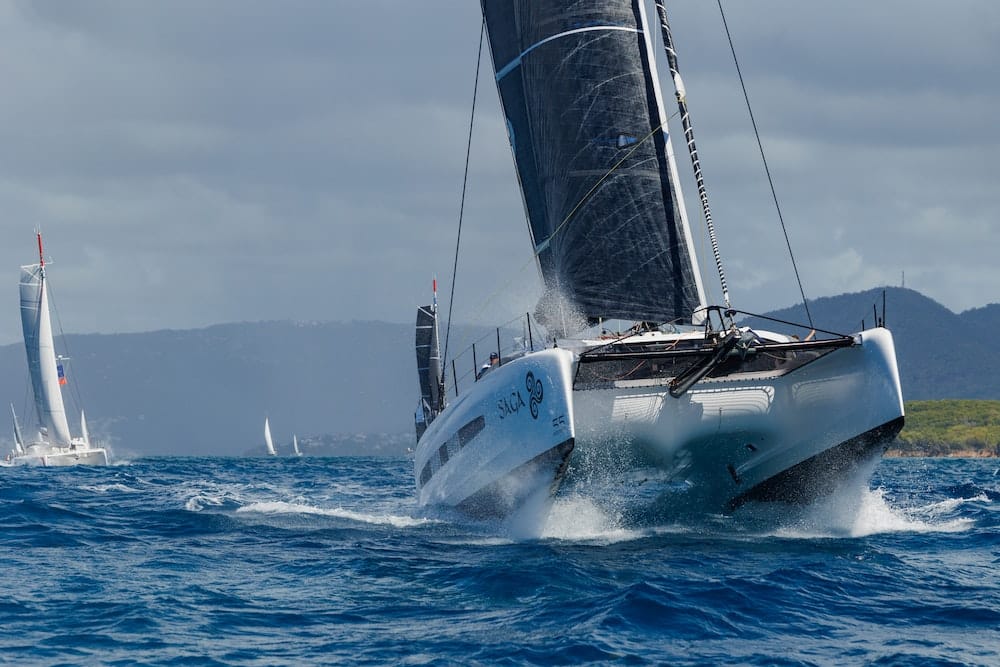
Author : Nikki Henderson
When I asked the Outremer Ladies’ community for suggestions on webinar topics, ‘Daggerboards’ was top of the list. I wasn’t surprised. I don’t think I’ve had a day out on an Outremer with prospective or current owners where daggerboards were not discussed.
It makes sense that there is a curiosity about daggerboards; using them properly is essential if you want your Outremer to perform. What is interesting though, is how confusing people find them.
One thing I’ve realised is that for some people, the issue is similar to my relationship with electronics (hate) and engineering (love). Things I cannot physically see are inherently cloaked in mystery and much more challenging for me to understand. This can be the case with daggerboards: they are hidden underwater and so are often forgotten or misunderstood.
The other reason that daggerboards can be confusing is that they affect not just the performance of a catamaran, but also the safety. Sometimes the theories contradict each other and lead to conflicting advice as to the right and wrong way to use them. In fact, there is no one ‘rule’ about daggerboards. The key, as with anything on a boat, is to understand the reasoning behind the basic daggerboard practices, so that you can make your own decision based on your own unique circumstances that you encounter at any particular time.
I hope this blog will help you build this critical foundation of understanding so that you can set sail safely and with confidence. Daggerboards – like sail trim – is a subject of continual learning. See this as step 1 in the life-long journey.
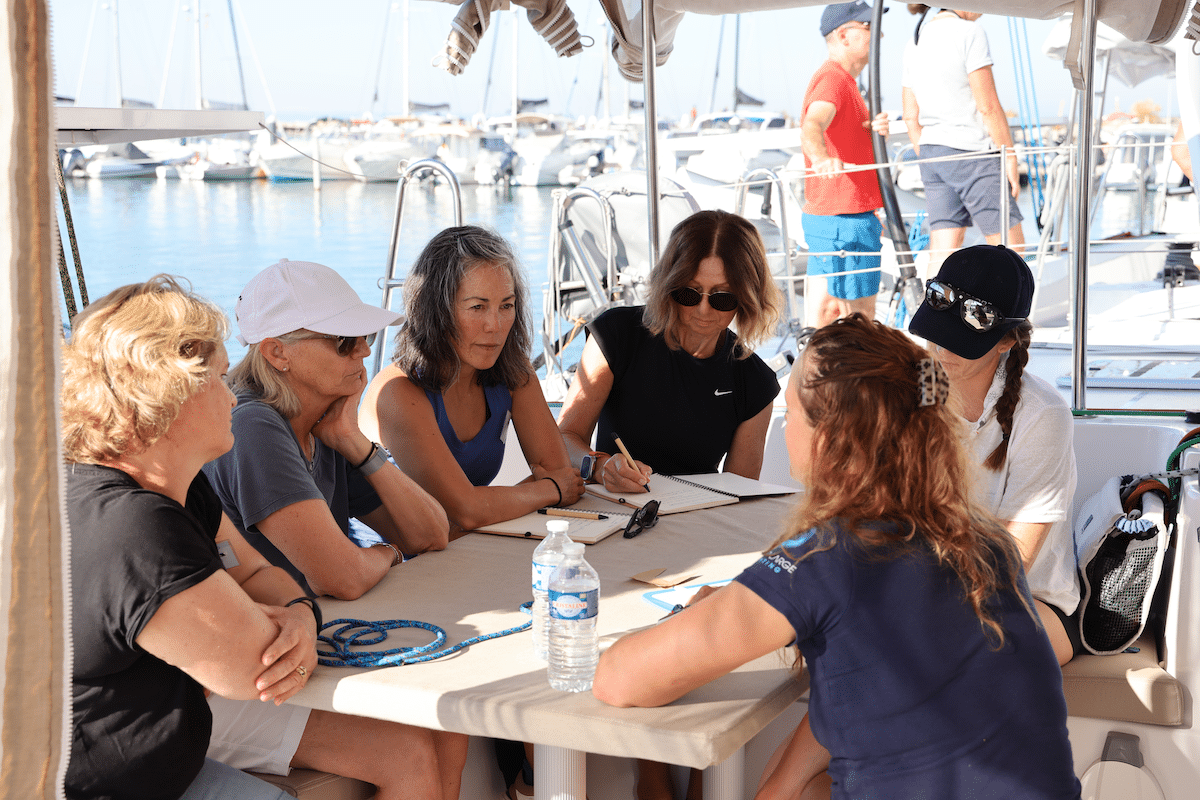
Catamaran daggerboards: how should they be adjusted for optimum sailing?
Daggerboards are best thought of as an ‘underwater sail’ – sometimes called a ‘foil’. Just as a sail above the water needs trimming – so does the sail under the water. But unlike the sail above the water, the daggerboard only has one trim option: how much of it is exposed below the hull.
When sailing upwind the daggerboards provide resistance and lift under the water to balance out the sideways effort force from the sail above the water. In more simple terms, daggerboards help the boat move forward rather than sideways when sailing upwind. Therefore, when sailing upwind, the assumed best practice is to have the daggerboards down. [UP-wind = DOWN-board]
When sailing downwind, the effort force from the sail works almost entirely in the direction you need the boat to go. Therefore, you do not need the resistance under the water from the daggerboard to help with the direction. In fact, it will probably hinder you from sailing deep downwind and slow you down. Therefore, when sailing downwind, the assumed best practice is to have the daggerboards up. [DOWN-wind = UP-board]
Generally, when sailing with wind on the beam – a good ‘go-to’ trim set up is one that is somewhere in the middle of downwind and upwind trim. Therefore, a good starting point for a beam reach would be to lift the daggerboards half-way up.
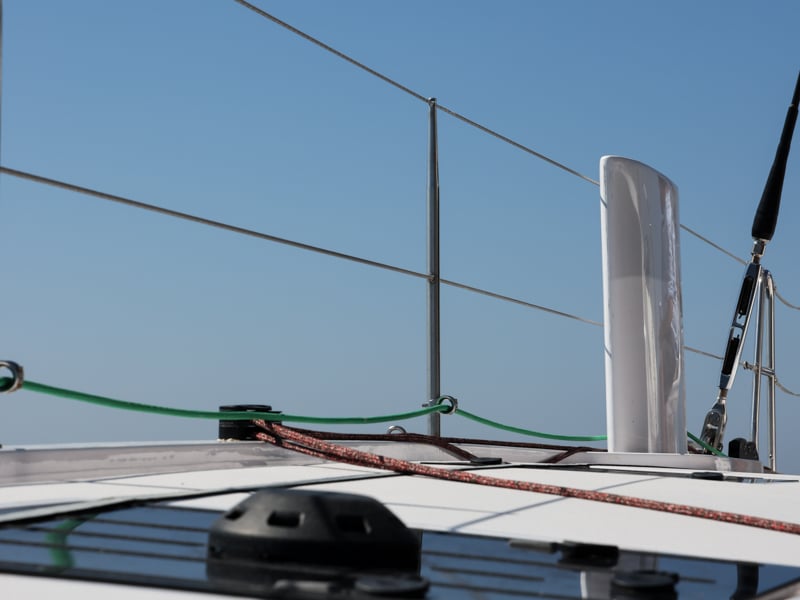
Which catamaran daggerboard for which sailing conditions?
For any competent dinghy sailors who understand daggerboards, this is the most common question as they are typically used to using only one!
An important key principle, is that a daggerboard is only effective when it is submerged in the water. Therefore, if you were sailing the boat purely for performance in a flat sea, you would always need to be trimming at least the leeward one. If the windward hull lifts slightly here and there (which it does fractionally in any substantial wind) then the windward daggerboard is not working efficiently.
Do you drop the windward board? In relation to performance, this depends on how much underwater resistance you need.
In very light winds, the standard practice is to lift the windward daggerboard all the way and only trim the leeward board. When both daggerboards are down, (for simplicity) there is now double the ‘underwater sail’ area. This would likely imbalance how much power there is from the light winds on the sail above the water, and literally ‘drag’ the boat and slow her down.
As the winds increase, there may be a time where you feel you want more underwater resistance, and you could consider lowering the windward board as well. You might find your course over ground improves. Then it was a good decision. If your speed decreases, it might be creating too much drag and you should lift it back up.
If the wind continues to increase further, it is likely you will choose to reef the main. If we return to the concept of the daggerboard being the ‘underwater sail’, if you reef the main, then consider reefing the daggerboard and lifting some up slightly with each reef you put in upwind to keep the boat balanced.
You may be wondering how such a tiny thing as a daggerboard could balance out the enormous sail area of a main sail. The answer here is that water is a much denser fluid than air, and so the daggerboard needs much less area to create the same force than it would do if it were in air.
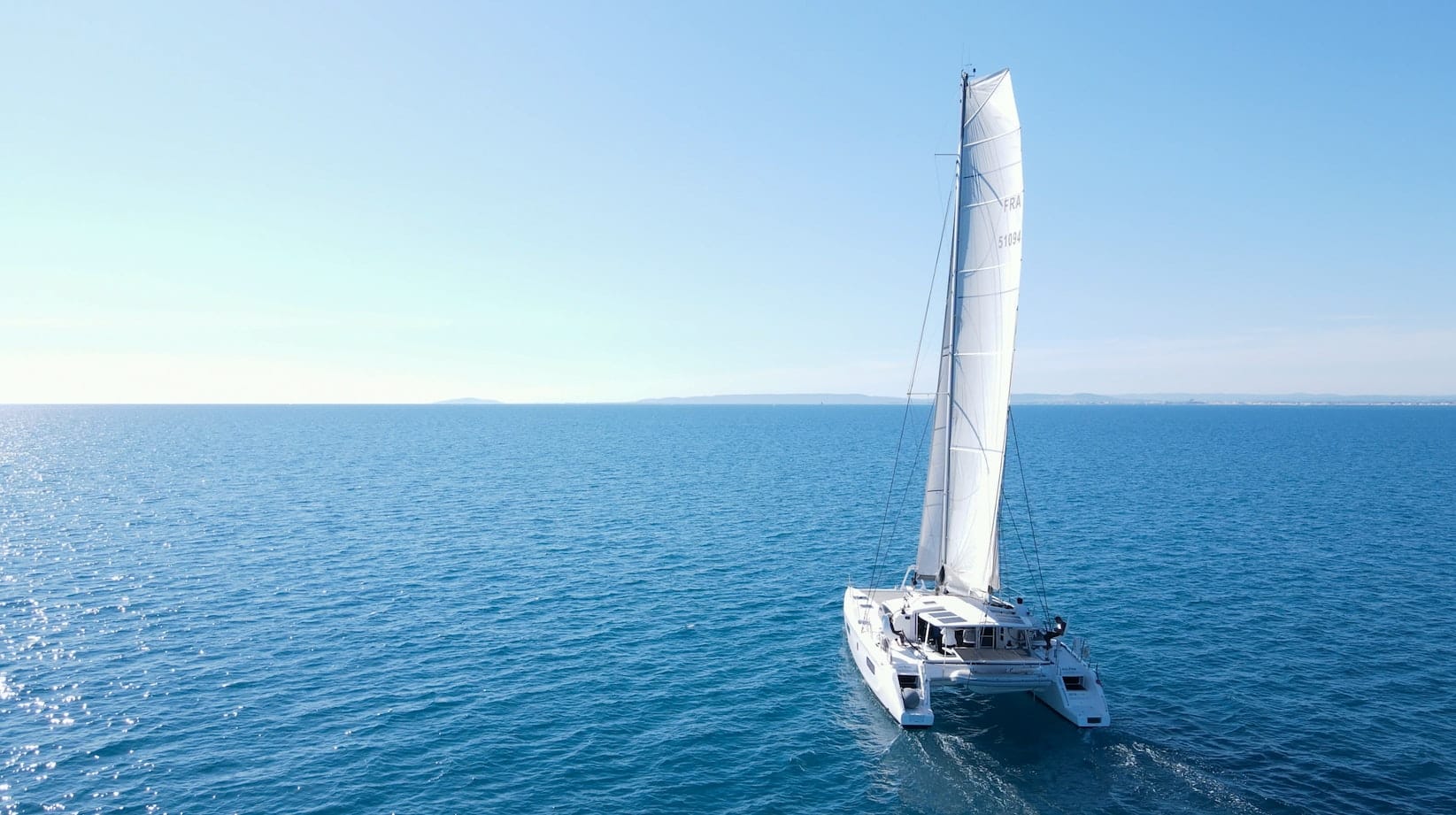
Safety at sea: adjusting daggerboards to avoid risks
This is where things start to get a little confusing.
The leeward daggerboard being down will increase the risk of ‘tripping up’. Therefore, in any significant sea state – or possible impending increase in wind/seastate such as if you are close to a mountainous shore line – where you feel that the hull is, or may, lift a lot, it is in fact safer to lift the leeward daggerboard and only use the windward one. Be aware that you will see a drop in performance as this contradicts the performance best practice of trimming the leeward board and not the windward.
The safest option entirely in very large sea states where the sea is actually tilting the boat significantly from side to side as she rolls down waves is to lift both daggerboards, so you float along waves like a raft.
‘Tripping up’ is a phrase used a lot and in fact sometimes misunderstood. To explain what it means: if there is wind/waves coming from the side of the boat and the windward hull lifts slightly in a wave, or there is a gust and the sail powers the boat forward – the leeward hull can ‘dig in’ to a wave and trip the boat up. The best way to imagine this is imagine getting one of your shoelaces on one of your feet stuck but the rest of your body is still walking. You will fall over. Same with the boat.
A converse argument to lifting the daggerboards up, is that dropping both of them will protect the underside of the boat – from grounding, or from hitting a submerged object. Having both daggerboards partially down can protect the propellor. Having them at ‘deck level’ can protect the rudder. In other words, if you hit something then it will hit the daggerboard before the more fragile underwater equipment.
Another argument against lifting the daggerboards entirely, is that with no daggerboards, your rudder is doing all the ‘resistance-work’. It is hard to believe, but it also acts as a very tiny underwater sail too. There will be a huge load on the rudder with no daggerboard at all and this risk is probably not worth the gain in speed on a long downwind ocean crossing. One way to spot if the rudder is working too hard is just look at your autopilot rudder angle – if it’s maxing out and having to work very hard to keep the boat going straight then you probably have too much sideways slip. It’s a bit like the boat is sailing on an ice rink. In that case, I’d recommend putting both of them down a touch. This will benefit both the ruder and the autopilot (therefore power consumption).
(Read our Safe Sailing article to learn more about safety on board)
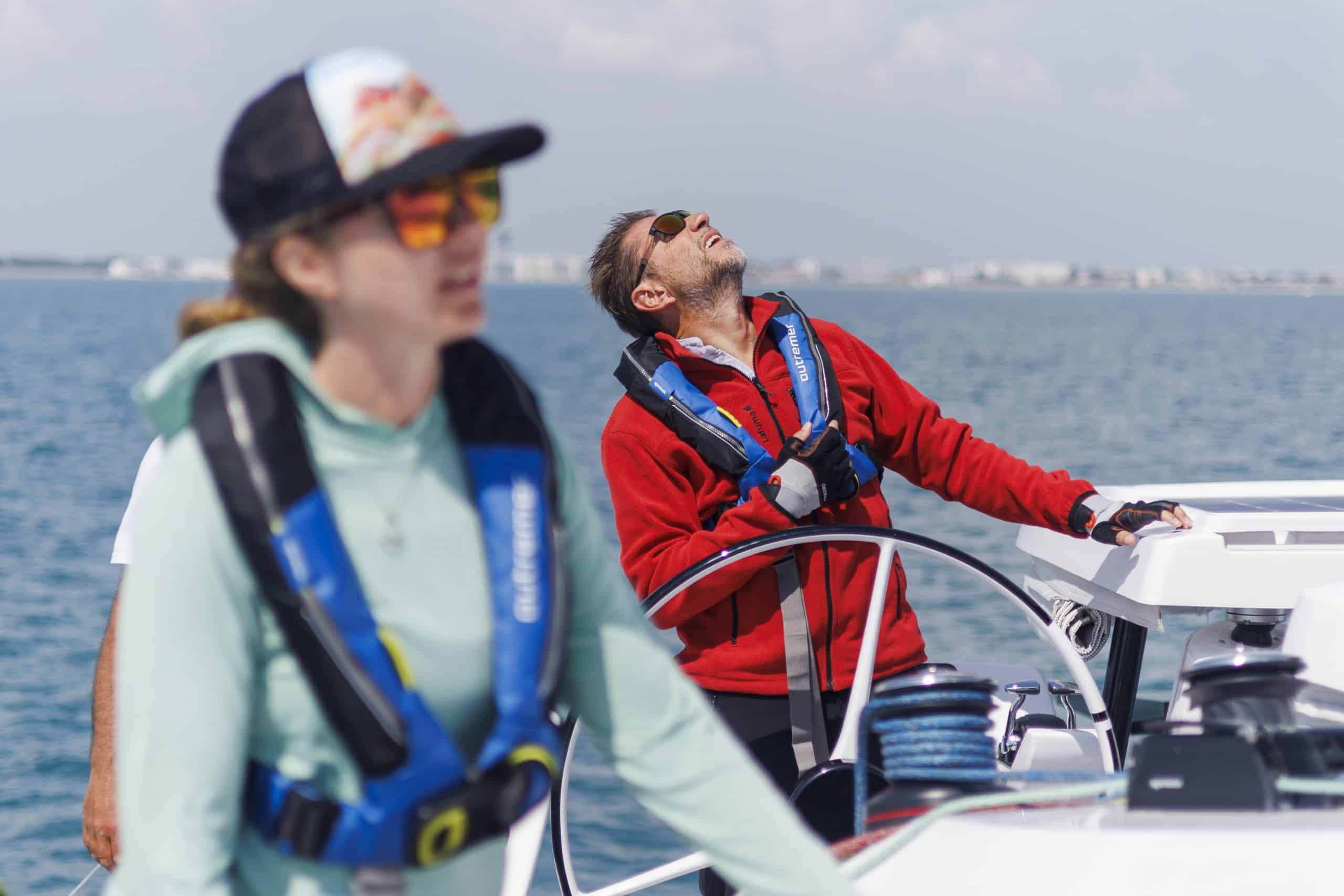
Using daggerboards is a balancing act! Boat weight, weight distribution, sail area, wind strength, sea state, sail trim are all things that effect the decision for how to use the daggerboards: how much daggerboard to use and which one (or both) to use. This is why it’s not an exact ‘one size fits all’ rule and anyone who tells you so is probably oversimplifying it which could lead to a dangerous sitaution. But start using them and see how the boat feels. The beauty of buying an Outremer is that if you keep her lightweight and trimmed well, then she will talk to you and tell you what feels good. Don’t believe me? Try sailing a brand-new Outremer out of the factory before she has anything on – then compare it to one with four peoples’ life belongings on – and you will see what I mean. 😉
Continue navigation
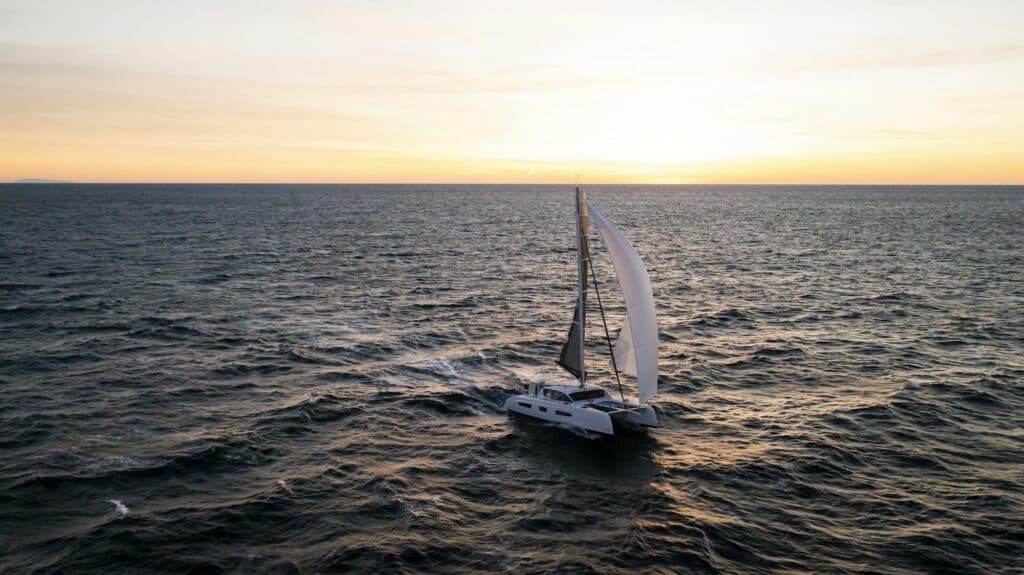
Why sail around the world in a catamaran rather than a monohull?
Sailing around the world is a dream come true: you discover the world to the rhythm of the wind and the stopovers, exploring new destinations every day as you sail. If you’re just starting to read this article, you’re probably nurturing this project. Are you planning to sail around the globe? Then the choice of ship for your next voyage is crucial.

The Importance of Defining Success
In the Autumn of 2023, I ran a ‘Webinars for Women’ mini-series on transatlantic preparations. The first session was titled: “How to approach transatlantic preparation.” As I zoomed out of the nitty gritty of canned food recipes, spare parts inventories, and preventative sail repair and took a broader look at the framework for a successful crossing, I homed in on what I think the first and most important step is: defining your goal.

Sailing in the Bahamas : unforgettable stopovers
The Bahamas Islands are a dream destination to explore under sail! In the heart of the Caribbean Sea, the archipelago offers the chance to enjoy sailing through splendid scenery, pleasant places to stop off and memorable activities. In this article, the Outremer team tells you what they consider to be the essential stages of a catamaran cruise in the Bahamas.

What Are Daggerboards on a Catamaran? (An In-Depth Look)
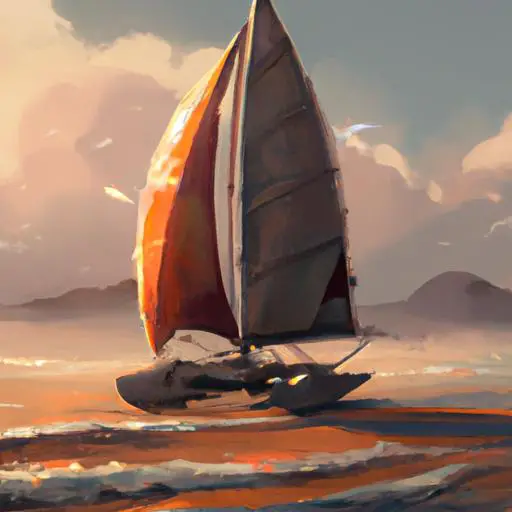
Have you ever wondered how catamarans move so fast and efficiently through the water? The answer lies in daggerboards, a unique and essential feature of these vessels.
Many sailors consider daggerboards to be one of the key advantages of sailing on a catamaran over a monohull sailboat.
If you’re curious to learn more about the science behind this nautical feature, then this article is for you.
Here, we’ll dive into the details of what daggerboards are, how they work, the benefits they offer, the types of daggerboards, and the best practices for maintenance and performance.
By the end, you’ll be an expert on the topic and be able to make an informed decision about the best type of daggerboard for your vessel.
Table of Contents
Short Answer
Daggerboards are vertical boards on a catamaran that can be raised and lowered to provide lateral resistance and stability to the boat.
When the daggerboards are lowered, they provide more stability and can help the catamaran sail closer to the wind.
When they are raised, the catamaran has less resistance and can move faster.
Daggerboards are an important part of a catamaran’s design, as they provide stability and control in difficult weather conditions.
What Are Daggerboards?
Daggerboards are a vertical fin-like structure found on a catamaran, which is a type of sailboat with two hulls of equal size.
Daggerboards are typically located on the centerline of the boat and can be raised and lowered at the skipper’s discretion.
This allows the skipper to adjust the center of effort on the boat, which in turn affects the boat’s maneuverability and control.
At the most basic level, daggerboards provide additional lift and stability to a catamaran, allowing for improved performance in light winds.
They work by creating forward thrust and lift, helping the boat move through the water more efficiently and allowing it to make tighter turns.
Daggerboards also help to reduce leeway, which is the tendency of a boat to drift sideways in the water due to the wind pushing against its sails.
By positioning the daggerboard at an angle, the skipper can reduce the amount of leeway the boat experiences, allowing it to maintain a more consistent course.
Overall, daggerboards are a key component of sailing catamarans and can have a significant impact on the performance of the boat.
With the right setup, they can make a boat faster, more maneuverable, and easier to control in a variety of conditions.
For sailors looking to get the most out of their catamaran, understanding how to use daggerboards is essential.
How Daggerboards Work

Daggerboards, also known as centerboards, are a vertical fin-like structure found on a catamaran.
They are typically located on the centerline of the boat and can be raised and lowered at the skippers discretion.
Daggerboards are designed to provide the catamaran with additional lift and stability in light wind conditions.
This helps to improve the performance of the catamaran by adjusting the center of effort on the boat, allowing for greater maneuverability and control.
When the daggerboards are lowered, they act as an underwater keel, providing additional stability and lift.
This helps the catamaran to cut through the water more efficiently, allowing it to move faster and with greater control.
The daggerboards also help to prevent the boat from drifting sideways in the wind, which can be a common issue with monohulls.
The daggerboards also help to reduce the amount of heeling (leaning) experienced when sailing upwind, making the sailing experience more comfortable and enjoyable.
When the daggerboards are raised, the catamaran will be more maneuverable and have improved performance in light wind conditions.
This is due to the reduced drag caused by the daggerboards not being in the water.
The raised daggerboards will also help to reduce the amount of heeling experienced when sailing downwind, making the sailing experience more comfortable and enjoyable.
The use of daggerboards can significantly improve the performance of a catamaran in light wind conditions and is a key component of sailing catamarans.
By raising and lowering the daggerboards, the skipper can adjust the center of effort on the boat, allowing for greater maneuverability and control.
The Benefits of Daggerboards
Daggerboards are an essential part of sailing catamarans for a number of reasons.
The most obvious benefit of having daggerboards on a catamaran is that they provide additional lift and stability, allowing for improved performance in light winds.
By raising and lowering the daggerboards, the skipper can adjust the center of effort on the boat, giving them greater control over the boat’s maneuverability.
This can be advantageous in tricky situations, such as sailing close-hauled or in tight spaces.
Additionally, daggerboards can help reduce drag in certain conditions.
By raising the daggerboards, the boat can be steered more efficiently by using the hulls to provide lift instead of the daggerboards, which can result in less drag and improved performance.
Finally, daggerboards can help improve the safety of a catamaran.
In rough seas, daggerboards can provide additional stability, helping to keep the boat upright and preventing it from capsizing or being damaged.
This can be especially beneficial when sailing in unfamiliar waters or in bad weather conditions.
In summary, daggerboards are an invaluable component of sailing catamarans.
They provide added lift and stability, can be used to adjust the center of effort on the boat, reduce drag, and improve the safety of the boat.
With all these features, it’s no wonder that daggerboards are a must-have for any serious catamaran sailor.
Types of Daggerboards

When it comes to daggerboards, there are two main types that can be found on a catamaran: retractable and fixed. Retractable daggerboards are typically made of fiberglass and can be raised and lowered at the skipper’s discretion. This allows the skipper to adjust the center of effort of the boat, providing improved maneuverability and control. Fixed daggerboards are usually made of wood or metal and are permanently mounted in the centerline of the boat. These boards provide an extra layer of stability and lift to the catamaran, allowing it to perform better in light winds.
In addition to the two main types of daggerboards, there are also some other variations that can be found on some catamarans.
A daggerboard trunk is a type of daggerboard that is mounted inside the hull of the boat.
This allows the daggerboard to be raised and lowered without having to be removed from the boat.
A foil daggerboard is a type of retractable daggerboard that is designed to provide additional lift and stability to the catamaran, allowing it to perform better in heavier winds.
There are also battened daggerboards, which are a type of fixed daggerboard that is designed to provide additional lift and stability to the catamaran.
No matter which type of daggerboard is chosen, they all provide additional lift and stability to a catamaran, allowing it to perform better in different wind conditions.
By understanding the different types of daggerboards and how they can improve a catamaran’s performance, skippers can make the most of their sailing experience.
Daggerboard Maintenance
Daggerboard maintenance is an important aspect of owning and sailing a catamaran.
It is important to keep the boards in good condition to ensure they are performing as efficiently as possible.
This means periodically checking the boards for wear and tear, making sure they are properly lubricated and free of debris, and ensuring that the fastenings and connections are secure.
Regularly inspecting the boards for signs of corrosion or damage is also important.
If damage is found, it should be addressed immediately to prevent further damage and to ensure that the boards are performing as efficiently as possible.
In addition to inspecting the boards, it is important to keep them lubricated to ensure smooth and efficient performance.
The best way to do this is by regularly applying a lubricant specifically designed for marine use.
This will help reduce friction and keep the boards in good condition for longer.
It is also important to keep the fastenings and connections of the boards secure.
This includes the bolts that attach the boards to the frame, as well as the pins and clips that hold the boards in place.
It is important to inspect these regularly for signs of wear and tear, and to replace them if necessary.
Finally, it is important to keep the boards free of debris or dirt.
This can be done by regularly rinsing the boards off with fresh water after sailing, and by using a soft brush to remove any dirt or debris that has accumulated.
By following these simple maintenance tips, you can ensure that your daggerboards are performing as efficiently as possible and that your catamaran is sailing to its full potential.
Daggerboard Upgrades

The daggerboard is a key feature on catamarans, as it provides lift and stability to the boat.
It is located on the centerline of the boat and can be raised and lowered at the skipper’s discretion.
This allows the skipper to adjust the center of effort on the boat, enabling greater maneuverability and control.
For those looking to maximize the performance of their catamaran, there are several upgrades available for the daggerboard.
A taller daggerboard can be installed to increase the lift and reduce drag, while a lower profile board can provide improved stability.
Additionally, a carbon fiber board can be used to reduce weight, further increasing the overall performance of the boat.
Another upgrade is the addition of a daggerboard trim tab, which allows for more precise control of the daggerboard.
This is especially useful in light winds, as it allows the skipper to adjust the daggerboard to maintain the optimum angle of attack.
This can significantly improve the performance of the boat in light winds.
Finally, there are a variety of shapes available for the daggerboard.
Different shapes are designed to optimize the performance of the boat in different conditions, so it is important to select the shape that best suits your needs.
In conclusion, daggerboards are a key component of sailing catamarans and can have a significant impact on the performance of the boat.
By upgrading the daggerboard, skippers can maximize the performance of their catamaran and improve its overall maneuverability and control.
Daggerboard Performance
When it comes to sailing performance, daggerboards can have a significant impact on a catamaran.
When the daggerboards are up, the center of effort is lowered, allowing the catamaran to sail in light winds with better speed and efficiency.
When the daggerboards are down, they provide additional lift and stability, allowing for improved performance in heavier winds.
The shape and size of the daggerboard also affects the performance of the catamaran.
A wide, shallow daggerboard will provide more lift in light winds, while a narrow, deep daggerboard will provide more stability in heavier winds.
As such, it is important to choose the right daggerboard for your catamaran to get the most out of it.
In addition to improving the performance of the boat, daggerboards can also help reduce drag when sailing upwind.
When sailing upwind, the daggerboards create a venturi effect, which helps reduce the drag on the boat.
This can make a huge difference in performance and can allow the catamaran to reach higher speeds in upwind conditions.
Finally, daggerboards can make a catamaran more responsive to steering.
When sailing downwind, the daggerboards can be used to help the boat turn more quickly and with greater precision.
In this way, the daggerboards can be used to make a catamaran more responsive and agile.
By adjusting the daggerboards, the skipper can adjust the center of effort on the boat, allowing for greater maneuverability and control.
Daggerboards can also help reduce drag when sailing upwind and make the catamaran more responsive to steering.
Final Thoughts
Daggerboards are a key component of sailing catamarans, and their presence has a significant impact on the performance of the boat.
They can provide additional lift and stability, allowing for improved performance in light winds, as well as greater maneuverability and control.
With the variety of daggerboard types, upgrades, and maintenance available, there is something for every boat and sailor.
Understanding how daggerboards work and the impact they can have on sailing performance can help you make the most of your catamaran.
So, take the time to consider the different options and see what daggerboards can do for you.
James Frami
At the age of 15, he and four other friends from his neighborhood constructed their first boat. He has been sailing for almost 30 years and has a wealth of knowledge that he wants to share with others.
Recent Posts
Does Your Boat License Expire? Here's What You Need to Know
Are you a boat owner looking to stay up-to-date on your license requirements? If so, youve come to the right place! In this article, well cover everything you need to know about boat license...
How to Put Skins on Your Boat in Sea of Thieves? (Complete Guide)
There is a unique sense of pride and accomplishment when you show off a boat you customized to your exact specifications. With Sea of Thieves, you can customize your boat to make it look like your...
Catamarans with Daggerboards: Enhancing Stability and Performance
by Emma Sullivan | Aug 9, 2023 | Sailboat Lifestyle
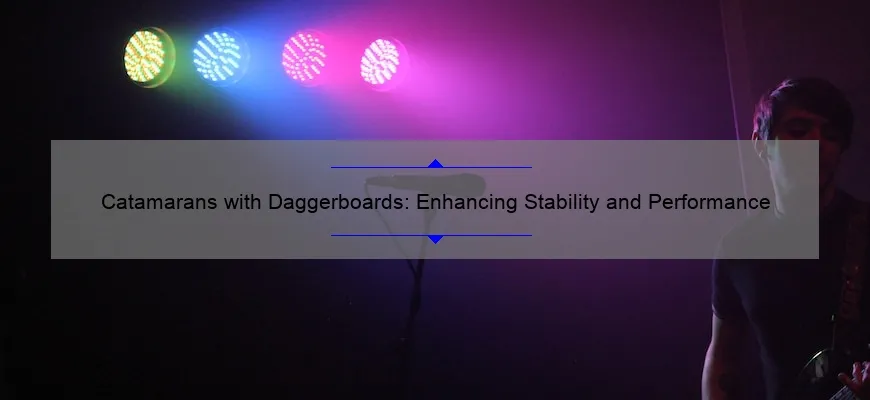
Short answer catamarans with daggerboards:
Catamarans with daggerboards are multihull sailboats consisting of two parallel hulls and vertical foils called daggerboards that can be raised or lowered. Daggerboards improve stability, reduce leeway, and increase upwind performance by minimizing side slipping. These high-performance catamarans are commonly used in racing, offshore cruising, and recreational sailing due to their enhanced speed and maneuverability capabilities.
How Catamarans with Daggerboards Enhance Sailing Performance
If you’re a sailing enthusiast, you may have heard about the growing trend of catamarans equipped with daggerboards. But what exactly are daggerboards and why do they enhance the sailing performance of these unique vessels ? In this blog post, we’ll dive into the details and give you a professional, witty, and clever explanation.
First things first – let’s understand what a catamaran is. A catamaran is a multi-hulled vessel consisting of two parallel hulls connected by a deck structure. Unlike traditional monohulls, catamarans offer increased stability due to their wider beam. This stability means more balance when sailing through choppy waters or in heavy winds . However, even with their inherent stability advantage, there’s always room for improvement when it comes to performance.
This is where daggerboards come into play. Daggerboards are vertically retractable underwater fins that can be found on both sides of a catamaran’s hulls. These boards mimic the functions of centerboards or keels found in monohulls, but with some key differences .
Unlike fixed structures on monohulls, daggerboards can be raised or lowered based on different wind and sea conditions. And trust us – this simple mechanism makes all the difference in terms of performance! By adjusting the depth at which the daggerboard extends below the waterline, sailors can optimize the flow of water around their vessel.
When cruising downwind or in lighter winds, raising the daggerboard allows for shallow draught navigation while minimizing drag created by unnecessary underwater surface area. On the other hand, when sailing upwind or encountering stronger gusts, lowering the boards increases lateral resistance and prevents sideways slippage known as leeway.
Essentially, daggerboards function as hydrofoils for catamarans . They create lift by exploiting Bernoulli’s principle – faster-moving air above generates lower pressure compared to slower-moving air below an object’s surface (or in this case, water). This lift effect counteracts the forces acting on the hulls and reduces slippage, thus improving both speed and control.
But let’s not forget about the clever engineering behind daggerboards. These modern-day marvels are crafted from lightweight yet durable materials such as carbon fiber or fiberglass, ensuring optimum strength-to-weight ratios while keeping performance at its peak. The adjustable nature of daggerboards also comes into play during maneuvers like tacking or gybing, making it easier for sailors to change direction smoothly without losing precious momentum.
So why should you care about catamarans with daggerboards? Simple – they offer a thrilling sailing experience with enhanced performance capabilities. Whether you’re seeking the adrenaline rush of competitive racing or just looking for a smooth cruise across open waters, these vessels provide unbeatable stability and speed that can take your sailing game to new heights.
In conclusion, catamarans equipped with daggerboards have revolutionized the world of sailing by maximizing performance through clever hydrodynamics and adjustability. So if you’re ready to enhance your sailing adventures with a touch of finesse and innovation, hop aboard a catamaran with daggerboards and prepare to ride the waves like never before!
Exploring the Benefits of Catamarans with Daggerboards Step by Step
Title: Exploring the Benefits of Catamarans with Daggerboards Step by Step
Introduction: Catamarans have gained widespread popularity in recent years due to their stability, speed, and spaciousness. One key element that maximizes the performance of catamarans is the presence of daggerboards . In this blog post, we will delve into the benefits of catamarans equipped with daggerboards, exploring each step involved. From improved sailing capabilities to enhanced comfort , let’s discover the remarkable advantages these sleek vessels offer.
Step 1: Understanding Daggerboards in Catamarans Daggerboards are vertically retractable appendages mounted on both hulls of a catamaran. Serving as underwater wings, they can be lowered or raised depending on sailing conditions. When deployed, daggerboards greatly contribute to a sailboat ‘s lateral resistance and stability.
Step 2: Heightened Stability at Sea One prominent advantage of catamarans with daggerboards lies in their exceptional stability. The wide beam between two hulls minimizes rolling motion even under rough sea conditions, offering an incomparable sense of security for those prone to seasickness or seeking a more comfortable cruising experience.
Step 3: Superior Upwind Performance Daggerboards revolutionize a catamaran’s ability to sail upwind effectively. By lowering both daggerboards symmetrically, the wetted surface area decreases, reducing drag significantly while maintaining lateral resistance. This enables catamarans with daggerboards to venture closer to windward than traditional keel-powered boats – an invaluable feature for sailors navigating challenging coastal or offshore routes.
Step 4: Enhancing Maneuverability When maneuvering close to shorelines or marinas, daggerboards provide heightened control and agility. Their adjustable nature allows sailors to alter their angle or completely retract them into the hulls when additional clearance is required – ensuring simple navigation through shallow waters or tight spaces where other vessels may struggle.
Step 5: Increased Speed Potential The presence of daggerboards in catamarans grants them superior speed capabilities, especially in reaching conditions. With reduced drag and improved stability, these formidable vessels can easily harness the power of the wind, gliding swiftly across open waters . Daggerboards enable a catamaran to maintain higher average speeds throughout long passages, ensuring quicker and more enjoyable journeys.
Step 6: Enhanced Safety Catamarans equipped with daggerboards boast enhanced safety features that make them an ideal choice for offshore cruising or adventurous sailing trips. By allowing sailors to control their draft depending on the sea state or desired performance, daggerboards minimize the risk of grounding or collisions with underwater hazards. This versatility enhances overall onboard safety and peace of mind.
Conclusion: Daggerboards are not merely another feature found in high-performance sailing vessels; rather, they revolutionize the way catamarans navigate through various conditions. From heightened stability at sea to improved maneuverability and increased speed potential, these retractable appendages offer unparalleled benefits for enthusiasts seeking comfort, agility, and thrilling experiences on the water . Next time you embark on a catamaran adventure, keep an eye out for those sleek daggerboards that make every voyage a remarkable one!
Frequently Asked Questions about Catamarans with Daggerboards
Are you considering purchasing a catamaran with daggerboards but find yourself overwhelmed with questions? Fear not! We have compiled a comprehensive list of frequently asked questions about catamarans equipped with daggerboards to quench your curiosity. From the advantages they offer to common misconceptions, we’ve got you covered. Join us as we delve into this intriguing topic.
1. What is a catamaran with daggerboards?
A catamaran with daggerboards is a type of sailing vessel that features two hulls connected by a platform known as the bridge deck. Unlike traditional catamarans, these innovative vessels are equipped with retractable keels called daggerboards which can be adjusted based on sailing conditions.
2. Why choose a catamaran with daggerboards over other designs?
Catamarans with daggerboards offer numerous advantages for avid sailors. Firstly, their ability to retract or extend the boards allows for enhanced maneuverability and increased speed in different weather conditions . This means greater control when sailing upwind or in shallow waters where other boat types might struggle.
3. How do daggerboards affect performance?
Daggerboards significantly improve sailing performance by reducing sideways drift (known as leeway) and increasing the lateral resistance provided by the keels. By adjusting their position according to wind direction, sailors can optimize their boat’s angle against prevailing forces and achieve higher speeds.
4. Do I need any special skills to handle a catamaran with daggerboards?
While operating any sailboat requires some level of skill and experience, handling a catamaran with daggerboards doesn’t demand extraordinary expertise. As long as you possess basic sailing knowledge and understand how to utilize the adjustable keels effectively, you’ll be able to harness the full potential of these vessels easily.
5. Are there any drawbacks to using daggerboards?
Although the advantages of using daggerboards significantly outweigh potential downsides, there are some considerations worth mentioning. Catamarans equipped with daggerboards may have a higher initial cost compared to other designs due to their specialized construction. Additionally, maintenance and repairs for the daggerboard mechanisms might require more attention.
6. Can I still sail a catamaran with daggerboards in shallow waters?
Absolutely! The retractable nature of daggerboards enables catamarans to navigate shallow waters with ease. By lifting the boards, you can safely venture into areas where conventional keels would prohibit passage, opening up new possibilities for exploration while maintaining stability.
7. Are catamarans with daggerboards faster than those without?
The adjustable nature of daggerboards does provide potential for increased speed, particularly when sailing close to the wind or upwind . The reduced drag caused by retracted boards allows these vessels to efficiently glide through the water, resulting in impressive acceleration and velocity that can outperform traditional catamarans.
8. Are there any misconceptions surrounding catamarans with daggerboards?
Indeed, a common misconception is that daggerboards are solely beneficial for racing purposes or experienced sailors seeking high-performance vessels . However, these boats are equally suitable for cruising enthusiasts looking to enjoy enhanced control, stability, and overall comfort during their nautical adventures.
In conclusion, choosing a catamaran with retractable daggerboards offers an innovative approach to sailing characterized by improved performance and adaptability across various conditions. Novice or seasoned sailors alike can make the most of these unique vessels while exploring shallow waters or harnessing greater speed capabilities. So set sail confidently on your next maritime adventure armed with knowledge about these fascinating catamarans!
Understanding the Mechanics Behind Catamarans with Daggerboards
When it comes to sailing, catamarans have gained considerable popularity due to their stability and speed. But what sets these sleek vessels apart from traditional monohull sailboats ? The answer lies in their unique design, particularly the incorporation of daggerboards. In this blog post, we will dive deep into understanding the mechanics behind catamarans with daggerboards, shedding light on why they are favored by sailors all over the world.
To begin with, let’s familiarize ourselves with the fundamental concept of a catamaran. Unlike monohulls that have a single hull cutting through the water, catamarans boast two parallel hulls connected by a platform or bridge called the trampoline. This setup enhances stability and prevents excessive rolling, making them an excellent choice for those looking for a smooth and comfortable sailing experience.
However, it is worth noting that stability alone does not guarantee optimal performance . That’s where daggerboards come into play. These vertically oriented keels perform multiple functions that elevate a catamaran ‘s capabilities and maneuverability.
Firstly, let’s understand what exactly a daggerboard is. A daggerboard is essentially a retractable keel located within each hull of a catamaran. These boards are designed to slide up and down vertically through special slots or cases known as trunkings in order to adjust their depth beneath the waterline.
One of the primary roles of daggerboards is to counteract leeway – the sideways movement experienced by boats when subjected to wind pressure against their sails . By adjusting the depth of daggerboards on either side independently, sailors can effectively control leeway and sail closer to the wind without significant drifting off course.
In addition to countering leeway, these clever appendages also enhance upwind performance—a crucial aspect for competitive racing or efficient long-distance sailing . When fully deployed, daggerboards create additional lift as water flows over them at high speeds . This lift opposes the sideways force acting on the boat from the wind, allowing the catamaran to maintain a more efficient angle into the wind and achieve higher speeds.
Furthermore, daggerboards play a crucial role in preventing capsizing – an occasional nightmare for sailors. By adjusting the depth of daggerboards when facing strong gusts or turbulent sea conditions, sailors can maintain balance and stability, reducing the risk of flipping over.
It’s important to note that daggerboards are highly adjustable and require skillful handling by experienced sailors. Proper adjustment involves considering various factors like wind speed, boat speed, sea state , and desired sailing objectives. Fine-tuning these elements allows sailors to optimize performance in different conditions while keeping safety in mind.
While some catamarans utilize fixed keels or even foils instead of daggerboards, traditional daggerboard designs continue to dominate due to their simplicity, reliability, and cost-effectiveness. They offer versatility across a range of sailing styles from leisure cruising to competitive racing.
In conclusion, understanding the mechanics behind catamarans with daggerboards is essential for anyone looking to venture into this sailing realm. From countering leeway and optimizing upwind performance to enhancing stability and preventing capsizing; these retractable keels serve as invaluable tools in ensuring a safe yet exhilarating experience on the water. So next time you see a catamaran gliding effortlessly through waves with precision-like control, you’ll have an appreciation for the intricate role played by its trusty daggerboards.
Why Choosing a Catamaran with Daggerboards Can Revolutionize your Sailing Experience
Choosing a catamaran with daggerboards can completely revolutionize your sailing experience, taking it to new heights of performance and excitement. These sleek and innovative designs offer numerous advantages that will leave you wondering why you ever sailed on a traditional monohull.
Firstly, let’s talk about speed. Catamarans with daggerboards are known for their incredible acceleration and high top speeds. The combination of the streamlined hulls and adjustable daggerboards allows these vessels to slice through the water effortlessly, leaving monohulls in their wake. Imagine the thrill of gliding across the waves at exhilarating speeds, feeling the power of the wind pushing you forward – an experience that will make you truly feel alive.
But it’s not just about speed; catamarans with daggerboards also excel in upwind sailing. Due to their narrow beam and powerful sail plan, these boats can efficiently navigate against the wind , tacking smoothly without losing momentum. With each tack, you’ll notice how effortlessly the daggerboards optimize your angle towards the wind, giving you an advantage over other sailors struggling to maintain course.
One of the most significant advantages of catamarans with daggerboards is their ability to sail in shallow waters. By retracting the daggerboards partially or fully, depending on conditions, these boats can access secluded beaches, anchor closer to shorelines, or explore hidden coves inaccessible to larger vessels. The flexibility and freedom they provide allow for endless possibilities when it comes to island hopping or discovering remote destinations.
In terms of stability, nothing compares to a catamaran with daggerboards. Unlike monohulls that heel dramatically while sailing at high speeds or encountering rough seas, these two-hulled beauties remain steady as a rock thanks to their wide stance and deep-draft daggerboards. You’ll appreciate this stability when cooking onboard during passage or simply enjoying a relaxing day out on calm waters without being constantly tossed around by waves.
Furthermore, catamarans with daggerboards offer a spacious and comfortable living area. With their open, airy layouts, these vessels provide ample room for entertaining guests or accommodating a large group of family and friends on extended voyages. The absence of heeling also means there’s no longer any need to adjust your lifestyle to counteract the boat’s movement, allowing you to live onboard with ease and comfort.
Finally, catamarans with daggerboards are often praised for their low fuel consumption. Due to their lightweight construction and reduced drag caused by the daggerboards, these boats require less power to propel them through the water compared to traditional monohulls. This not only saves money but also serves as a step towards environmentally conscious sailing .
In conclusion, choosing a catamaran with daggerboards will undoubtedly revolutionize your sailing experience. From the exhilarating speed and upwind performance to the ability to navigate shallow waters effortlessly, this innovative design offers unmatched advantages that will enhance every aspect of your time on the water. Get ready to embark on an unforgettable adventure where excitement meets comfort and where possibilities become truly limitless!
Tips and Tricks for Maintaining and Caring for Catamarans with Daggerboards
Title: Mastering the Art of Catamaran Care: Unleashing the Potential of Daggerboards
Introduction: Ah, catamarans! The epitome of grace and freedom on water. These magnificent vessels offer a unique sailing experience, especially if equipped with daggerboards. These retractable appendages not only enhance performance but also require special attention when it comes to maintenance and care. Today, we are here to unveil our arsenal of professional, witty, and clever tips and tricks for maintaining and caring for catamarans with daggerboards.
1. Raise Your Daggerboard Awareness: To truly understand your catamaran ‘s daggerboards, it is crucial to comprehend their purpose and functionality. Daggerboards act as underwater foils that counteract lateral forces, providing stability and control while sailing. Take time to study their design, engage in valuable online discussions or seek guidance from experienced sailors.
2. Regular Inspection is Key: Just like any other component on your vessel, regular inspection of your daggerboards is essential. Check for wear and tear, potential damage or cracks in the boards themselves or within their housing compartments. Be thorough during inspections to nip any issues in the bud before they snowball into costly repairs or replacements.
3. Smooth Operators: Lubrication Matters! Smoothly operating daggerboards directly impact your sailing experience; squeaky boards are no one’s favorite soundtrack out at sea! Regularly lubricate the sliding mechanisms using suitable marine-grade lubricants – avoiding excessive amounts that could attract dirt or grime – ensuring silent sailing moments that will make you look like a seasoned pro.
4. The Battle Against Corrosion: Saltwater can be both a catamaran’s best friend and sworn enemy simultaneously—the latter being particularly true for metals prone to corrosion. Apply protective coatings or paints specifically designed for underwater use onto metallic portions exposed to oceanic elements surrounding your daggerboard system.
5. Float Like a Feather: Balancing Act: Balance is the key to successful catamaran navigation . Daggerboards play a significant role in maintaining equilibrium while underway. Monitor their vertical alignment carefully, ensuring they are both correctly deployed and fully retracted when needed. Avoid compromising performance by avoiding conditions that push the limits of your daggerboard’s deployment range.
6. Cleanliness above All: Just as your daggerboards slice through the water realm, they can also gather unwanted hitchhikers along the way. Regularly clean their surfaces to eliminate marine organisms, barnacles, or algae that, if left unchecked, can affect hydrodynamics and impose unnecessary drag on your vessel’s overall performance.
7. Seek Professional Guidance: When in doubt or dealing with a problem you cannot confidently resolve yourself – never hesitate to seek professional help! Experienced boat builders or naval architects can provide invaluable advice tailored specifically to your catamaran and its daggerboard configuration.
Conclusion: Catamarans equipped with daggerboards offer an exceptional sailing experience that deserves meticulous care and attention. By following these professional, witty, and clever tips for maintaining and caring for such vessels, you’ll ensure smooth operations and prolong the lifespan of your beloved catamaran with ease. So set sail confidently into endless horizons as you master the art of catamaran care – unleashing the full potential of those marvelous daggerboards!
Recent Posts

- Sailboat Gear and Equipment
- Sailboat Lifestyle
- Sailboat Maintenance
- Sailboat Racing
- Sailboat Tips and Tricks
- Sailboat Types
- Sailing Adventures
- Sailing Destinations
- Sailing Safety
- Sailing Techniques
Daggerboards
The majority of today's cruising catamarans are equipped with mini keels for reliable and hassle-free operation. There are fewer than a handful of production daggerboard catamarans, which provide the sailor slightly more pointing ability and other advantages as illustrated in previous chapters. Their operation is generally straightforward via either a single uphaul line in case the board is heavier than water, or by an additional downhaul to keep the foil lowered, in case it is more buoyant.
Needless to say, when trying to point as high as possible, the leeward board should be fully deployed. The finer the hulls of the catamaran and deeper the foils are, the more they will contribute to getting the multihull to windward. In very rough conditions, when the boat will be thrown around by wind and waves, it is a good idea to divide the loads between both boards and only let them halfway down.
Marking the daggerboards at deck level will help indicate a "control" depth and assist in judging when they will be extending deeper than the rudders and thus aid in protecing them in case of a collision.
For a more detailed description of daggerboards and their use, please refer to the "Appendages" chapter.
Continue reading here: Tacking
Was this article helpful?
Recommended Programs

Myboatplans 518 Boat Plans

Boat Alert Hull ID History Search

3D Boat Design Software Package
Related Posts
- Reefing - Catamarans Guide
- Appendages - Catamarans Guide
- Explain The Hydrodynamics Of A Daggerboard
- Catamaran Design Guide - Catamarans Guide
- Rudders - Catamarans Guide
- How Are Catamaran Masts Fixed Down
production Strider 24
plywood Romany 34
lightweight 14ft Zeta mainhull
Strike 15 trimaran at speed
28ft Skoota in British Columbia
10ft 2 sheet ply Duo dinghy
24ft Strider sailing fast
36ft Mirage open deck catamaran
- All Our Designs
- For new visitors
- About Richard Woods
- Useful Articles
- Testimonials
- Plan Updates
- Links to Owners and Suppliers
- Consultancy Service
- Boats for Sale
- Blog and Facebook Posts
- Our Cruising Blog (updated Jan 26th 2020)
- Download Eclipse logbook (300 page pdf)
- Download Newsletters 1992-2002 (pdf)
- Download Year Reviews 2002-14 (pdf)
- Download FAQs (pdf)
- Download Boat Tests (pdf)
Keels or Daggerboards, the pros and cons
When writing about foils (ie boards, keels and rudders) it is easy to baffle people by talking about lift to drag ratios, NACA sections, end plates, twist, stall, Karman vortices and all the rest. So I won't - it's probably best to leave all that to designers and hydrodynamacists Instead I'll try to help those who want to know the basics; like should they have keels or boards on their multihull?
I'm not just a multihull designer; I'm also a (home) boatbuilder and owner. Currently I own two catamarans, one with daggerboards and one with keels. Over the last 30 years I have owned five cruising catamarans with keels, nine with daggerboards and one with one centerboard. Furthermore, I am one of the few designers who has fitted LAR keels and boards to the same hull (on Strider, Sagitta and Banshee) and then sailed them against each other.
As with everything to do with yacht design, leeway prevention is a complex subject. And it is not helped by the fact that boats are not just for sailing. You load them down and treat them as a floating cottage when you live aboard them. You motor them, you dry them out (either when the tide goes out or when stored ashore in a boatyard). And you have to pay for it all.
===========================
First a bit of simple theory
The main factor determining the efficiency of a foil is its "Aspect Ratio" (AR) or the ratio of it's depth to width. I think we all know that a high aspect ratio foil is more "efficient" than one with a low aspect ratio. A 3:1 AR is generally considered ideal for rigs but is usually too high for foils. In fact a 1:1 AR is OK for keels, although 2:1 or a bit more is better. In other words, a 1.5m deep daggerboard on a 10m boat will be about 750mm fore/aft (or more properly called it's "chord"). And it will be about 75mm thick, as the thickness of a foil should be about 8-10% of the chord.
Despite the fact that high AR foils are more efficient, there are a couple of reasons for limiting AR. As the AR increases the chord decreases and so the foil becomes thinner and clearly it is then also weaker. Unfortunately the foil loads have gone up (because the deeper the foil the further the Centre of Lateral Resistance (CLR) is from the bottom of the hull, so the lever has lengthened). So long, narrow foils are more prone to damage (one reason all those monohull keels have snapped off - a J800 lost one just recently).
In addition, the higher the AR the easier it is to stall the foil. When a foil stalls it stops "working", this is most obvious after tacking in a sloppy sea and you find that the boat won't sail properly for a couple of boat lengths. That is because the foil has stalled. In other words, you have to be sailing in flat water and be a very attentive helmsman to avoid stalling a high AR foil.
The lower the AR the bigger the foils area has to be to compensate for the reduced efficiency, however a lower AR is more tolerant of shape, surface roughness and angle of attack (which basically makes it easier to sail)
So how big should a foil be? Roughly 4% of the sail area is a good starting point. Some designers use very small boards. That may be OK in theory, which says that you sail in flat water at maximum speed, but in practice I find you need a bigger board to cope with waves and slow sailing, never mind tacking in a lumpy sea.
Whilst on the dangers of too much theory. Many race boats use sophisticated shapes and low drag sections. Don't use them unless, like top racing boats, you also dry sail your boat. Only the simplest shapes work with a rough surface (even new, clean antifouling is considered rough), these fancy shapes need a smooth, ie a mirror finish, to be of benefit.
I definitely don't like asymmetric foils. True they may give a bit more lift but only one can be used at a time, the other HAS to be raised. So you are carrying around the extra weight of a second board and box plus wasting time adjusting boards after each tack which all makes it not worth the very small efficiency gain.
Many people, especially cruisers, don't mind compromising on performance if it means an easier life, more load carrying and greater protection for the rudders and propellers. And that is why Low Aspect Ratio (LAR) keels are so popular. In much the same way as monohull sailors buy a long keel boat rather than one with a fin keel.
Unfortunately, using LAR keels results in a slower boat and more pitching. That is because to optimize speed you need a hull with buoyancy in the ends, not in the middle (technically you need a high Prismatic Coefficient - Cp). Clearly adding a LAR keel adds buoyancy in exactly the wrong place. Furthermore the midships buoyancy makes the boat pitch more as the hull is more "diamond-like". Having said that the buoyancy in the keel adds to total displacement, so you can carry more gear. And you can use the keel as a water tank/shower sump or even somewhere to fit an engine.
As I have just said, a lower AR means having a bigger foil and so clearly a LAR keel has to have much more area than a daggerboard. Thus the wetted surface area (WSA) is significantly increased, especially when sailing offwind compared to a daggerboarded boat with raised boards. And WSA is the prime source of drag at low speeds. So most designers draw a compromise keel which is smaller than strictly needed to balance the sail forces. But these forces must still balance and this can only be done by having a wider sheeting angle. Which in turn means a LAR boat cannot point as high as one with daggerboards.
So all in all boats with LAR keels are slower on all points of sail and in all conditions when compared to a daggerboarded boat. Say 5deg more leeway and 2deg less pointing. Remember it is hard to tell ones real leeway from looking back at the wake as in a seaway the top 2-3ft of water is blown sideways by the wind. So unless the keel is in deep still water you don't notice that you are drifting sideways until you look at the gps.
Further Design Considerations
Boards can be daggerboards (ie adjusted vertically) or centerboards (ie adjusted by rotating). Even though centre boards sometimes fit better into the accommodation layout and can pivot aft without damage when hitting the ground, daggerboards have proven far more popular. Probably because the centerboard pivot bolt often leaks, while it is very difficult to stop the water surging in the case with the board down, and it is easier for "Stuff" to get stuck in the gap between slot and board, thus jamming the board. A centerboard box/centerboard is probably heavier than using daggerboards. And finally it is harder to remove a centerboard for painting/maintenance.
Angled boards actually take up little interior room and can always be incorporated into accommodation dividers - the nav table bulkhead on a Banshee, the hanging locker on a Sagitta, against the hull side on a Merlin for example. More important is that they then don't bang around in a sloppy sea. Providing the board is angled at under 15deg to the vertical I haven't found any disadvantage in using angled boards. Nor have I noticed any difference between boards placed on the inside of the hull and those on the outside. Certainly there is no advantage in having vertical boards fitted on the hull centerline.
Don't use central boards though the bridgedeck. They simply don't work well. The Prout brothers discovered that in 1953 when they fitted a central board on the prototype Shearwater. By 1954 they had fitted boards in the hulls. The Stiletto catamaran started with a central daggerboard but owners quickly found that converting to ones in the hulls improved performance significantly.
The bottom of a LAR keel should be horizontal, otherwise you'll dry out at angle (OK I know that in many areas boats never dry out, but you want your boat level when in a boatyard) Even worse is a keel that is too short as then the boat can fall forward or aft when people move to bow/stern. Clearly dangerous and damaging to crew and boat.
Building Considerations
Boards are heavy, and more expensive than LAR keels, there's nothing one can do about that. To save weight you can make a short board, so that when down the top of the board is below deck level. Daggerboards can be profiled over their full length. But in that case you need to make the board first, and then make the box round the board. So you need to make expensive boards early on during the build.
The alternative is to profile only the below water portion, leaving the rest rectangular. This means the box is also rectangular, so the board can be made after the box. True, there is some extra turbulence when the board is half raised, but you can negate much of that by fitting a profiled cover plate on the outer side. Also I've found that there are less chance of leaks with a rectangular box and more important, weed, twigs etc are less likely to get between board and case and jam the board.
Many people suggest building a "crash box" to absorb any grounding shock. But be warned! I made one once years ago as an experiment on a dinghy. I ran aground and the board moved back into the crash box, exactly as planned. But then jammed - not part of the plan!! I had to capsize to free the board so I could raise it. Hardly practical on a cruising catamaran!
I haven't used a crash box since, relying instead on a very heavy laminate at the back of the box. My reasoning is that the tapered trailing edge of a board is far weaker than the box and so will always fail first. I proved that when hitting an unmarked reef off Nicaragua and we lost about 300mm x 100 mm of board, yet the box itself was undamaged.
Boards are generally made in timber or foam/glass. I prefer plywood over laminated timber as it is easier to profile. Foam boards are attractive in theory, but it is very hard to stop them warping and getting the correct shape without making a mould first is almost impossible. If you do make a mould you have to join the two halves, and remember boards don't just bend they also twist.
If you can, fit LAR keels as late as possible, this keeps the boat nearer the ground during building and saves a lot of ladder climbing.
What about in use?
Unlike boards, LAR keels are very much fit and forget. So there isn't much to say about keels, except to make sure you have a good sacrificial beaching strip and keep it maintained.
It is sensible to lift the lee daggerboard when reaching, as I have found that most breakages are of the lee board as it gets very loaded at speed. However lifting both boards in a big cross sea is not a good idea as that loads the rudders and that, apart from anything else, makes it heavier to steer, so have both boards half down.
Not being able to lift the lee board for half the time is one reason why I don't like using only one board in one hull. Doing so also means the board is much bigger so there are more local loads and of course it is harder to adjust. And it doesn't seem right to have the CLR so far offline. However if you do fit one board don't fit it in the galley hull as that is always heavier than the other hull.
Lifting the lee board to allow the boat to slip sideways is commonly thought a good idea. I'm not convinced. Tank test work has shown that having a deep lee hull actually helps prevent capsizing. That is because the windward hull lifts to a breaking sea, the sea goes under the bridgedeck and hits the lee hull. Because it is deep it is pushed sideways, which dissipates any overturning energy.
People often think you need a long keel (monohull or multihull) to steer straight "hands off". That simply isn't true. Good directional stability depends on the hull balance. A properly designed daggerboarded boat will sail as straight as a LAR keel one, and have the additional benefit of being quicker to tack and maneuver when necessary.
Finally, if you run aground, you can lift the boards to get off, but remain stuck with keels.
If you don't ever expect to race then keels are OK
If you think crosscut Dacron sails are good enough then keels are OK
If you trail your boat regularly fit dagger boards
If you have wheel steering and inboard engines and expect to dry out often fit keels
If you want the best performance then fit dagger boards, but be prepared to use them
- DESIGN TOPICS
- Daggerboards vs. Fixed Keels
Daggerboards or Mini Keels for Catamarans?
Comparing fixed keels and daggerboards.
Fin keels, fixed keels, minikeels, skegs. Call them what you like, we know what you’re talking about. Choosing between fixed keels and daggerboards is probably one of the most debated options for a cruising boat and a difficult decision for a first time boat builder or purchaser. There’s no doubt high aspect ratio daggers give the optimum lift to windward and quicker tacking, but how significant is the downside of going to fixed keels, and are there significant disadvantages to living with daggerboards?
Fixed keels often get a bad rap. But it’s largely because there’s a lot of fixed keels out there that aren’t well designed. Poor section shapes and too shallow are the main problems.
Not all fixed keels are created equal, and because fixed keels by nature have a lower aspect ratio than a daggerboard, the foil section and planform (side view) selection are critical to minimise the tip loss - or the flow that runs under the keel and reduces the lift which provides windward ability. Obviously a relatively deep keel of moderate length will develop more lift than a long shallow keel, and this can be further improved by fitting an end plate to the base of the keel.
Construction Time and Cost
The dagger and dagger case combination probably take a little longer to manufacture and install and you will need to use carbon in the spar caps, but otherwise there is no significant difference in materials costs.
However for daggerboards you do need to pay particular attention to the hull to dagger case bonding areas which need to be de-cored and strongly reinforced. Also there is the additional hardware involved in the controls required for daggerboards, and a little extra deck clutter.
Asymmetric boards? These are totally inappropriate on a cruising cat in my view. With asymmetric boards the windward boards should ideally be lifted each time you tack or it will be causing drag. This means each board needs to be larger to get the same lift. An unnecessary complication for a minimal difference in performance on a cruising boat.
Building Implications
The keels are at a disadvantage here in that the building space will require 500mm or more of roof height if they are attached to the hulls at the start of the project. This also means more climbing and more scaffolding to work on the boat. One option here is to fit the keels and glass tape them to the hulls after the boat is extracted from the building space and lifted to the required height.
Performance Comparison
The difference in windward performance between fixed keels and daggerboards on cruising cats varies depending on the conditions. In very light airs the daggerboards have a clear advantage, providing reduced wetted area and greater lift at angles of attack where a large percentage of the fixed keel’s area is likely to be suffering from flow separation. The boat with a fixed keel is likely to point nearly as high as one with dagger boards, but will lose ground though increased leeway.
As the wind strength increases the fixed keels will typically operate much more efficiently and from personal experience the difference in performance between two similar cats -one with efficient fixed keels, the other with daggers - is minimal in 10 knots or more of breeze, and negligible in 15 knots and above.
The boat with the fixed keel might be expected to suffer more friction drag downwind due to increased wetted area, but once again from personal experience this disadvantage is only clearly evident in light airs.
Other Factors
Most of the cruising boats I have designed have been fitted with fixed keels - even though an option for dagger boards is provided in the plans. This is mainly because of the advantage of being able to dry the boat out on the beach with the hull bottom easily accessible for cleaning, but also for the protection the keel provides to the rudder and sail drive leg.
These factors don’t rule out dagger boards - most boats will sit on the hull bottom and the rudder without suffering damage to the rudder stock - however I do recommend that the dagger board, if fitted has a restraining strap or line which can be released to prevent the board being raised above the height of the rudder tip or sail drive leg when sailing.
Keep in mind that with fixed keels you will have less draft than a boat sailing with the boards fully down so the chance of a grounding is increased with daggers, and because the fixed keel has an angled entry profile it is less subject to damage from a sudden collision. Dagger boards take very high loadings and cedar and glass construction is generally more forgiving than amateur composite construction.
Daggerboards can be noisy inside the case, both when raised or lowered. This problem can be minimised with soft bearings at the top and bottom inside the case (synthetic grass or carpet) but is not always easy to completely avoid.
On a boat any bigger than about ten or eleven metres the daggerboards are a big chunk of stuff and can be difficult to raise and remove from the boat for maintenance.
We sometimes hear the argument that fixed keels could cause the boat to trip and capsize sideways in a sea. In steep seas you're most likely to be running (possibly with a drogue) or laying to a sea anchor.
I've never heard of a cat tripping sideways over its' keels but please enlighten me if this has been the case.
Making the Decision
I generally recommend that daggerboards are a worthwhile investment if the owner has a preference for sailing to windward rather than motoring or waiting for a favourable breeze, and if the boat is going to be kept light enough to have a power to weight ratio that will do justice to the dagger board configuration.
As a rough guide I would suggest that a 40’ cat which had a sailing weight of six tonnes or less would benefit from dagger boards, while a relatively heavy cruising cat would gain very little benefit from the more efficient foils. On a 50’ cat the cut off point is probably about 10.5 to 11 tonnes.
Dagger boards should be at least partially raised when reaching at high speed, and the need to raise and lower the board at various times is an added complication that a lot of cruising people would prefer not to have.
Daggerboards do break from time to time. Until now I have not heard of a cat having a structural problem with fixed keels, except for one that was washed sideways across a coral reef and then mercilessly pounded by waves. In that case the keels may have provided some additional safety.
Generally speaking cruising cats with fixed keels are probably easier to resell than cats with daggerboards. If you’re finding it difficult to make the decision and you're not interested in racing then it’s likely that fixed keels are right for you.
Join the Newsletter

- Scroll to top

9 Best Cruising Catamarans With Daggerboards or Centerboards!
As an Amazon Associate, we earn from qualifying purchases. We may also earn commissions if you purchase products from other retailers after clicking on a link from our site.
Many sailing enthusiasts shopping for their first cruising catamaran might find it rather challenging to determine the best choice for their needs. If you’re in the market for a cruising catamaran with a daggerboard, then look no further. I have done the research and built a list of nine of the best daggerboard catamarans.
The best cruising catamarans with daggerboards or centerboards provide great cruising capability, comfortable living, ease of handling, and strong construction. Based on different styles, designs, sizes, and prices, some of the best catamarans are Outremer 45, Catana 50, and Balance 526.
If catamaran cruising is a passion you have been longing to pursue, keep reading. You might find your dream boat and become inspired to make your cruising vacation a reality.
Dagger/Centerboards and Their Role in Catamaran Sailing
Unlike a traditional sailboat with a single hull (monohull), a catamaran balances on two hulls, with the sails sitting in the middle. Some catamarans come equipped with daggerboards (or centerboards) whose work is to balance the force of the wind acting on the sails.
Understanding the difference between centerboards and daggerboards can help you make an informed decision when selecting a sailboat or when considering modifications to your current vessel.
If you’re sailing a catamaran with daggerboards, you’d raise the daggerboard on the leeward hull while fully extending the upwind daggerboard. This improves the catamaran’s stability when sailing windward during heavy conditions. The adjustment thus makes the boat less susceptible to capsizing.
When will a catamaran capsize?
Should You Choose a Catamaran With Daggerboards?
In general, catamarans with daggerboards perform far, much better than those without. That’s because the boat’s design focuses heavily on performance. What’s more, renowned experts design the boats with the best hulls and make the boats lighter by tweaking the materials used.
In general, catamarans with daggerboards perform far, much better than those without.
So, if you’re looking to reach speeds of 28 all the way up to 30 knots (55 km/h), then choose a cruising catamaran equipped with daggerboards. When sailing upwind, such catamarans sail much closer to the wind and are way faster than their comfort-focused counterparts. In comparison, most traditional cruising boats can only manage 10-15 knots (18-27 km/h).
What makes the catamaran so fast, and why is this type of boat even faster?
- You can cover much longer distances in a day with a daggerboard catamaran.
- Their high speed allows for faster ocean crossings.
- They deliver superior performance, particularly in upwind directions.
- You can anchor your catamaran on shallow waters – after raising the boards.
- A faster cruiser means additional safety since you can outrun a storm or avoid an incoming one.
- They entail more work and maintenance.
- They require you to learn how to operate them safely.
- They are expensive – daggerboards come with an additional amount of up to $30.000 on the construction price.
- The daggerboard compartment consumes some of the space from the hull’s living area, thus limiting your comfort.
Now, let’s have a look at some of the best cruising catamarans with daggerboards.
The Dolphin Ocema 42
The Dolphin Ocema 42 is a cruising catamaran built in Northern Brazil. The boat comes equipped with daggerboards and can thus point higher windward. But it also boasts a smaller wet surface when running and can pull with ease into shallower anchorages – 3 feet ( 0.91m) or less. That means that you can anchor your catamaran far from the crowd (or beach it ), then walk ashore. It also gives you more anchorage space to choose from.
However, it’s important to note that:
- Raising the Dolphin’s daggerboards means exposing her rudders from underwater hazards.
- The daggerboard could place the hull’s integrity at risk in case of a grounding.
- The trunk consumes valuable interior space.
Created by designer Philipe Pouvreau, the Dolphin 42 is the only Dolphin model that boasts daggerboards. The boat strives hard to balance performance and comfortable cruising in a compact package. As a result, the cruising catamaran sports a foam core which helps in reducing its overall weight.
While some of the Dolphins built later at various custom shipyards bear some additions or structural modifications, most Dolphins are high-quality, safe, comfortable, and perform successful circumnavigations.
Pricing : $220,000-$350,000
The Outremer 45
The Outremer 45 is a Gerard Danson design. This classic cruising catamaran is unique in that it didn’t undergo mass production like most multihulls. Instead, the French Outremer came from a semi-production manufacturing line where all interior parts are laminated directly to the hull, forming an extremely stiff structure.
This classic cruising catamaran is unique in that it didn’t undergo mass production like most multihulls.
One downside to this catamaran is that it comes with a much smaller interior than other boats. Also, it doesn’t come cheap. However, everything else about the Outremer makes it the perfect sailor’s boat because:
- It’s highly responsive to the helm.
- It has a high bridge deck clearance.
- It comes with well-proportioned bows.
- It features balanced weight distribution, which helps to minimize pitching.
Earlier models featured soft canvas bimini (optional) covering a stainless framework, while later ones had optional overhead composite panels. The latter provides a better option since canvas tends to become waterlogged when it rains.
You can order the Outremer 45 as an owner version, a club version with additional berths, or a four-cabin layout.
Pricing: $320,000-$560,000
The Atlantic 42
The Atlantic 42’s efficiency and aesthetics have resulted in the growth of a massive loyal following. Despite being the smallest of the Atlantic cruising catamarans, the A42 is quite popular with sailors due to its ocean-faring capabilities, ease of handling, and excellent use of space. This catamaran embodies a true classic right from the forward cockpit, through the pilothouse, the sleeping cabins, to the galleys.
Unlike other catamarans, the Atlantic 42 has a waist-high cockpit located in front of the pilothouse and behind the mast. It boasts a solid construction owing to the large metal bearers running over the bulkheads.
Unlike other catamarans, the Atlantic 42 has a waist-high cockpit located in front of the pilothouse and behind the mast.
This setup provides the boat with maximum strength, better air circulation beneath the engine, and high flexibility when it comes to engine size and positioning.
At first, the vessel’s style and outlook appeared rather conservative, but with time, it was evident that the Atlantic 42 was a long-lasting catamaran built using high-quality materials. The boat’s exterior looks stunning, and the interior is quite impressive as well, while spacious aft cabin accommodation and shower compartments are an additional bonus.
Pricing: Contact Chris White Designs
The Gunboat 62
If you’re looking for a vessel that can fit all your gear plus more during your voyages, then the Gunboat 62 is the ideal cruising catamaran for you. And guess what? You can stuff all your gear and equipment in this vessel and still outperform a similar-sized racing monohull. The boat’s helm seat is not only comfortable but also offers 360-degree visibility, ample storage space, a working surface, and a luxurious cabin.
The Gunboat 62 is among the best top-performing catamarans in the market, and this particular series set up the Gunboat brand. It performs incredibly well during storms with speeds of 35 knots (64.82 km/hr) and beyond despite its epoxy, E-glass, and carbon-fiber build. Furthermore, its design features a distinct angular outline, quite unlike most similar-sized catamarans.
The Gunboat 62 is among the best top-performing catamarans in the market, and this particular series set up the Gunboat brand
Since it’s light in weight, this catamaran can sail upwind at speeds above 17 knots (31.48 km/h) while pinching up to 30 degrees. Indeed, this catamaran boat can easily tack through 95 degrees and still manage to outshine the fastest racing monohull. And, like most performance catamaran cruisers, the Gunboat 62 can reach almost 20 knots (37.004 km/h) under the right conditions.
Pricing: Contact Gunboat
Check out this list of the fastest cruising Cats on the market!
Gemini 105Mc
The Gemini 105Mc is the ideal cruising catamaran for you if you’re in the market for a boat to use for weekend sailing trips. The boat is also comfortable enough for long cruising vacations since it boasts spacious accommodation, great design, and delivers a stable cruising platform.
This vessel is more of a sailing cottage. Designed by the renowned Tony Smith, the 35 feet (10.6m) floating cottage is also cozy, safe, and good value for money since its price is quite reasonable.
This vessel is more of a sailing cottage.
The boat comes with incredibly slim, teardrop-shaped hulls with flat bottoms and a smaller wetted surface, allowing for minimal drag. It also leads towards more leeway when under sail. The hulls sport a kick-up centerboard which helps to enhance the catamaran’s windward pointing abilities. Furthermore, the rudders rise to enable the boat to cruise in shallow waters with ease, while most vessels tend to run aground.
The Gemini 105Mc has a narrow beam measuring about 40% of its length. This is quite unlike today’s beams at 50%. Still, the boat’s low center keeps it upright, stable, and safe. Although no longer in production, you can still purchase a preowned Gemini 105Mc .
Pricing: Contact Gemini Catamarans
The Catana 50
There are only 2 Catana production sites in France, this guarantees exceptionally high-quality standards in every boat. The Catana infrastructure is more advanced than that of other catamarans and features spacious bridge-deck clearance and a high freeboard. In addition, its curved daggerboards drastically reduce the drag, while crash boards ensure the buoyancy of any of the Cantana models.
The Catana 50’s daggerboards angle slightly inward to maximize lift under sail and enhance lateral resistance underwater. They are thus more effective than the long but shallow keels found in other catamarans. As a result, this catamaran performs exceptionally well to windward. When sailing off the wind, raising the boards helps to minimize drag.
The Catana 50 is an ultramodern catamaran designed to make long-distance passages easy and safe. This massive sailboat measures almost 50 feet (15.24m) long and sports a beam of around 26 feet (7.92 m). Most people consider it the best-built and most fashionable cruising catamaran, but the boat is bound to test your sailing skills if you plan to sail it solo.
The Catana 50 is an ultramodern catamaran designed to make long-distance passages easy and safe.
The amazing catamaran features a rig that allows you to use a screecher or a self-tending jib. While this might sound complex, the Catana 50 is fairly easy to tack once you set out on the course.
This performance-oriented catamaran boasts efficient hulls and rigs that allow for fast speeds. Also, its long waterline, along with the bow’s subtle underwater shape, helps boost volume while lessening wave drag. The stern platforms can also aid in stretching the length of the waterline while allowing easy access from a dock. If a collision were to occur, the sturdy board trunks would protect the hulls.
Pricing: About $1.4 million
McConaghy MC50
The McConaghy MC50 launched in 2018. A fast cruising cat designed to cross oceans, this catamaran came with impressive features such as a skylight smack in the center of the coachroof that allows light to flood in. Also, the saloon has an extending table that provides adequate space for up to eight diners and converts into a lounging room when you install the fill-in cushion.
The galley boasts an induction hob and molded-in sinks, while a navigation station occupies a spot at the front of the saloon – providing good visibility and systems access. The vessel’s unique design simulates a penthouse apartment on the deck with 35 to 40m2 (376.74 to 430.56ft2) of space, possibly the largest in a 50ft (15.24m) yacht.
The MC50’s 3.5m-deep (11.48ft) hydraulic centerboards boost the boat’s upwind performance and include a fail-safe if an underwater collision occurs. The boards take only 12 seconds to raise. This catamaran delivers great pace and upwind capability, all wrapped up in a high-quality, stylish, and roomy interior.
The key to the MC50’s outstanding performance is the optimized hull shape and the 40% carbon fiber lay-up, which result in greater stiffness. Exhibiting great engineering detail, the hydraulic centreboards swing into the hulls, providing a welcome solution to the challenge of having daggerboards without eating up too much accommodation space.
Pricing: Contact McConaghy Boats .
Atlantic 47 Mastfoil
The Atlantic 47 is one of Chris White’s spectacular designs. It places the cockpit forward of the deckhouse, the aft deck sits behind the pilothouse, and the large pilothouse has easy hull access.
This unique design enhances the safety and functionality of the Atlantic 47 as it provides the crew with full forward visibility and easy, safe access to the sailing controls. It also transforms the traditional deckhouse into an appealing and more comfortable pilothouse.
All Atlantic cats come equipped with daggerboards, with the majority sporting vertically retracting ones. That’s because to sail upwind really well, a catamaran requires deep, well-shaped hydrofoils underneath the boat to enable it to claw windward.
An excellent top performer, the Atlantic 47 combines great cruising capability, comfortable living, and ease of handling. This spacious boat also boasts a generous aft deck, a high all-around bulwark, and a starboard walk-through for quick and easy access to the dinghy.
All Atlantic Cats sport an impressive safety record owing to their robust construction, innovative design, and easy handling. Besides, the indoor watch-keeping capability helps to minimize crew fatigue, allowing safe and more enjoyable cruising. To further enhance their safety, all boats contain watertight collision bulkheads in addition to emergency capsize habitation.
Pricing : Contact Chris White Designs .
The Balance 526
A passion for building the best-performing cruising catamaran d esigned for speed, comfort, and perfect for families . The ability to carry cruising payloads inspired the Balance 526 . Designed by a team highly experienced in sailing, cruising, racing, and building catamarans, the 526 is simple to operate, maintain, and offers gracious, elegant living.
With state-of-the-art beds, showers, cabinetry, and finishes, the European-styled interiors feature high-end interior design. What’s more, you can pilot this exceptional vessel single-handed owing to the innovative design, reefing station, and self-tending blade jib . These features allow almost anyone to maneuver the catamaran safely through any weather.
If you’re seeking optimal performance under sail, you can configure this cruising catamaran with either dual daggerboards or high-performance fixed keels . The great thing about using the fully retractable dual daggerboards is that you can sail in shallow waters and beach your catamaran without any problems.
To enhance upwind performance, place the boards in the down position, and raise them to improve off wind performance. In dangerous cross seas, the Balance 526 side-slips prevent the tripping effect related to large fin-keeled catamarans.
The balance 526 comes with the all-weather Versahelm design. A first in catamaran design, it accords serious cruisers the best of both worlds. You can slide open the hardtop and sail in the open air during fair weather, close it in foul weather, and get into the aft cockpit. The down position allows you to scan around as you look for docking and provides a warm, safe, and comfy place to pilot the 526 in any weather.
To combat fatigue, the Balance 526 thoughtfully comes with adjustable helm chairs. There’s also a retractable helm standing platform that you can raise to increase sightlines whenever you pilot over the bows, navigate narrow channels, or cluttered estuaries.
Strong but light, this vessel weighs under 12.5 tons (11,339.81 kg). Hence, if you ever need to outrun or position away from bad weather, the Balance 526 will speedily and safely take you wherever you need to go.
Pricing : Contact Balance Catamarans
Final Thoughts
As you can see from this list, cruising catamarans with daggerboards are available in a wide range of designs, styles, and sizes. This can make choosing the best one a bit overwhelming. Still, whether you’re looking to get a catamaran at a bargain, an exceptional performer, or a classic, there’s a boat to suit every need and budget.
The best thing is to look beyond the fancy designs, layout, or equipment and consider fundamentals. These include sound construction, a good sail plan, cruising capability, ease of handling, and comfortable living.
- Wikipedia: Daggerboard
- McConaghy Boats: McConaghy Boats
- Sail magazine: 10 Great Cruising Cats
- Sail magazine: Catana 50
- Gunboat: Home
- Gemini Catamarans: Home
- Gemini Catamarans: Gemini 105Mc Design Touch Overview
- Chris White Designs: Atlantic 47 Mastfoil
- Chris White Designs: Home
- Catamaran-Outremer: Outremer 45
- Sail How: Which Catamarans Have Daggerboards?
- Yachting World: Performance cruisers: the best new catamarans for racing and fast cruising 2018
- Dreamy Yacht Sales: Best Catamaran Brands Guide – 6 Top Catamarans
- Hellenic Shipping News: Daggerbards in Demand on Cruising Boats
- Balance Catamarans: The Perfect Harmony of Performance and Livability
- Multihulls-World: Catamaran Basics the Daggerboards: Understanding and Adjusting Them
Owner of CatamaranFreedom.com. A minimalist that has lived in a caravan in Sweden, 35ft Monohull in the Bahamas, and right now in his self-built Van. He just started the next adventure, to circumnavigate the world on a Catamaran!
Leave a Reply Cancel reply
Your email address will not be published. Required fields are marked *
Save my name and email in this browser for the next time I comment.
Recent Posts
Must-Have Boat Gear for Catamaran Sailors!
Sailing is probably the most gear-intensive activity I've ever done; there are so many decisions to be made about what gear to buy now, for tomorrow, and what to definitely never buy. The gear on...
6 Best Trailerable Trimarans For Bluewater and Coastal Sailing
Having a boat costs a lot of money, even when you are not using it, marina fees, etc. And once it is in the water most sailors never go very far from their "home marina" and sailing will be somewhat...

- Tokyo Express
- Small Boats
- Geelong Model 850
- Plans (all)
- Noosa Plans
- Tewantin Plans
- Geelong Plans
- Daggerboard Plans
- Daggerboards
- Consulting / Drafting
- Terms & Conditions
- Privacy Policy
Select Page
Daggerboard – the importance of in catamaran sailing
Posted by Tim Weston | Aug 13, 2017 | Cruising , Daggerboards | 3 |
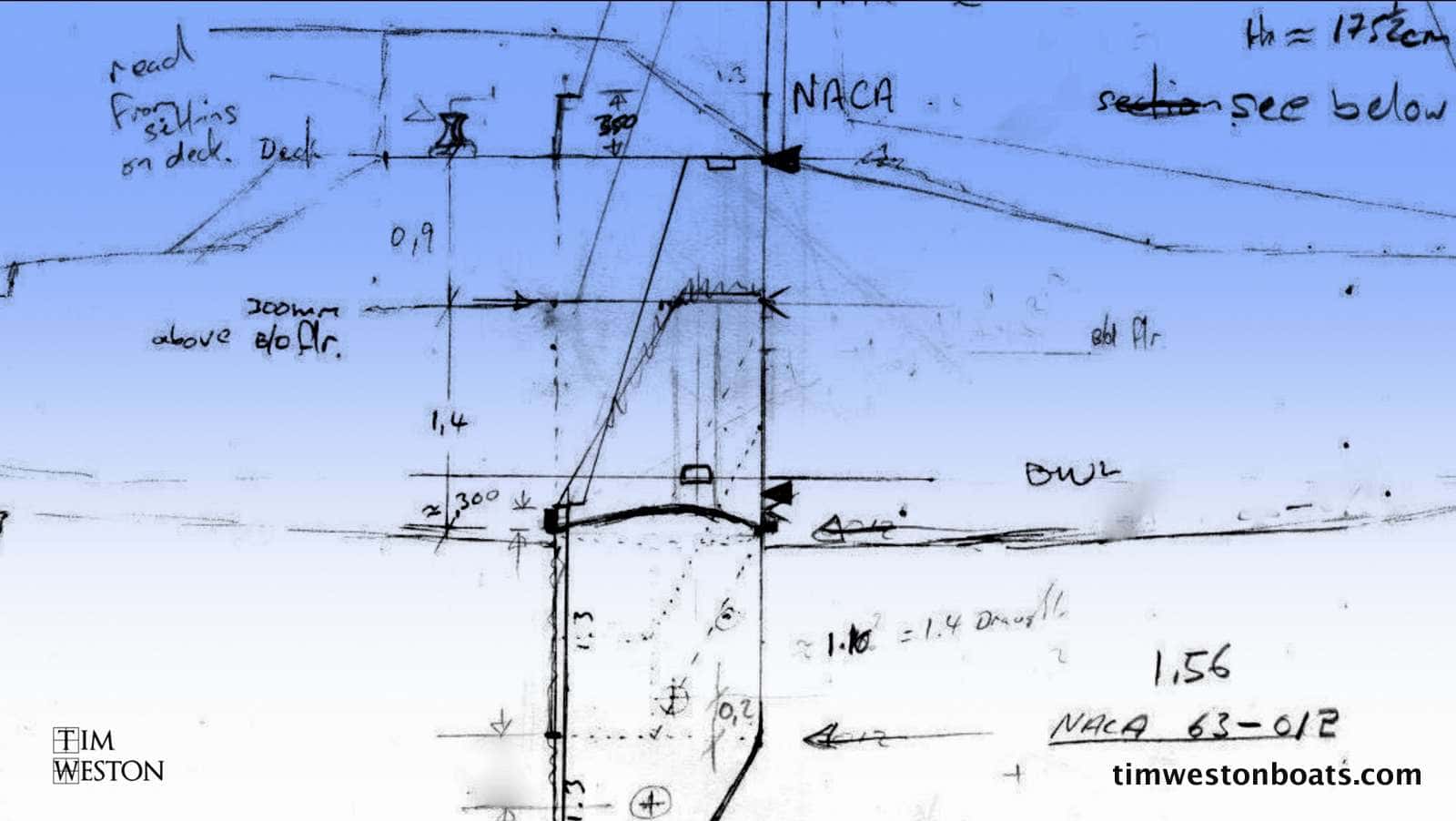
The importance of a daggerboard – in catamaran sailing.
Demystifying the daggerboard. There is nothing mystical about cats that make them inherently poor performers going to wind. In fact, the opposite is true, cats have inherent qualities that make them better than a keel yacht in windward performance. Not leaning over is one of them.
The daggerboard seems to be one of the most misunderstood pieces of equipment on a multihull. Debates on forums and blogs about daggerboards vs mini-keels are many. What are they for? Are two daggerboards better than one? Should you pull them up when going downwind or in a storm? One or both and which side? There seem to be as many opinions are there are blog posts on the subject. They were a mystery to me too when I built my boat, and after a year in the water, I too learned how frustrating it was, going to wind on a cat. I needed to learn more.
Daggerboards and going to wind
I built a 40ft catamaran back in the 90s called “Tokyo Express”. A cruiser/racer that was lightweight and fast downwind and on a reach. But beating to wind was hard work; I covered a lot of ground fast but progress toward my destination was poor.
After a lot of measuring, recording and testing I took all the data I’d gathered and spent months in libraries, going through all the textbooks I could get my hands on, reading up on the hydrodynamics of sailing.
The conclusion I came to was a simple one. Catamarans just don’t have enough keel area. As simple as that. The daggerboards on most cats are way too small. I also believe that their short chords work against them not for them, and mini-keels are, no surprise, worse still.
Cats only seem to get given small daggerboards
Maybe the reasoning designers have for using such small boards (compared to the keel on a similar size monohull), is that because cats are faster, they don’t need as much board area. The trouble is you don’t always move fast, and sometimes speed is the last thing you want. Hauling to wind in heavy weather is one scenario. Once you slow down below the speed, the boards were designed to operate, you have a problem. But even at speed, they don’t point well.
So I left my boat at anchor and spent 3 months in my shed, designing and building a new daggerboard to replace the original ones. One large board instead of two, with 150% more surface area than the original boards put together. I slipped the yacht and installed the new Case and daggerboard, then headed out for my first sail. It was a different boat, totally. It went to wind as I’d never experienced before.
I could now sail as hard to wind as a keel yacht, but faster. I only raced the boat once, in the Whitsundays back in the winter of 1998. It was a fun-race, at the end of a week of racing; most of the boats were racing yachts. Starting on a handicap, 10th last over the start line, behind 130 boats. I headed off on the single lap that we all sailed around, a triangular course with 2 legs hard on the wind and a downwind leg to the finish.
On the first leg, I overtook half of the fleet, sailing as high as, and faster than the racing keel yachts. On the second leg, I passed more boats including all the multihulls, to finish 20th overall behind the large million dollar maxi’s, that started too far in front of me to catch.
The weakest link
The power of the rig depends on the power of the daggerboard that opposes it. If the daggerboard can’t provide the reaction needed, to the sideward forces generated by the sails, then you will not get the most out of your rig. If the board can’t handle the forces of the rig, it will stall or semi-stall, allowing the boat to get pushed sideways.
What I noticed most when this happened, was that the rudders loaded up and the boat was difficult to steer. The high side loads caused my rudders to become difficult to turn, and I eventually burned out the autopilot. The rudders were doing what they weren’t designed to do, go sideways through the water.
So I would ease off the wind, reducing the side-load and picking up speed. With the extra speed, the boards generate more lift and the sideslip would reduce enough for steering to improve. Now I was zooming along, but not going where I wanted to go. You need to move fast to get the boards to work, but the extra speed was a waste of time because I couldn’t point high. In heavy weather, I suffered a less than comfortable ride going back and forwards across the wind, instead of making good velocity towards my destination.
Safe (as well as fast)
These problems vanished after I installed the single daggerboard. I sailed for the next 3 years with the new board; it was the best thing I ever did. It saved my butt in the Pacific, and maybe even our lives, in storms my partner and I encountered on the return trip to Australia from New Caledonia and Vanuatu.
Sailing single-handed with a seasick partner, I could get some sleep at night despite the storms. On the 8 day trip out to Noumea, I made headway going to wind in huge seas comfortably, by reefing down and pulling the boat hard up to the wind, locking the boat to the apparent wind using the autopilot coupled to the wind vane.
This kept the speed down and under control, as there was a big sea running and it was rough. I could point high and make good progress toward my destination with my speed under control. The boat followed the wind shifts, hard on the wind with a steady 7kts. Even under these conditions of extreme wind, and slow boat speed, there was no sideslip. The steering was effortless and the small autopilot I’d since replaced could do the job without problems.
The boat drove like a tractor upwind and I think that is the best analogy I can think of to describe it. I couldn’t imagine being out there in those conditions the way the boat used to sail; hard to steer, half out of control and not going to where I wanted to go.
The daggerboard is the heart of a multihull
You can have the slipperiest of hulls, lightest of boats and most expensive rig, but if you don’t have this part of the boat right, you are not getting good returns on the money spent in the other areas. It doesn’t matter if you are racing or cruising, the ability to go to wind makes or breaks a boat. I have a video about the daggerboard, on youtube.
If you aren’t happy with your cat’s performance and are interested to do something about it, I now have plans available, so you can build a large daggerboard yourself.
Whether you are building a new boat, or you own a cat already, you can replace the original boards with a big one, that will change your boat forever. You won’t recognise your boat afterwards, and as a bonus, you win a lot more room in the hull without the 2 nd board, i.e. freeing up space in the galley. Check out the new webpage for more details and if you would like more information, send me an email .
I hope this has been helpful.
PS — I have a book out now “ Building Tokyo Express ”, with the story of the building of my cat. The next book coming is due early 2020; it’s the story of the 5 years I lived aboard TE and goes into a lot of detail about sailing with this board, and the valuable lessons I learned. Subscribe on the website, and grab the book when it launches at the intro price.
Share this:
- Click to share on Facebook (Opens in new window)
- Click to share on Reddit (Opens in new window)
- Click to share on WhatsApp (Opens in new window)
- Click to share on Pinterest (Opens in new window)
Related Posts
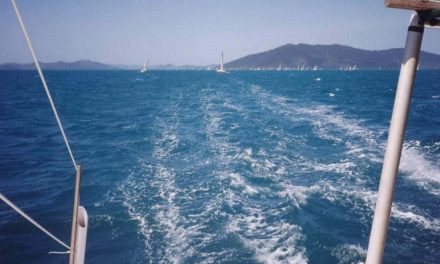
How fast are catamarans
May 23, 2017
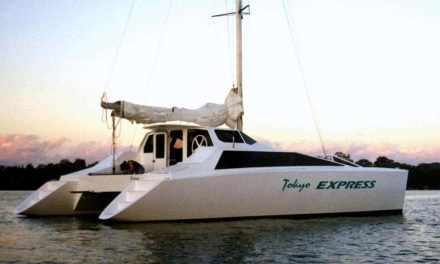
- Catamaran vs Monohull
March 11, 2019
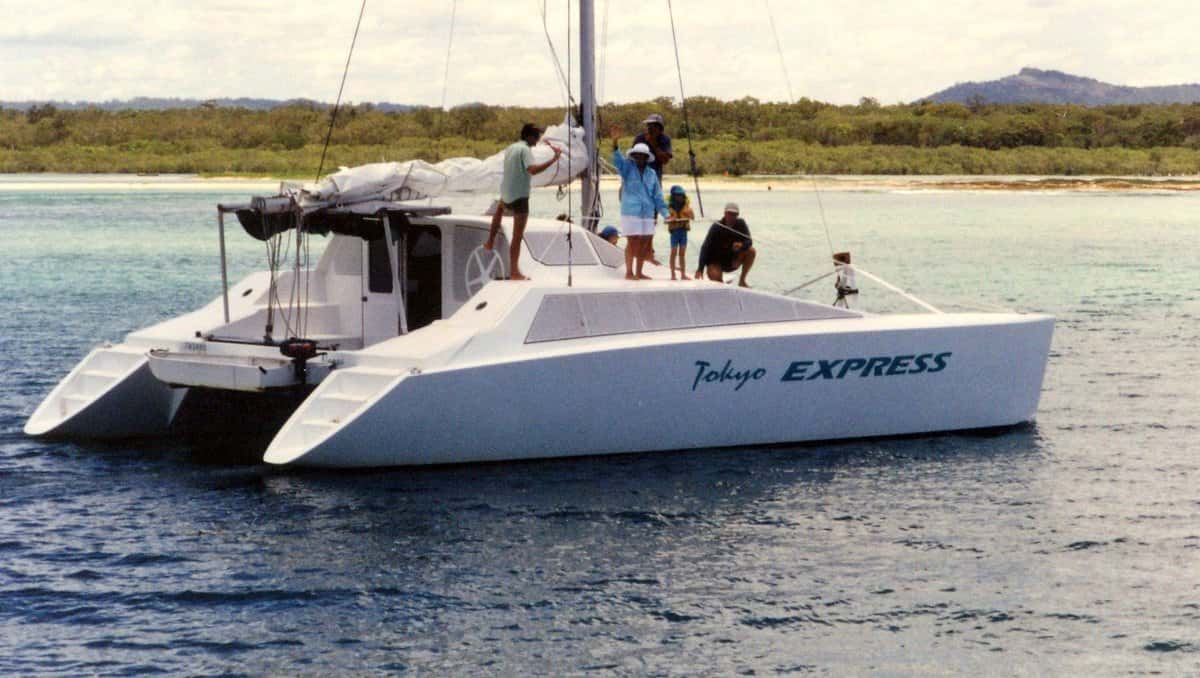
Cruising video is up
August 30, 2016
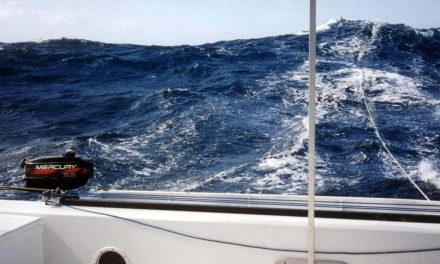
- Catamaran size – how big a boat do you need – ocean sailing
October 18, 2017
Thanks for posting this information!
Very interesting I recently sail A 6 meter beach cat Thanks
I built the UNI-CAT a fun 14 foot x 7 ft boat the solution to dagger boards for that was to use 4 very & narrow short boards that could rotate slightly 2/3 back from the leading when inserted in their slots. In light winds use all 4, but in stronger winds use only 2. They only added 1 foot to the draft but because thet pointed into wind the boat could point to where you were headed without side drift. Later I modified it to use only 1 but controlled the amount of rotation.
What do you think? Leave your comment.. Cancel reply
Search site, new book – just released.
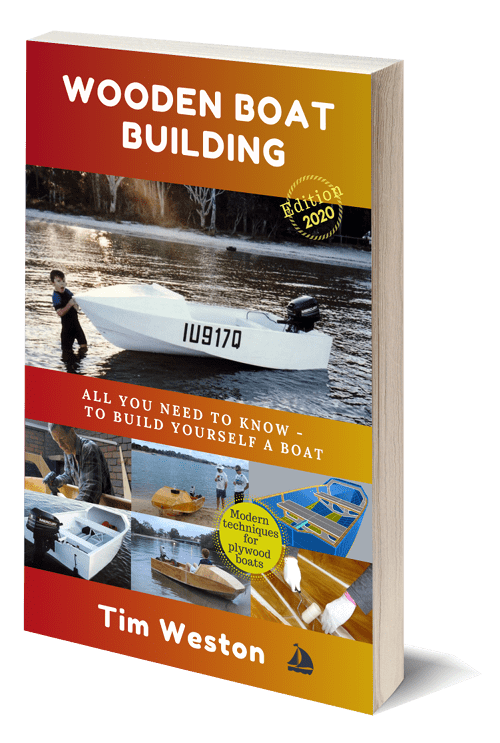
Watch the Video Series – (1 hour & 45 mins)
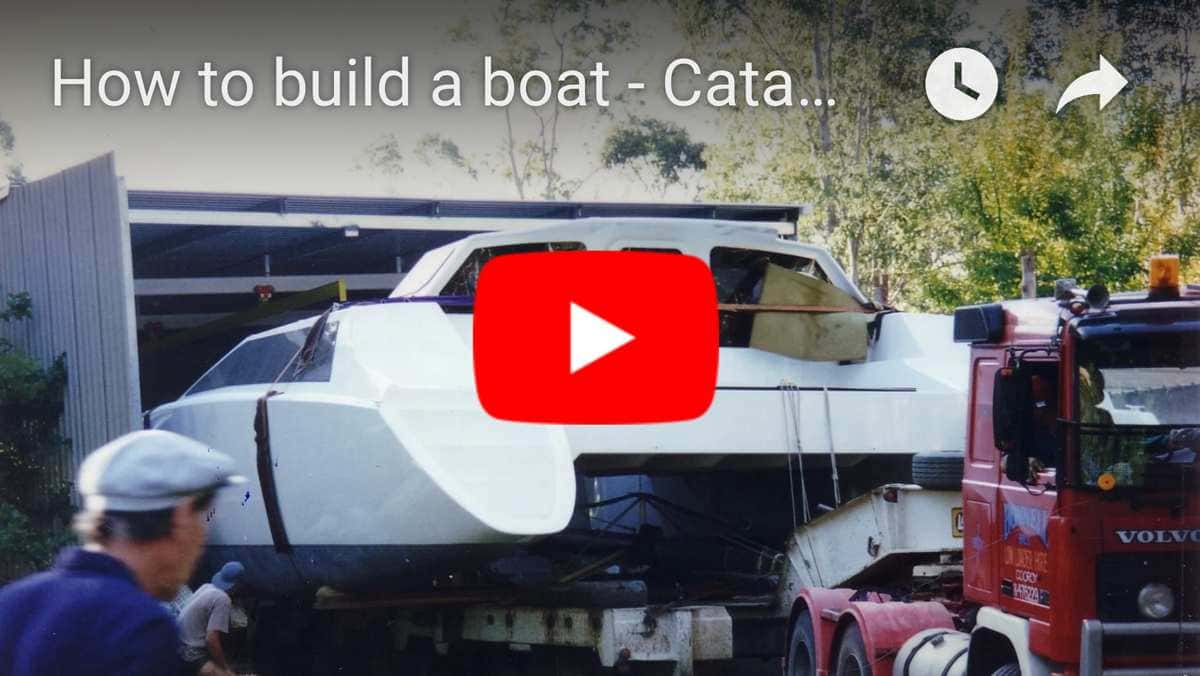
Recent Posts
- Going fast – in small boats – hull speed.
- Keeping safe – while building your boat
- How much does it cost to build a boat – a 40ft Catamaran?
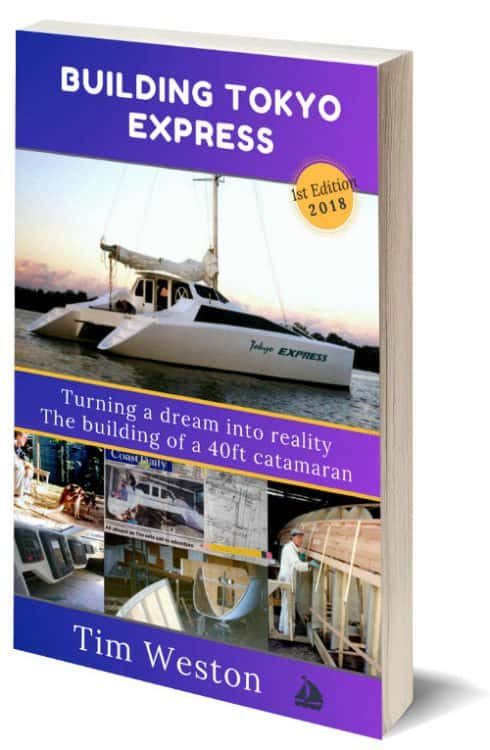
Get the Guide – Free
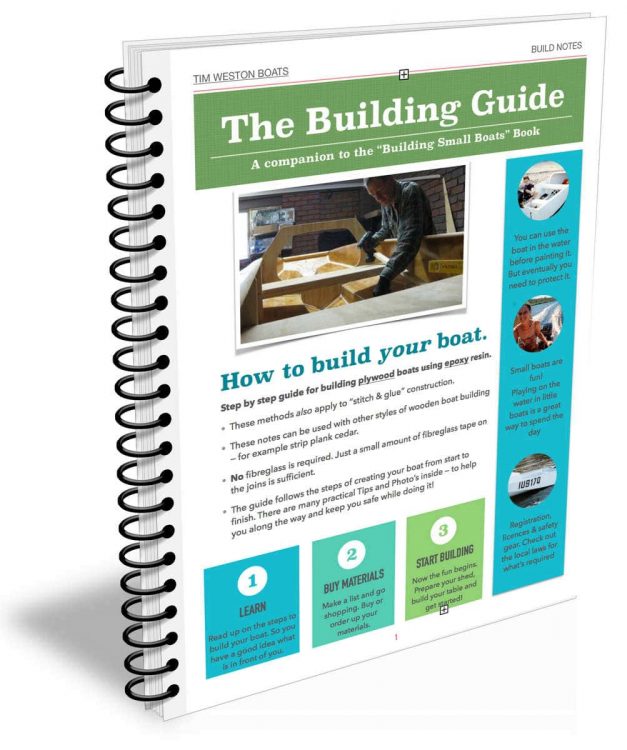
Privacy Overview

- About Aeroyacht
- Aeroyacht Design
- Aeroyacht TV
- Mission Statement
- Aeroyacht Racing
- Favorite Links
- Customer Testimonials
- Office Location
- BUY A MULTIHULL
- Specifications
- Photo Gallery
- Try Before You Buy
- Yacht Ownership and Demo Sails
- BUY A POWER CATAMARAN
- Yacht Business Ownership FAQ
- MULTIHULLS FOR SALE
- Aeroyacht Superyacht Catamarans
- Global Multihull Search
- Buy A Multihull
- Sell a Multihull
- Multihull News
- Publications & Articles
- Commissioning & Delivery Services
Multihull Keels and Daggerboards

Fountaine Pajot BELIZE 43 resting on her keels, showing good bridge deck height
Uncovering the compromises of both underwater appendages and analyzing their disadvantages and merits.
Man has learned much from nature, and sailboats and their underwater appendages are one of the areas that we have applied what works and what doesn’t. As we all know, boats – as most things in life- are compromises and often we are prepared to make concessions in one area in order to gain an advantage in another. Not only should this brief discussion illustrate the basic virtues and drawbacks of daggerboards and mini keels on multihulls, but also point out their active and passive safety aspects.
Most multihulls in todays marketplace come in two varieties. By far the vast majority of the production cruising catamarans (about 90%) are keelboats and have low aspect ratio, unballasted keels. These well known French, Australian or S.African boat manufacturers market their boats for private ownership and the charter industry and make a great product. Without sounding too general, these boats have very spacious interiors and are perfectly adaptable for live aboard families or the charter trade. This multi million dollar charter industry, has an obvious influence on the requirements and design of their charter fleet, which further has a trickle down effect to other builders who also market their cats for private ownership. Design parameters for these charter cats are often centered around 2 week multiple family vacations in the steady Trade Winds and day sails between closely spaced islands of the Caribbean. The features of these keel catamarans obviously put less demand on pure sailing performance or extreme upwind sailing characteristics, but rather try to please by offering solid construction, live aboard comfort and simple and reliable handling characteristics.
The other type of multihull is the catamaran with articulating daggerboards or centerboards. Centerboard and daggerboard multihulls both share the same basic concept, except their deployment and storage relies on different principles. The daggerboard lives in a scabbard, or daggerboard trunk. It moves up and down, vs. a pivoting centerboard, which is raised and lowered around a massive pin. High aspect ratio daggerboards are by far the most efficient foils. They have none of the problems associated with centerboards, which when fully lowered are only braced by a small area on top. When going upwind in a hurry, loads on the trunk act as a giant lever, which constantly work to spread the trunk apart. This is the reason why it is recommended to operate foils as pairs in heavier conditions to divide the loads. Also the large area of the remaining centerboard slot creates a lot of unwanted turbulence making them unpopular for performance minded sailors. Lastly declining popularity of the centerboarders can also be lead back to the often large intrusion on the interior space the trunks create. Although the Gemini catamaran is a good example of a very popular and well thought out production catamaran, there are few other mass produced centerboarders around. It should be noted that one great advantage centerboards have vs. any other underbody configuration is that they theoretically retract when colliding with an object. In spite of this, most offshore or performance orientated sailors clearly favor daggerboards or low aspect ration keels.

Illustration A
Daggerboard catamarans have several advantages over their keel counterparts, some of which are well known and others that are more subtle and sometimes only recognized by people who have used them. Active safety aspects are advantages created by speed and the ability to retract underwater appendages.
I am a firm believer of “faster” rather than “slower” on ocean going performance multihulls. Many people might say, going fast is only for racers. But lets think about this. The ability to reduce exposure time through speed is invaluable for cruisers. If say on a transatlantic passage you can shave off 5 days you have already increased your safety factor, in some cases, by 25%. Not being a “sitting duck” is a nice thing indeed. By being able to have the choice, bad weather can be avoided, which can sometimes lead to a negative spiral of incidences. In general, especially on long passages, a daggerboard cat will have the edge on speed over her keel counterpart.
Lets face it, we are all in it for the fun of sailing as famed designer Francis L. Herrshoff said: “The fun of sailing is directly proportional to the speed of sailing”. Maybe this is the reason he designed Amaryllis, his revolutionary catamaran, which was later banned from racing. Generally speaking daggerboard catamarans will always be slightly faster than their keel equivalents. The speed advantage of most daggerboard catamarans vs. keel catamarans though is often exaggerated. On a typical day sail a well trimmed and tuned keel cat will only be slightly slower than a daggerboard cat.
Multihulls lack the feeling of being in the “groove”, which monohull sailors enjoy. Effortless high average speeds, acceleration and sustained high velocity surfs is something fast multihulls compensate with. It should be noted that anything (even a barn door) surfs in the right conditions. Even keel catamarans can surf at speeds up to 30 knots down large seas.
Upwind Advantages: Depending on sea state going upwind, daggerboard catamarans vs. their keel relatives will point up to 5 degrees higher and also experience 2-5 degrees less leeway, which isn’t much one would think. But in an uncomfortable 100 mile beat this ads up to being more than 17 miles closer to your destination! (Illustration B).

Illustration B
sin A=a/c (sin A) c =a (0.1736) * 100 = a a = 17.36 miles
Lets take a 45’ catamaran: the lift (to windward) generated by a daggerboard is almost twice that of a low aspect ratio keel and the drag with the board all the way down would be almost 20% less. The most recent generation cats with large beams and stately bridge deck houses benefit especially from high lift foils, since the windage of their projected area can ad up quickly. The same cats with keels usually suffer from excessive leeway and sideslip. Keel cat’s however, especially in a calm sea state, lessen this disadvantage as boat speed and flow over their keels increases.
Reaching and Running Deep: When running deep in fresh conditions the fixed could act as a brake, that one cannot disengage. Since they cannot be retracted, their volume and resistance slows the boat’s progress and in combination with the forward pressure of the sails forces the bows down. This is especially the case with catamarans that have long bridgedecks, heavy extremities and low volume- fine bows. The bigger the friction in the water, the bigger the pressure on the mast and the more the boat is burdened. Another neat trick is lifting the daggerboards, one can actually increase apparent wind by pointing up and induce leeway, crabbing faster to ones destination.
Tacking and Helm Feedback: Cruising catamarans are often mistaken to tack slowly and behave sluggishly to movements of the helm. This is certainly true for some heavy keel catamarans and much less so for ones equipped with boards. In complex seas, some of the heavier keel cat’s only option for a safe tack is back winding the jib. Monohulls with only one fin will always tack quicker than multihulls, just as foil equipped catamarans will be more responsive than keel multihulls. Modern hydraulic steering systems are easy to build and with most forward helm stations behind the main coachroof, pose sometimes the only alternative for the builder. Mechanical steering and daggerboards will give the ultimate feedback and fun at the helm…if one is driving at all, since usually the autopilot is engaged for longer legs.

Inclined foils on the Aeroyacht H42 performance catamaran built by Edel
Another advantage of daggerboards is the better maneuverability under one engine. If you loose one engine and retract the board on the hull which has no engine power, but leave the powered hull’s foil down, the boat will turn easier. Because of the retracted foil on the un-powered side there will be much less drag induced turning moment, the boat will be more balanced and the other sides deployed board will provide sufficient bite for “survival” steerage. Especially in high crosswind situations a catamaran with both boards down is much easier to maneuver than one with shallower keels. Usually harbor maneuvers under power are low speed operations, and this is where the high lift capacity of twin boards excel yet again and facilitate handling and precision steerage. Daggerboard cats also can motor a bit faster, since by retracting the foils they have less resistance.

Keel and daggerboard cats usually have less draft than keel monohulls, opening access to shallow anchorages. An advantage daggerboards have, are their gauging characteristics when entering shallow harbors or unknown territory. By lowering them, one actually creates a “safety depth”. When they touch bottom one still has the possibility of raising them, performing a U-turn and getting into deeper water. With fixed- non retractable keels, especially with a monohull, groundings or unplanned bottom encounters could end tragic. At least a monhull can attempt in heeling the boat to reduce draft and re float. This obviously is not an option on a keel cat. If you get stuck in the mud you are dedicated to await the next high tide to get you off. Crashing into a coral reef could be a different story altogether and only a haul out can asses and repair damage. Depending on their design, boards could be rotated or flipped, and even repaired underway. In general daggerboard cats also have less draft than keel multihulls allowing access to even more harbors and anchorages. They can be beached high up for repairs or inspections, increasing the window of exposure time between tides. I know, I once performed a 5 hour long emergency repair on our 43’ catamaran this way, saving 1000’s in yard bills and days of headaches.
It should be notes that keel catamarans however, can be beached just as easy as daggerboard cats. They can be left sitting, high and dry, completely safe on their keels, without having to worry about damaging the hulls or getting debris or sea life stuck into the vulnerable daggerboard trunks.
Bruno Nicoletti is an old friend and one of the most low key-expert sailors I know. He has logged more than 130,000 miles (geriatric miles as he calls them) on his 44’ daggerboard catamaran.. At a recent meeting with him in France we talked about his experiences of his record, double handed – one stop- Southern Ocean circumnavigation at age 63. The French Press compares Bruno to sailing legend Vito Dumas and has published his accounts in an article called: “The Impossible Route”. He explained, that in the Southern Ocean, in the most convoluted conditions he would simply raise both boards, lock the helm to windward and lay a-hull with no sails. “Brumas Patagonia” would safely slide down the steep faces of waves and minimally drift to leeward at about 1 mile per hour while he was either resting or reading. The water spoil of his side wards drift would help keep the edge off cresting waves and often prevent them from breaking (Illustration D) While it was blowing 70 knots and higher he felt very safe and in fact the world around him turned peaceful and quiet. His confidence in this system is impressive: I am currently helping him with sea trials on his new 47 footer for a yet another go at a High Latitude – geriatric- circumnavigation. This time he is planning to take his 78 year old brother and do it non stop !

Illustration D
It is not only in the Southern Ocean that one encounters steep, breaking waves. Major capes or the Gulf Stream are notorious for rough conditions where the ability to navigate safely becomes imperative. In these environments any proven and strongly built daggerboard cat would have a slight advantage by lifting her boards, although a well designed keel catamaran could get through unscathed. In extreme weather, and I am talking beyond Force 10, it is very important to enable a catamaran to side-slip rather than encouraging the possibility to trip, and maybe flip. A catamarans behavior in towering side waves is decisive and the possibility to lift underwater appendages is essential, especially if one has lost the ability to steer. The disadvantage of a keel catamaran in huge beam seas is more psychological than real, as these types of vessels typically also slip sideways. In survival conditions or emergencies, the use of parachute anchors, which force the boat into a certain attitude is often thought to be the only answer for most boats. In my mind this tactic is questionable since it puts enormous strains on the boat, is accident prone and renders one helpless when the odd rogue wave from a different direction smacks into the boat. It is better to manage survival conditions, by controlling and slowing the vessel with the use of drogues.
We have learned a great deal from aerospace industry and the trickle down effect to monohull keels. Multihull designers and builders greatly profit from the advanced research, that has been done in the field of NACA sections (National Advisory Committee for Aeronautics) and foil performance. Keels and daggerboards come in a variety of aspect ratios but most are based on low speed foils, which drag/lift characteristics have been optimized. To increase lift even further, some performance catamarans even utilize asymmetrical shaped daggerboards, shaped flat on the outside (leeward) and cambered on the (windward) inside. As they can only be used one at a time asymmetrical boards are somewhat limited in their adaptation for cruisers. (Illustration E)

Illustration E
Since multihulls do not heel, their underwater appendages are more effective in retaining positive flow than their monohull relatives.(this is also the reason why autopilots burn out less often and can be used in heavier conditions on catamarans) As the monohull heels, not only is the upper part partly blanketed by the underbody of the vessel but also flow is lost as the water slips past the angled keel to leeward. (Illustration F) This was especially prevalent on the early IOR monos, which had extremely beamy and shallow bilges and high prismatic coefficient center sections. To compensate for this loss of heel induced flow, monhulls need deep draft keels to make good progress to windward. The keel or daggerboard catamaran on the other hand can more efficiently create lift for the same keel plan view area, not only because it has two vs. one keel, but also through its minimal heel is able to keep its underwater appendages perpendicular in the water.

Illustration F
Usually catamaran daggerboards have a higher aspect ratio and are deeper than the equivalent length monohull, since they have the ability to retract them and therefore have no draft considerations. It is therefore not surprising to see that in wind speeds starting at around 10 knots a well designed and sailed daggerboard cat, will often outpoint and outpace a performance monohull. Even well sailed keel catamarans can often arrive earlier at an upwind destination compared to heavy monohulls. The couple of degrees they sacrifice in their ability to point to windward is often made up by their higher speed and VMG (Velocity Made Good). This performance difference increases proportionally to the wind speed and is very noticeable in F.4 conditions and beyond.
A well known fact and possibly the single biggest psychological deterrent of daggerboard cats is the vulnerability of the boards and trunk in collisions. The true Achilles heel are actually ill constructed and designed trunks, which cause flooding in an impact. This obviously is not the case with keels, which would deflect a minor obstacle, or in case of hitting a container or whale, simply break off. In the case of sacrificial keels, they would sheer leaving the hull completely intact.
Obviously the most critical area in daggerboard design is the construction of the daggerboard trunk. It is usually heavily reinforced with massive gussets, especially at its aft bottom end and extends from the bilge to the overhead. Typical forces on the trunk easily exceed the pressure of the wind on the sails. Dynamic forces of wave action and the shock loads of slamming into seas or solid objects must make this area one of the strongest and best engineered of the entire vessel. Usually the foils are located just aft of the main- mast bearing crossbeam and are somehow tied into this unit to profit from its stiffness. The more “left over” daggerboard remains in the scabbard in the fully down position, the better it is braced, so it is not surprising to see foils that are 18’ long for a 60’ boat. Builders who take their job seriously go through great lengths to make this key area as strong as possible. In a recent conversation with the manager of a reputable French production yard it was pointed out that the daggerboard trunk is engineered and constructed 7 times stronger than the composite board. In case of a violent impact, the foil, which has weak spots designed into it, will snap and leave the daggerboard trunk unscathed. It is a type of sacrificial impact philosophy or a safety fuse, just as it is used on sacrificial fixed keels. The careful engineering and experience necessary in building reliable daggerboard or keel cats stresses the importance of a production yard, which has consistently built them. This aspect should not be taken lightly if one ventures out into the open sea, even if it is only 20 miles offshore.

Often builders of keel cats ad daggerboards to their designs, with the objective to market increased performance and safety. This usually ends up in a compromise, since the hydrodynamic hull requirements of both types could differ substantially, let alone the experience of proper integration, engineering and construction might be lacking altogether. Building with keels does not require the experience, careful construction and engineering which are necessary with retractable foils.
Keels offer advantages, as they do not need to be operated at all. They do their work silently and its usually one less thing to go wrong. On the other hand people who have never sailed with daggerboards think their operation is complicated. In fact they are as easy to use as outhauls or travelers. In normal conditions with 2 people – one pumping the daggerbaords up haul line directly at the board- the other taking up the slack of the up haul, it literally takes 3 seconds to raise a 15’ daggerboard. Single-handed it is a 10 second affair involving 2-3 wraps of the up haul around a winch and 10 cranks. Most boards are slightly heavier than the water they displace and often only weigh 80 lbs. Dropping takes half a second, by simply opening the up haul sheet stopper and easing the foil down. Loads on the boards increase as the speed and pressure builds, so if one has the choice, these maneuvers are usually performed just before tacking. It is a misconception that the operation of foils will depend on the wind speed. It is rather the boat speed, in regards to sea state – which in turn limits progress – which dictates the proper positioning of the daggerboards.
Nothing is perfect and this analysis would be worthless without mentioning the pro’s and con’s of either underwater appendage. Daggerboards, their surrounding structures and systems are more expensive to build, so builders prefer to stay away from them given the choice. In some catamarans, especially smaller ones or ones that have the trunk in the center of the hull, the interior passage in the hulls can be crammed. Lastly it should be mentioned that incorrectly designed and constructed, daggerboards multihulls can be more of a detriment than virtue and in some cases can be extremely dangerous. If the trunks are not massively reinforced and in case of a violent collision one could flood one hull and cause a capsize. In this case one is better off with a well designed and constructed keel multihull than a mediocre or untested one with daggerboards.
Yet daggerboards give you choices, that keels deny you. It is like the new generation of cars with Tiptronic gearboxes, which offer you an automatic transmission with manual override. By physically selecting the proper gear, torque can be adjusted to suit the conditions. It’s the same with the daggerboard equipped catamaran. The boat can be fine tuned to optimize the level of efficiency of the vessels motion through the water. By being able adjust the foils, superior sailing characteristics result in speed and generally more fun on the water. Active safety aspects of reduced exposure time, better maneuverability and shallow draft provide significant benefits.
For safety reasons, most catamarans builders opt for fixed keels and completely separate the keels from the hulls, a feature which preserves and protects the water tightness of the boat in the event of violent impact. Furthermore, if such a situation arises, it makes them easier to repair or replace. Fixed keels require no manipulation, such as daggerboards and give perfect protection to drive shafts, propellers, rudder blades and hull bottoms in the event of grounding. Lastly the absence of a centreboard case means saving of space in the interior of the vessel and usually results in a larger living space.
Back to the birds. We all know the giant Albatross as an extreme example of a sorer that can glide for days in varying conditions, without having to move its wings. This Southern Ocean beast, who calls his home the most inhospitable area on our planet, is better adapted to handle extreme circumstances than any other flying animal. The Albatrosses’ wings are sophisticated in shape, but basically are articulating high aspect ratio foils very similar to daggerboards. Similar to the Falcons “high speed” wings, the Abatross can modify its wings aspect ratio to adjust to the breeze. The designers of the Polynesian multihulls, legendary Viking long ships and American Cargo Schooners understood this too. By adding movable leeway devices, center- or daggerboards, they made their boats more seaworthy and even sailors in the past preferred them over fixed keels.
Today we continue to strive to find the perfect compromise in our vessels to satisfy our most important requirements. We should be extremely thankful to the 1000’s of keel multihulls that have revolutionized the charter industry and many good boats have evolved from this trend. Reputable dagger board catamarans and well designed keel multihulls will continue to be the choice of future generations of serious offshore voyagers. Both offer their advantages and disadvantages and it is important to understand both in order to make the proper choice.
Gregor Tarjan, a trained naval architect and longtime multihull enthusiast is writer of numerous articles for Multihulls Magazine and various other trade publications. He has been involved in Dennis Conner’s “Stars and Sripes” 1984 Americas Cup Campaign, is the founder of Aeroyacht.He is also the co-editor and contributing author of the “Sailors Multihull Guide”, the book by Kevin Jeffrey.
Social Share
Catamaran news.


Planet Sail tests a McConaghy Multihull

Charles Caudrelier wins Arkea Ultim Challenge

Nautitech 48 – Control of the Wind

Boat Test: Nautitech 48 Open catamaran

NEEL 52 Trimaran VIDEO – Sailing at 17 knots
- Catamaran Steering Positions
- Catamarans vs. Monohulls
- Catamaran Learning Center
- Catamaran Speed
- Catamaran Efficiency
- Catamaran Stability
- Catamaran Safety
- Catamaran Shallow Draft
- Catamaran No Heel Sailing
- Catamarans and Seasickness
- Catamaran Space
- Catamaran Boat Handling
- Catamaran Advantages over Monohulls
- Wave-Piercing Bows
- Catamaran Sailing Schools
- Catamaran Insurance
- Catamaran Charter Business and Tax Savings
- Ask the Owner
- 5 Valuable Tips
- Survey Checklist
- Sea Trial Checklist
- MULTIHULLS & CATAMARANS App for Iphone
- Catamaran Surveys
- Multihull Services
- Catamaran Build Consultation
- Financing Services
- Catamaran Repair & Service Facilities
- Catamaran Demo Rides & Shows
- Catamarans for China
- Yacht Design
- Interior Styling & Yacht Art
- Photography
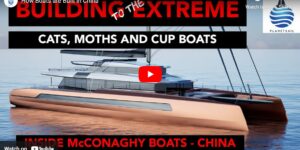
McConaghy MC63 Power Tourer – showing her pace
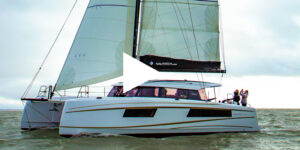
Nautitech 48 Open catamaran – Video

Nautitech 48 catamaran – Interior Design

How the Nautitech 48 catamaran was conceived – Designer Comments.
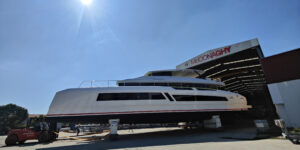
Launched ! – McConaghy MC82P Power
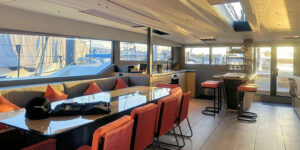
McConaghy 75 catamaran – Stunning NY Loft-Style Interior
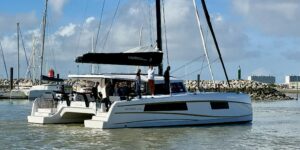
VIDEO: Nautitech 48 catamaran walkthrough. Part 1. EXTERIOR

VIDEO: Nautitech 48 catamaran walkthrough. Part 2. INTERIOR
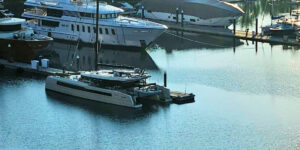
McConaghy 75 Launched.
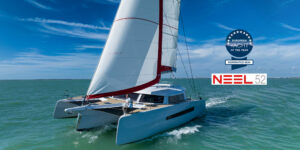
NEEL 52 trimaran nominated European Yacht of the Year 2023
Helpful tips from aeroyacht.
AEROYACHT PUBLICATIONS
Catamaran books by gregor tarjan.

JOIN AEROYACHT’S NEWSLETTER

(215) 508-2704
- Tao Catamarans
- Dolphin Catamarans
- Voyage Catamarans
- All Pre-Owned Catamarans
- Exclusive TMC Catamarans
- Sold Catamarans
- Buying A Multihull
- Selling A Multihull
- Sailing Schools
- Yacht Charters
- TMC Newsletter
- Employment Opportunities
- Mission Statement
- Affiliations
Performance Study of Daggerboards Versus Keels
Story by Phillip Berman / August 17, 2018
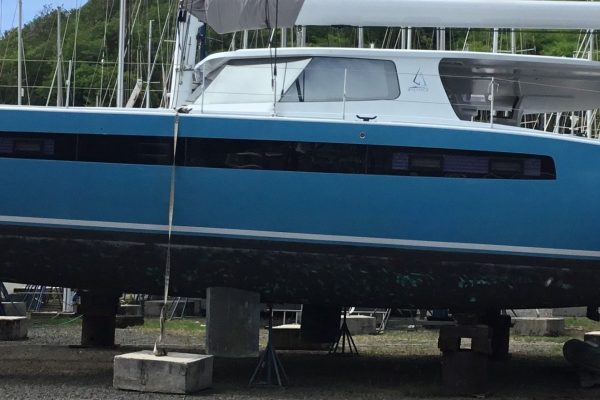
By: Phillip Berman, published with editor’s permission from Boating NZ and Blue Water Sailing
In my forty-five year career in the catamaran industry there’s been a relentless debate on the virtues and vices of daggerboards versus fixed keels. This debate has, however, mostly been waged without “hard numbers” from which to compare performance differences. As we have had requests at Balance Catamarans for both keels and daggerboards, Anton Du Toit (my design partner) and I felt we should conduct a study, the results of which follow.
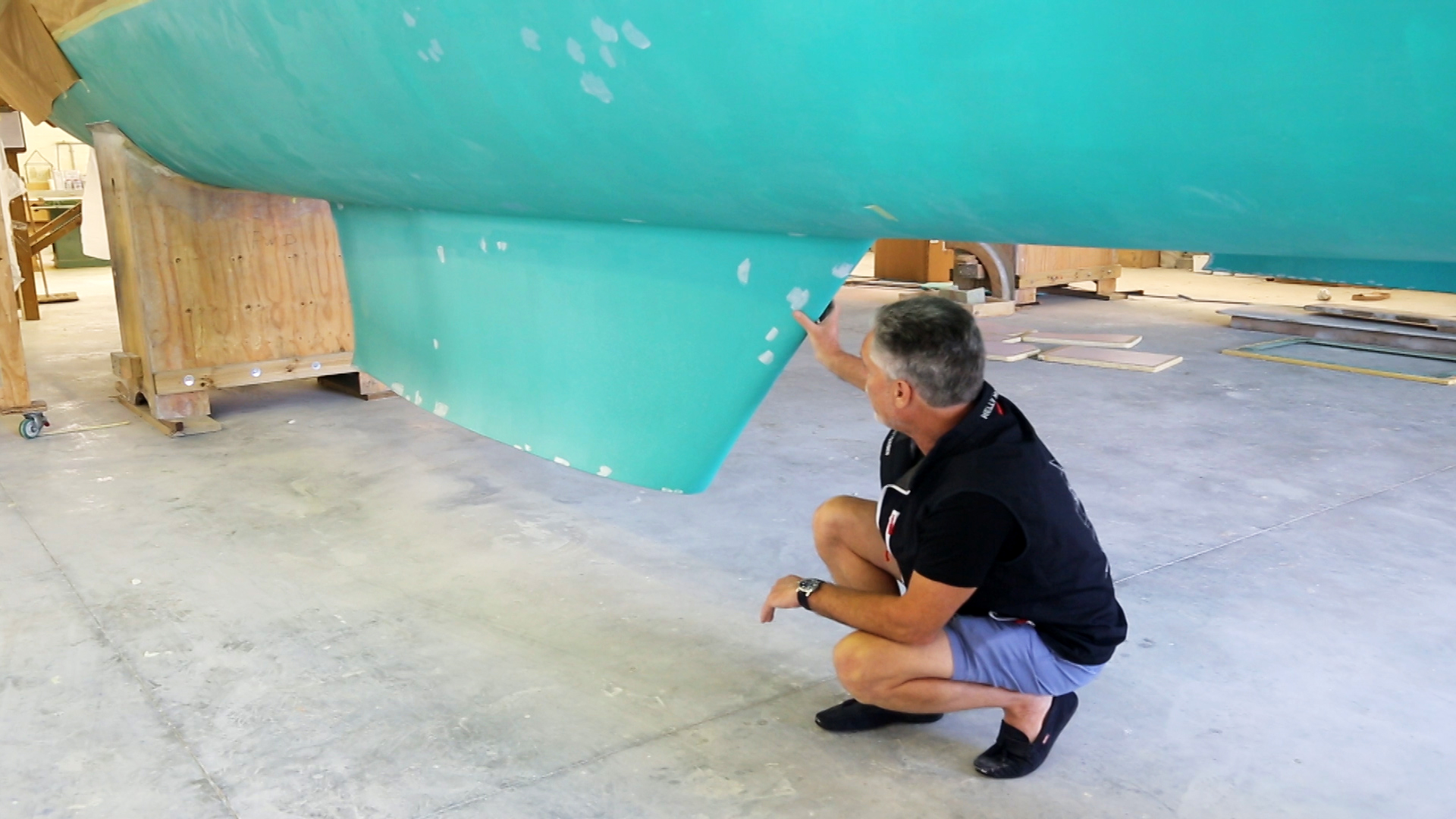
When we first set out to design and construct the Balance 526 we were aiming for cruising couples who wanted more performance and quality than they could find in mass production cats, but also more interior space, payload capacity and ease of use and maintenance than consumers focusing primarily on speed. Our intent was to find the balance – not to create the “lightest and fastest 52” in the world, or the “largest 52,” but a catamaran that could sail swiftly on all points of sail, carry significant levels of payload, yet still be gracious to live on. We also wanted her to be pleasing to the eye.
Our focus at Balance brings us an interesting range of buyers, some of whom are more focused on strength, space, safety and comfort rather than all out speed (cruiser types), others who are more speed focused, less value oriented, and prepared to give up comfort, ease of operation and payload capacity to go a bit faster (racer types). The later sorts of buyers are mostly what I affectionately call “spreadsheet guys.” (Full disclosure: I am not a spreadsheet guy. I am far more focused on how a boat lives, how tough she is, what she can carry, and how simple she is to sail and maintain without a professional crew.)
As we have gone along a few of our customers have asked if we would create the 526 with performance keels rather than daggerboards. They felt that the advantages of keels trumped the performance advantages of boards. We were happy to comply, so Anton set about to design high performance keels for the 526. (Note: On our 451, we only offer her with dual daggerboards and two shallow permanent fixed minikeels. On all other Balance designs it remains customer choice which configuration they wish to have.)
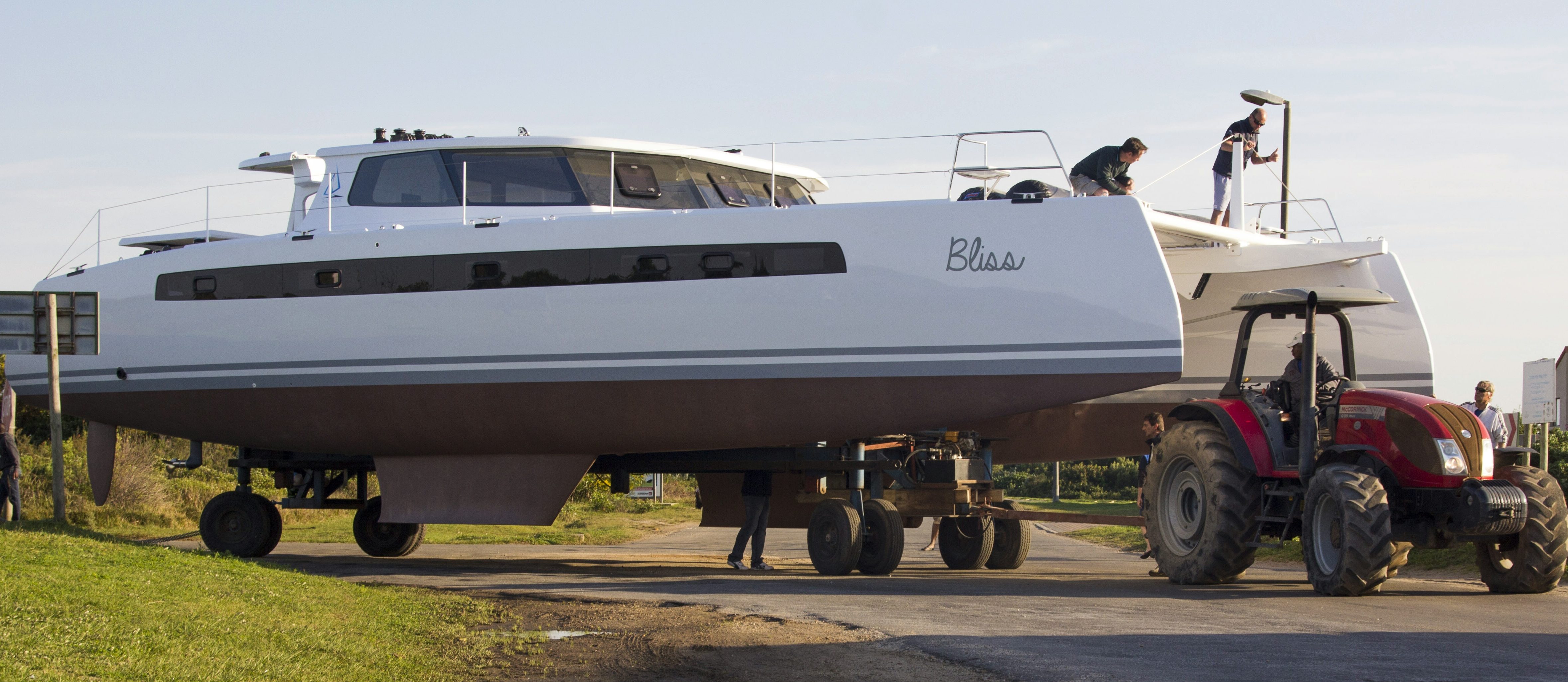
What we were not prepared to do was tell 526 buyers how much faster or slower the two different configurations would be. We felt it best to heed Lord Bryon’s advice to evade “kant and hyperbole” (the language of the day at boat shows!) so we hired the Wolfson Unit for Marine Technology and Industrial Aerodynamics at the University of Southampton to conduct comparative studies of the two configurations on identical 526 models. When you are comparing identical products with just two different variables it seemed a worthwhile study to undertake and share with our customers. It also becomes, to some extent, a worthwhile study for anyone considering a new or used catamaran purchase who is curious how the two different configurations impact performance.
While Anton and I believe these studies can be used by consumers to compare the relative performance differences between boards and keels, it is important to note that the 526 is a very light, narrowhulled epoxy performance cat and the keels we install are considerably finer, deeper and more carefullyshaped than those found on mass production designs. Additionally, we conducted the study with the daggerboards in the fully down position on all points of sail to reduce the studies complexity. The daggerboarded 526 would be marginally faster than the study indicates off- the-wind with boards raised due to a further reduction of wetted surface.
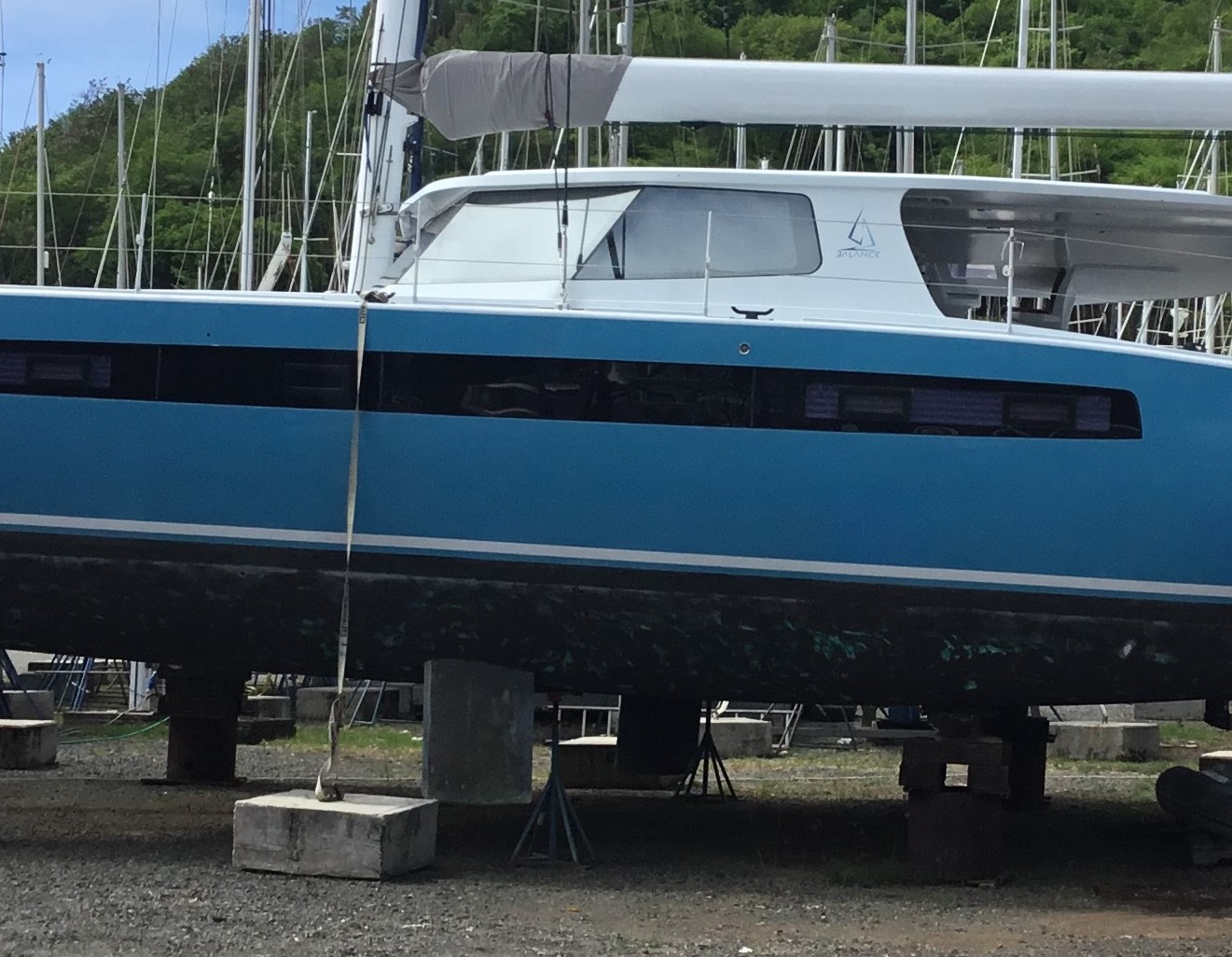
The disparity between keels and boards on a mass-production cat compared to a Balance or any other performance cat would be exaggerated considerably compared to the study that follows. I would note that we erred on the side of caution in setting our lightship weight for this study at 12.5 kg. We have carefully lode cell weighed our 5th boat and the actual lightship weight is 12,215 kg, or 26,930 pounds for the keeled 526 and 12,261 kg, or 27,030 pounds for the daggerboarded 526. Our lightship weight could be lower for customers prepared to put their boats on a diet, or sacrifice quality in several areas, but we have found that they want as much cabinetry as possible, folding tables, glass salon windows, Corian counter tops, and high-end flooring inside and out, etc. Spreadsheet guys miss the mark on this subject constantly in my experience. They also wrongly compare boats based on length, rather than the interior volume of the hulls and bridge – what I call the sum total of fiberglass parts. Regardless, the polars closely mimic the high performance our yachts have proven in real life cruising, fully laden, so this gives us great confidence in the studies accuracy.
Performance, of course, is not the be all and end all, so it is important to examine the advantages and disadvantages of boards versus keels beyond speed. They are as follows:
Advantages to Keels:
- No moving parts. One less thing to operate or break.
- If you ground the boat you hit the keels and they are easily repaired and at a low cost generally.
- You can chock the boat more easily on the hard and it is easier to beach in some circumstances.
- They cost less to fabricate.
- You get more room amidships for additional cabinetry.
- The keels add a bit of buoyancy. On a 526 about 1,600 pounds as our keels are large and mostly hollow inside.
- Daggerboards are typically a bit heavier. On the 526 each board and trunk weigh about 50 pounds more.
- Poorly designed boards and trunks can allow the boards to rattle when they are not under load. Keels do not rattle.
Advantages to Daggerboards:
- Boarded cats point higher and side-slip less as the study shows. I have noted that on keeled production cats you can “stick them up into the wind” but they tend to crab horribly when pinched, as such that you must crack off considerably to reduce leeway and sustain momentum. On most of the sea trials I conduct on production cats we “close reach” to windward on sea trials. This is less the case on deep, finely shaped performance catamaran keels.
- The draft on most keeled catamarans is deeper than the draft on daggerboarded cats. Our 526 keeled version draws about 12 inches more than the daggerboarded version. On daggerboarded cats the rudder tip usually represents her deepest draft. It is important to note that some cats carry very stubby keels to sustain shallower draft, but the shallower the keel the less well she performs when sailing close to the wind. This is important to keep in mind if you are comparing performance on fixed keeled production cats.
- Off the wind with the boards raised to 1/4 there is less drag and the boat steers and sails faster and more playfully.
- The daggerboarded cat is a bit faster and makes less leeway on nearly all points of sail as the study shows in the majority of wind conditions.
- An equally efficient set of keels have much more wetted surface than daggerboards, almost 4 times more. This is the case on our 526 keels.
- Daggerboards set properly can assist in preventing a cat from a “tripping capsize” in very high winds with large breaking cross seas. Both boards can be fully raised, or only the leeward board raised, so the boat can side-slip easily.
- Daggerboarded cats tend to have a bit higher resale value due to the fact that so few are produced in mass production. A buyer that wants boards will only focus on catamarans that have them.

Shifting our focus now to the performance data generated by Wolfson Unit. Their analysis returned the predicted boat speed and leeway angle for the Balance 526 with a keel design and daggerboard design for all combinations of true wind speed from 4 to 25 knots and true wind angles from 40 to 180 degrees. We can begin comparing these two configurations by directly comparing the speed and leeway at major points of sail, specifically beating, close, beam and broad reaching.
While beating the two designs are predicted to perform as follows: To summarize the upwind comparison, the daggerboard design is, on average, expected to sail 1.5 knots faster and 1.75 degrees higher. While close reaching the daggerboard design has less of an advantage than when beating, as can be seen from Table 2:
While close reaching the daggerboard design is expected to sail 0.5 knots faster and 0.75 degrees higher.
As the true wind angle approaches 90° for a beam reach, the keel and daggerboards become more closely matched.
In the beam reaching comparison the daggerboard design will sail slightly higher with a leeway advantage of about 0.25 degrees but it’s speed advantage in 5 knots TWS of 0.3 knots will fade to a 0.5 knot deficit in 16 knots TWS. At this point of sail the two designs are considered to have equal performance as the differences in leeway and boat speed are negligible.
Finally, while broad reaching the following speeds and leeway’s are expected.

In summary, when broad reaching the daggerboard design regains a slight advantage, as it maintains an additional 0.5 knots of boat speed. Leeway differences are again negligible.
Considering the above analyses, it can be seen that the daggerboard design will typically not only outperform the keel design but also out point it, make less leeway close to the wind, therefore giving the daggerboard design a substantial advantage when racing, or for performance focused sailors.
This data gives a fair comparison of the two designs at specific true wind speeds and angles but in order to fully understand the performance trends and enable better predictions between them, one must consider the entire range of wind conditions and all points of sail. This is best done with the use of speed and leeway deltas, where the differences between the two designs are calculated and analyzed.
The following two figures display the average speed and average leeway deltas. The calculation process to determine the deltas is chosen such that a positive value for the delta indicates an advantage for the daggerboard design, and a negative value favors the keel design. For example, a speed delta of +2 knots and a leeway delta of -1 degrees means that the daggerboard design is 2 knots faster than the keel design under the same conditions but would sail 1 degree lower than the keel design.
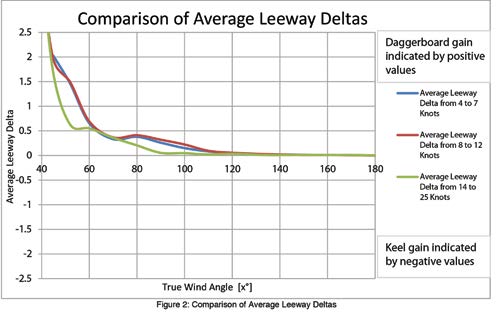
Counter to this, while still on a beam reach but when moving from a low wind condition to a high wind condition, the keel design begins to perform better. This is now taken from the green line (14 to 25 knot TWS range) and gives a -0.6 knot reading. Therefore the daggerboard design is now expected to be about 0.6 knots slower than the keel design under the new, higher TWS conditions.
Figure 2 is used in the same manner as Figure 1 but shows the leeway angle of each design rather than boat speed. Focusing again on a beam reaching condition, the leeway deltas indicate that the daggerboard will always out point the keel design as all three lines (TWS from 4 to 25 knots) indicate. positive values of 0.3, 0.35, and 0.1 degrees at 90 degrees TWA. Overall, Figure 2 shows that the daggerboard design has a significant gain in leeway over the keel design at all wind speeds and angles. This reaches a maximum when beating (TWA ±40-45 degrees) of 2 degrees, and declines to zero when running (TWA ±180 degrees).
With respect to the average boat speed deltas, Figure 1 shows that the daggerboard maintains a higher boat speed when sailing in light and medium winds (red and blue lines in Figure 1). In stronger conditions (green line) the daggerboards yield better boat speed when beating but the keel surpasses this between TWA of 60 to 145 degrees. Keeping in mind that the study was conducted with the daggerboards fully down at all times, in reality, the daggerboards will be raised in the 60 to 145 TWA range. As such the study slightly underestimates the speed of the daggerboard design over this TWA range.
Overall the daggerboard outperforms the keel in both boat speed and leeway in the vast majority of sailing conditions and is thus considered to be the better design choice if achieving ultimate performance is the key criteria. It should be noted that this study is specific to the Balance 526, but corresponding trends can be expected in performance cats of similar size and design.
In the end, and it is a point I cannot stress enough to any boat purchaser, all boats are sets of compromises and trade-offs, and so too with features – helm designs, sheeting systems, rig layouts, bimini designs, bed designs and locations, baths, engine placement, etc. Because I have been deeply involved in brokerage catamaran sales much of my life I recognize there is no one right or wrong boat, certainly no perfect boat, only a boat that happens to be a better fit for a particular sailor and his or her budget, cruising agenda and specific aesthetic proclivities.
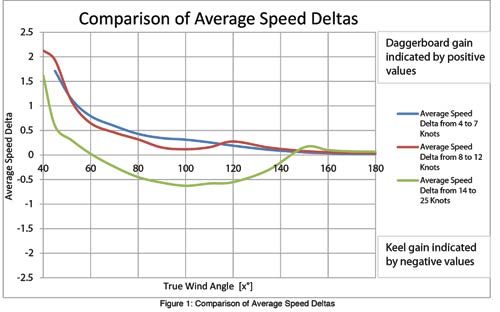
At least now we can say that if someone wants a 526 with keels, here is how she will perform compared to a boarded version. It is then up to the buyer to decide which configuration is the most appealing to them. I will say that, based on the five 526 we have sailing today, with over 60,000 miles of sailing behind them, those owners with keels seem quite happy, just as those with boards.
Alright spreadsheet guys, here’s your numbers to mess with!
Phil Berman is a former Hobie Cat World Champion and the founder of The Multihull Company, a global catamaran yacht brokerage firm. He is also the owner of Balance Catamarans, a boutique brand of high-end performance voyaging catamarans. He can be reached at [email protected] .
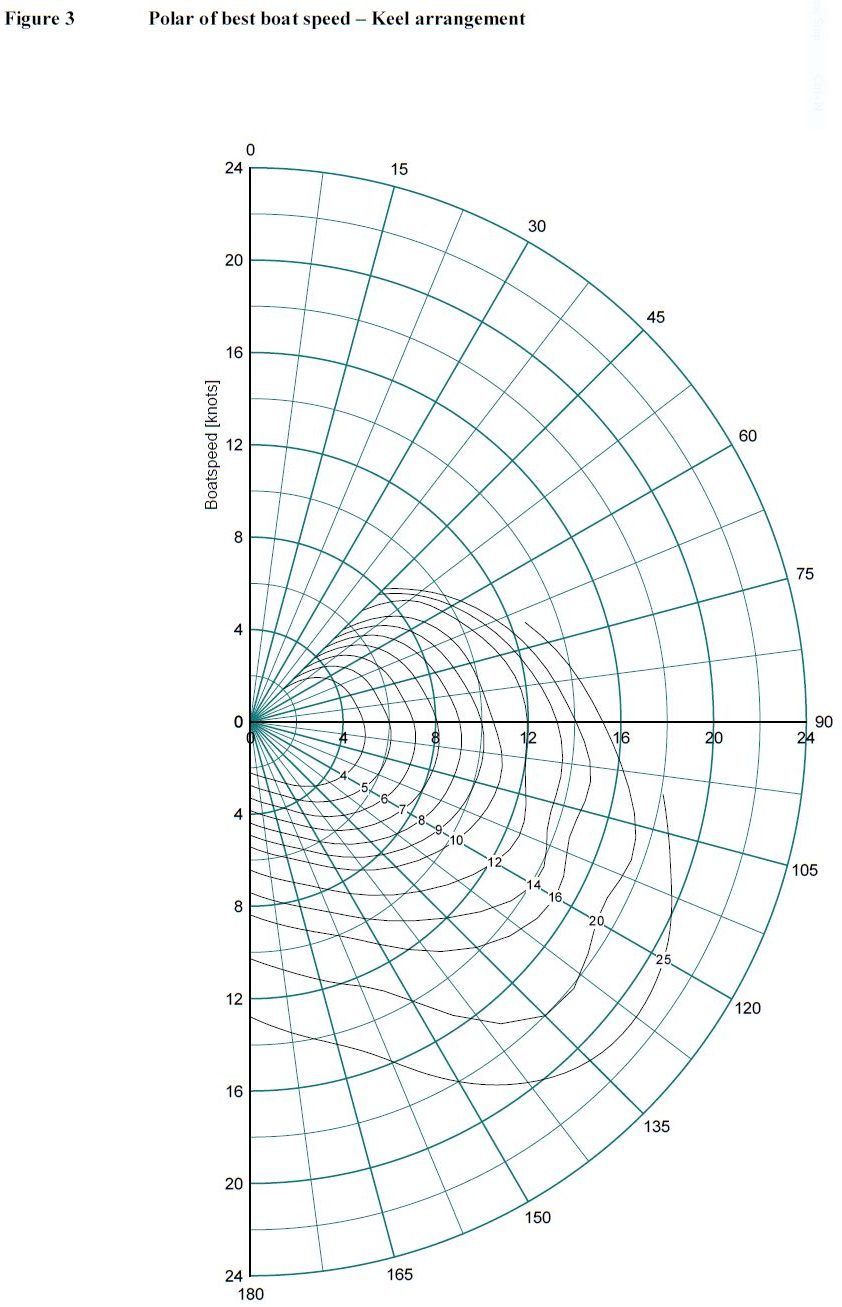
About Phillip Berman
- Are you a Spreadsheet Guy?
- Balance Catamarans is Born: A Bold Move in a Challenging Market
- Can a catamaran really sail upwind?
- Catamaran Depreciation
- Catamaran Vs Monohull
- Daggerboards vs. Keels
- Lessons Learned From A Free Spirit
- Placing a Boat Into Bare Boat Charter
- Post Survey Negotiations
- Saildrives or Straight Shafts? Which is Best For Me?
- Seller's Guide To Yacht Sales
- The 14 Biggest Mistakes When Purchasing a Used Catamaran and How to Avoid Them
- The 14 Biggest Mistakes When Purchasing a Used Cat…and How to Avoid Them Part Two
- The Perils of Internet Catamaran Shopping
- The Ten Commandments of Buying a Catamaran
Recent Posts
The multihull company announces the sale of the first pre-owned balance 482.
- Introducing the Tao 452: On Display At The Annapolis Boat Show October 12 - 15, 2023
Join Us At The Annapolis Boat Show Aboard the Voyage 590
The multihull company announced as dealer for the voyage 590, 6 great starter catamarans, ian edmonson joins tmc as yacht broker in fort pierce, fl., the multihull company opens new office in virginia, the multihull company named exclusive dealer for dolphin catamarans and their new model, the dolphin 380.
- Selling Your Catamaran in Panama
Visit Us at the 2023 Miami Boat Show
Categories: Articles , Articles by Phil Berman , Balance Catamarans , Catamaran Handling , Cruising Lifestyle , Design and Construction
Recent News
The Multihull Company is pleased to announce the closing on the Balance 482 "SeaLife" We wanted to take a moment and thank her new owners on their amazing new catamaran, and to also congratulate our team handling the sale. TMC agent Andrew Hodgdon successfully represented the buyers on the sale of the vessel, while TMC CEO Will Miller represented the...
The Multihull Company is pleased to announce their appointment as a dealer for Voyage Yachts and their new model – the Voyage 590! The Voyage 590 is being celebrated as the ultimate, luxury sailing catamaran with all the comforts of home surrounded by panoramic views of paradise. She maximizes luxury accommodation and comfort, with the performance and blue-water capability characteristic...
In early 2023, Cruising World approached us to seek our opinion on recommending a couple of brokerage catamaran options for first time catamaran buyers to consider when they first stepping into the catamaran market. Here are six boats hand-picked by The Multihull Company’s president and CEO, Capt. Will Miller, as excellent choices for brokerage-catamaran seekers. These are all worth a...
The Multihull Company, the world’s leader in multihull sales and service is excited to announce that it has been named the exclusive dealer for Dolphin Catamarans, a premier builder of high-quality catamarans, and their newest model, the Dolphin 380, designed by Philippe Pouvreau. "We are thrilled to be working with Dolphin Catamarans again and to be able to offer their...
The Multihull Company is thrilled to announce our participation in the Miami Boat Show, taking place on February 15-19, 2023. As one of the premier boat shows in the world, this event is the perfect platform for us to showcase our wide range of high-quality multihulls for sale. We are committed to providing our customers with the best experience possible,...
Introducing the Tao 452: On Display At The Annapolis Boat Show October 12 – 15, 2023
The Multihull Company is thrilled to unveil the new Tao 452, an exciting addition to the world of blue-water performance cruising catamarans. Meticulously engineered and crafted to perfection, the Tao 452 is set to redefine the catamaran experience for sailors worldwide. If you've ever felt the need for more sailing performance from your current production charter catamaran or been disappointed...
The Multihull Company is excited to announce its participation in this year's Annapolis Sailboat Show. The event will be held from October 12 - 15, 2023 in downtown Annapolis, and The Multihull Company will be showcasing the exquisite Voyage 590 catamaran from Voyage Yachts. The Annapolis Boat Show is a highly anticipated annual event that brings together boating enthusiasts, industry...
The Multihull Company is thrilled to announce the appointment of Ian Edmonson as a yacht broker at its newly opened Fort Pierce location. Ian brings a unique blend of boating passion, brokerage experience, real estate expertise, and customer-focused mentality to the team. Ian's love for boating began at an early age and has only continued to grow, leading him to...
We are thrilled to announce that Alan Prater has joined The Multihull Company team as a Yacht Broker in Virginia covering the Hampton Roads area of Virginia. With a lifelong passion for the water and a career spent in the US Navy and as a maritime training professional, Alan brings a wealth of experience and expertise to our team. Alan...
- Read All Articles
We take pride in our happy customers
Your team delivered on every mark. You’ve got an amazing broker in Mark Wattrus and I’m confident you will have continued success moving forward together. He was available 24/7 whenever I had questions. We had a great initial visit on the boat and his marketing plan and photos were superb
I bought a yacht that I had never seen. I did this because I trusted my broker Andrew Holland. It was not an easy job for Andrew, as I am an experienced boat builder and owner of previous yachts, but work in West Africa. Imagine how hard it was to communicate what I was looking for. Andrew came up with exactly what I wanted. He dealt with time delays, all my questions at odd hours, and was there for the survey. He reported honestly and professionally. After buying the yacht, I arrived at the boat on a Sunday night, after dark, after travelling from West Africa to the Caribbean, and found it was better than expected. He never pulled punches and made me aware of shortfalls. I expected to spend my one month leave working on the boat, but actually spent less than one week, and was able to spend 3 weeks sailing – wonderful bonus.
Thank you Andrew for putting up with all my questions, all my worries and all my crazy out of the time zone concerns – you were totally professional, but also I know that if and when we meet up, it will be like a friend finally meeting. You are always welcome on Aseka.
— Beverly Cory
Outstanding company with professional subject matter experts. If I were to buy or sell cruising sailboat, particularly a catamaran, Andrew would be my go to broker.
I have been sailing since I was a child and attended Massachusetts Maritime Academy. But when my wife and I began the process of purchasing an ocean cruising/racing catamaran, I realized that this is a world unto itself. Obviously, we needed to find someone knowledgeable to help us make an informed decision. More importantly, we needed someone honest and willing to put our interests before his or her own. I was lucky to work with Phil Berman at The Multihull Company. He repeatedly shunned the fast buck, choosing instead to work the long road to connect us with the “perfect boat”. I would be glad to recommend Phil and his company to anyone planning to purchase or sell a performance sailing machine.
— Eric Boutiette
Andrew Hodgdon was our broker when we bought our 2018 Lagoon 450F in Antigua in April 2922. He provided great service and was very attentive to our needs. We would highly recommend Andrew and the Multihull Company.
Trust & Expertise About Us
Successful relationships cannot exist without it. At The Multihull Company we base every relationship on a firm commitment to earning and retaining our client’s trust.
Advice of any kind is valuable only when grounded in hard-won expertise. It too, must be trustworthy. Trust and expertise define the heart and soul of The Multihull Company. We are a team of skilled professionals who thrive on providing expert, trustworthy advice and service to catamaran and trimaran sailors around the globe.
Follow us @themultihullcompany
- Pre-Owned Sales
Global Locations
New England +1-267-324-9067
Philadelphia +1-215-508-2704
Virginia +1-757-407-2526
Annapolis +1-703-350-8160
Charleston +1-843-364-4123
Brunswick +1-937-243-2213
Saint Augustine +1-910-477-2508
Fort Pierce +1-904-315-0997
West Palm Beach +1-561-312-0010
Ft. Lauderdale +1-484-744-2740
Miami +1-513-677-5338
San Francisco +1-215-508-2704
Seattle-Tacoma +1-206-297-1151
St. Martin +590 690 58 66 06
Grenada +1-473-457-3245
Puerto Rico +1-787-379-7348
Panama +1-305-735-1661
Trinidad +1-868-680-8909
Croatia +385 95 849 8009
France +33 (0) 6 73 97 17 30
Mauritius +1-215-508-2704
Australia +61 (0)7 5444 4822
Cape Town +1-843-614-2028
© Copyright 2024 The Multihull Company. All rights reserved.
catamaran boat double decker
- 0 No item in your cart
- SUBSCRIPTION
- Classified Ads
- Technical Specifications
- Destinations
- Address book

- All the magazines

SUNREEF 88 DOUBLE DECK: A catamaran designed for ultimate comfort!
680 m² of canvas downwind, 460 m² upwind, the Sunreef 88 DD is a real sailboat making 7 knots in just 10 knots of wind
The 88 DD is an imposing catamaran with an air draft of over 40 meters... Welcome to the outsized world of superyachts!
The sheer of the deck makes it possible to house a jet-ski on the sidedeck while maintaining good headroom in the cabins...
On the flybridge, behind the helm station, you find all the indispensable features for relaxation: sunbathing, barbecue, bar and a magnificent 35m² of space
The helm station located on the flybridge allows for handling everything on the entire cat while offering an ideal view of the water.
The aft cockpit encircled by loungers is very large. The skipper's cabin is hidden under the bench seat of the big table. Beneath the stairway, there is access to the day toilets without having to go through the interior of the boat
The Sunreef 88 DD hasn’t forgotten any of the rules of super-yachting. Attention to detail and refinement is everywhere on board, making life enjoyable
The cockpit interior offers a good view forward across the water. From here, you can handle the boat while staying warm during night watches.
The owner's cabin occupies the entire forward part of the coachroof and offers a 180° panoramic view. It has a large bench seat / bunk bed for when the children want to join their parents, and the bathroom is located in the hull. Superb!
The galley is professionally equipped and offers really impressive storage space. A wine cellar and large freezers find their place in the cargo hold under the floor
The guest cabins are just as beautiful
Practical info
- Builder : SUNREEF YACHTS
- Technical specifications
- Finance your Sunreef 88 Double Deck
- Articles about the Sunreef 88 Double Deck
- Available in issue # 158
Boat Test price $5.00 Inc. tax

Add several tests to your cart
and get an extra discount!
With their new 88 footer from the Double Deck range, Sunreef are unveiling an ultra-comfortable cruising catamaran built for an experienced boating family, and are confirming their ability to complete fully customized projects on the same timescale as production boats.
It took no more than 9 months for the Sunreef 88 DD, first announced at the 2016 Cannes boat show, to see its hulls hit the water in Gdansk, Poland. Yet this is not just a well-honed semi-custom boat, but a brand new model in the range which is already known to connoisseurs and necessarily demanding owners. Having owned many of the best in English and Italian motor yachts, this family got into sailing with a beautiful 25 meter ketch. The natural instability of a heeling monohull prompted them to ask Ian Sellers, their skipper, to think of another solution. The choice of a sailing catamaran was a logical one: the space, stability, low draft, panoramic view and the economical running are irrefutable arguments for those who want XXL-sized comfort.
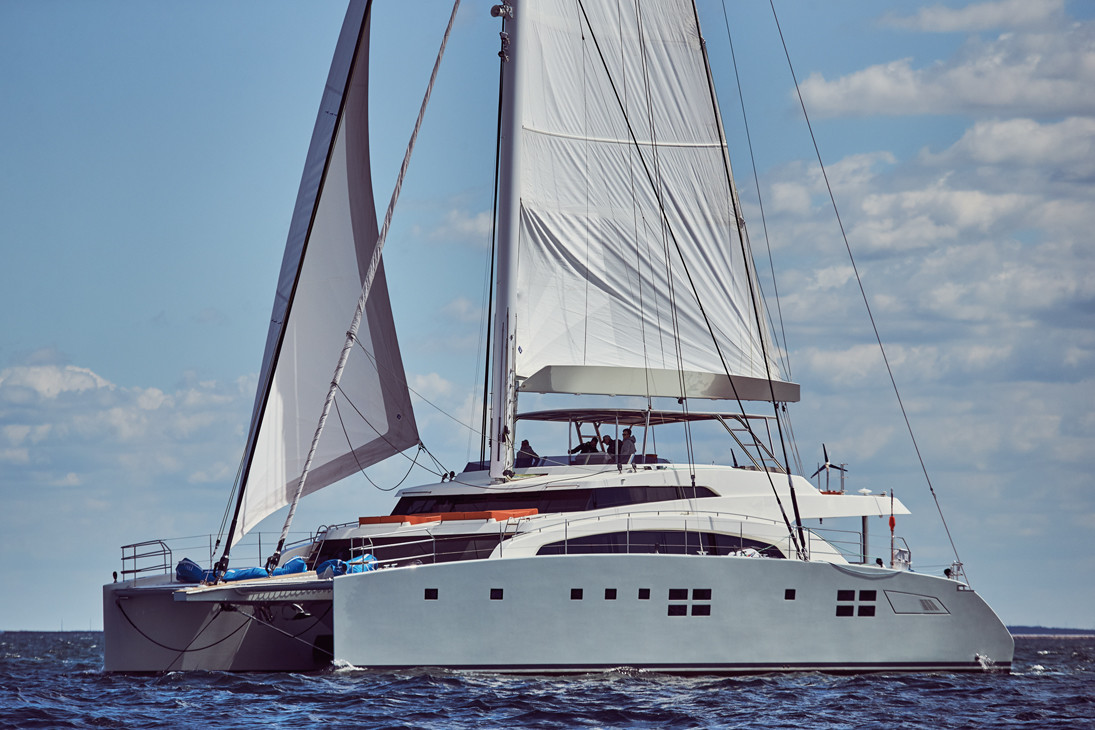
A good average speed to cross the Atlantic or to reach new anchorages in the Caribbean islands after a beautiful summer season in the Mediterranean also guided their choice. It simply remained to find a shipyard capable of satisfying the wishes of the owner. With a budget of more than 4 million euros, this owner was looking for a boat that was not just ultra-equipped and of the highest quality, but a unit that was entirely made ...
To read in full, Buy the boat test
What readers think.
Post a comment
No comments to show.
Share this article
Follow us on, vous avez ajouté " " à vos favoris., vous avez supprimé " " de vos favoris., in order to add this article to your favorites, please sign in..
- Green Propulsion
- Renewable Energy
- Energy efficiency
- Sustainable materials
- News & Events
- Sunreef News Magazine
- Press About Sunreef

- 60 Sunreef Power
- 70 Sunreef Power
- 80 Sunreef Power
- 100 Sunreef Power
- Sunreef Supreme Power
- Sunreef Ultima Range
- Sunreef 44 Ultima
- Sunreef 55 Ultima
- Sunreef 66 Ultima
- Sunreef 77 Ultima
- Sunreef 88 Ultima
- Sunreef fleet

- Sunreef Zero Cat
- Sunreef 100 Eco
- Sunreef Fleet

- Sunreef 43M
- 49M Sunreef Power
- 210 Sunreef Power Trimaran
- Sunreef Explorer
- 40M Sunreef Explorer
- 40M Sunreef Explorer Eco
- 50M Sunreef Explorer
- Superyachts Fleet
Sunreef 88 Double Deck
- Sustainable
DISCOVER THE MODEL
Description.
The start of the ambitious Sunreef 88 Double Deck project was officially communicated during Sunreef Yachts’ press conference at the Cannes Yachting Festival 2016. After eight months of intensive work, the shipyard proudly announced the launch of this catamaran with a zealous, sporty look.
An experienced yachtsman switching from a massive motor yacht , the owner decided to commission the Sunreef 88 Double Deck to pursue a more stable navigation style with greater living space. Indeed, a challenging project for the shipyard’s engineering and design teams.
Nonetheless, this journey was destined to keep the promise of delivering a state-of-the art fully customized sailing catamaran from the start. To achieve the goal of building a seaworthy and dynamic catamaran, Sunreef Yachts’ team of naval architects conceived a completely new yacht design which seemed far sportier than the rest.
Same as all yachts within her range, the Sunreef 88 Double Deck too features a mezzanine level inside the saloon and a spacious master stateroom with a panoramic view in the bow part of the main deck. However, her superstructure was granted a more aerodynamic aspect. As a result, the 88-footer emphasis equally on both performance and luxury, offering over 300m² of living space and an outstanding sailing experience.
Despite this, the Sunreef 88 Double Deck remains a family-friendly yacht offering the best of comfort and safety. The innovative composite superstructure of the sailing yacht conceals a smart and functional layout with luxurious accommodations for eight guests and up to five crew members.
Upon the owners’ request, the interior decor of the Sunreef 88 Double Deck features exclusive natural materials: Chambord oak, linen, leather, natural stone, and quartz tiles – all contribute to the warm and welcoming atmosphere of the sailing yacht . The feeling of warmth was also achieved through applying numerous orange accents to the interiors – an important color for the owner’s family who consider it to be a symbol of energy.
For comprehensive information and guidance on our products, contact us .

SPECIFICATION
- CLASSIC VERSION
Construction
27 m / 88 Ft
Length overall
Beam overall
245 m² / 2637 Ft²
Water capacity
Sunreef Yachts
385 m² / 4145 Ft²
Fuel capacity
2.30 m / 7.5 Ft
180 m² / 1940 Ft²
Comments are closed.
SUBSCRIBE TO OUR NEWSLETTER
- Sailing Yachts
- Power Yachts
- Superyachts
- Making a Change
- Green Concept
- Energy Efficiency
- Sustainable Materials
- ECO Q&A
Copyright © 2024 Sunreef Yachts . All rights reserved.
- Whistleblowing
- Privacy Policy

Sunreef Venture S.A.
Sunreef Yachts Shipyard
ul. Tarcice 6
80-718 Gdańsk, Poland
+48 58 769 77 77
Launched Sunreef Yacht - Not For Sale:
Sunreef 92 dd (92ft)-vessel summary.
BASIC SUMMARY
Dimensions & specifications, hull and deck configuration, engine details.
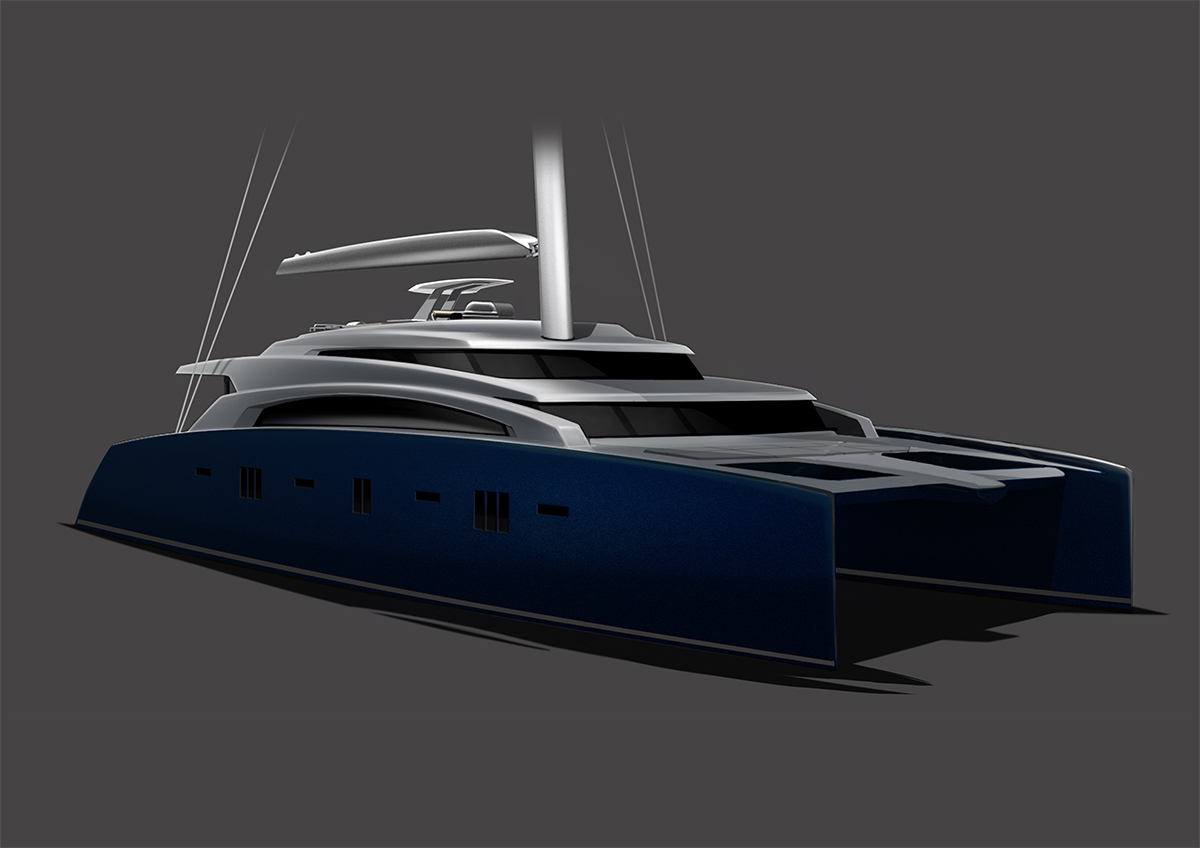
- Update Profile
- Email me when price is activated
- Do you own a boat like this? Sell it now
Boat Description
The Company offers the details of this vessel in good faith but cannot guarantee or warrant the accuracy of this information nor warrant the condition of the vessel. A buyer should instruct his agents, or his surveyors to investigate such details as the buyer desired validated. This vessel is offered subject to prior sale, price change, or withdrawal without notice. Photos may not properly reflect the current condition of the actual vessel offered for sale. In some cases stock photographs may have been used.
Mechanical Disclaimer
Engine and generator hours are as of the date of the original listing and are a representation of what the listing broker is told by the owner and/or actual reading of the engine hour meters. The broker cannot guarantee the true hours. It is the responsibility of the purchaser and/or his agent to verify engine hours, warranties implied or otherwise and major overhauls as well as all other representations noted on the listing.
Dinghy Disclaimer
All dinghies are considered separate vessels and should have separate titles and documents. There is no guarantee as to the title of the dinghy on this vessel so Buyer accepts that while he may receive the dinghy included in the transaction, he may not receive the proper title to it.
- YACHT DESIGN
- YACHT MARKET
- YACHT CLUBS
- YACHT HOTELS
- CHARTER YACHTS
- YACHT SHOWS
- REGATTAS & RACES
YACHT ACCESSORIES
- YACHT APPAREL
- SAILOR GUIDE

- Advertise with Us

New Sunreef 92 Double Deck Sailing Catamaran
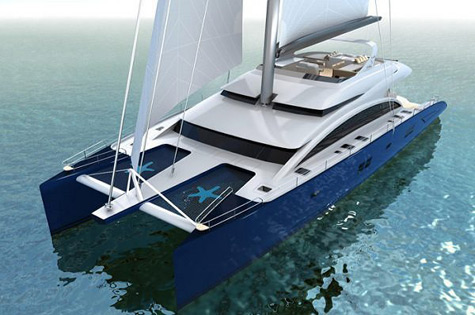
From the same people who brought you the original Sunreef Yacht, comes the new Sunreef 92 Double Deck , with a new design which not only streamlines the deck house, but tops it with a giant 40 m 2 fly bridge.
This was inspired by similar designs found on other super yacht designs. In collaboration with K-Epsilon and Rivoyre Ingenierie , The Sunreef Naval Architecture Bureau has intensely studied performance and sea capabilities using state of the art CFD, computational flow dynamics to create the ultimate in catamaran luxury.
Using integrated stepped hull chins, the Sunreef 92 Double Deck catamaran increases interior space, without compromising performance. Now this yacht can accommodate up to 10 guests, in up to 5 double luxury suites, as well as a crew of four.
Sunreef’s 92 Double Deck also features a canoe style boom and carbon mast, one of this manufacturer’s specialties. How are they able to accomplish such feats? They added a new mezzanine floor, which includes a coffee table and lounge, located on the port side of the main deck dining area, freeing up more space below for larger cabins and storage space, or even more suites if you prefer.
Because of this innovative design modification, now the owner’s suite occupies two floors of the entire front area of this yacht, with a private luxury office, gym and leisure area on the upper level, with the bathroom, wardrobe and storage area below deck. Each cabin has an extended size, three way access to their King sized beds, with spectacular panoramic sea views. Not only this, but each luxury suite comes with its own separate bath and shower area, large closets, storage lockers, as well as their own air conditioning and a comprehensive entertainment system.
With a LOA of 27 meters, an 11.2m beam, and a 1.6m draft, this super yacht has a 80 ton displacement. It will also be powered by two 405HP 1200 L/3170 Gal engines, and will be able to cruise at speeds up to 15 knots. The 70m 2 cockpit will also include a large dining area, sunbathing mattresses, and diving equipment. Its spacious fly bridge is fitted with a jacuzzi, two wet bars, barbecue, ice makers and even a pair of jet skis. It will also include a tender, hidden in a specially built locker under the main sun pad of the cockpit.
Even though this is only the second of such models, it isn’t hard to see why the Sunreef 92 Double Deck sailing catamaran is on it’s way to be one of the most sought after luxury yachts. With it’s innovative design, state of the art electronics, and focus on luxury, the Sunreef 92 Double Deck is top of the line, and a must for people who may still think they have it all. Don’t miss out on your own little piece of paradise.
Sunreef 92 Double Deck specification:
Length overall: 27.00 m/88.85ft Beam maximum: 11.20 m/36.60ft Lightship displacement: 80 T Draft maximum (dagger boat): 1.60 m/5.2 ft Mast clearance: 43.20 m/ 142 ft Mast height: 35.40 m/ 116ft Fully battened main sail: 280 m²/3013 ft² Gennaker: 350 m²/3767 ft² Genoa: 160 m²/1722 ft² Solent: 90 m²/ 968 ft² Main engines: 2 x 405 HP Fuel capacity: 12000 L/3170 Gal Water capacity: 2 x 2000 L/2 x 528 Gal Cruising speed on sails: 15 knots Guests : 10 Crew: 3 Naval Architecture/Design/Builder: Sunreef Yachts
Related links: Sunreef Yachts
Foto: sunreef-yachts.com
- Rivoyre Ingenierie
- Sunreef 92 Double Deck
- Sunreef Catamaran
Related Articles
Skia by design storz: unveiling of a 109-meter superyacht concept, introducing the wallywhy100: a marvel of design and performance, sinot’s beach superyacht series: a symphony of luxury, nature, and sustainability, staying afloat: a guide to survival suits for boaters, navigating waters with ease: top 5 dog ramps for your water-loving pup, unleashing comfort and safety: a guide to essential boat accessories for dogs, unwrapping the top 10 best christmas gifts for yacht enthusiasts, docktail butler elite teak table: elevating yachting experiences with elegance and functionality, exploring the abyss: unveiling the powervision powerray wizard underwater drone, seas of sip: captain ladle and the toadfish tumbler tale, sailing the seas of sound: the fusion® apollo™ ms-srx400 marine zone stereo adventure, water exploration with robosea warp10 water scooter.
OceanShaker.com is a treasure chest of information for people who really "dig" yachts. We believe our project will be a real concoction of beautiful yachts, fresh news, ocean winds and, of course, adventures.
Contact us: [email protected]
© Copyright 2023 - Oceanshaker.com
- AIRPORT LOUNGES / AIRPORT SERVICES

- Montego Bay
- Port Antonio
- South Coast
- Treasure Beach
Where To Stay
Things to do.
- WHERE TO EAT
- AIRPORT LOUNGES
- Airlines that fly to jamaica
- PRIVATE TRANSFERS
- Cruise Ship Ports
- Travel Specialists
- Golf Courses
Welcome Messages
Useful information, airport services, wedding and romance.
- Attractions And Tours
- Nightlife & Entertainment
- Golf & Other Sports
- Arts And Culture
- Off the Beaten Path
- Health And Wellness
- Nature Wildlife And Outdoor
- All Inclusive
- Villas & Boutique Hotels
- Business Hotels
- Budget Accommodations
- Lifestyle And Music
- Brand Jamaica
- Jamaican People
- Food Recipes
- Drink Recipes
Jamaica Travel Stories
- Digital Magazine & Newspaper
Jamaica Diaspora
A seafaring adventure on island routes double-decker catamaran cruise.
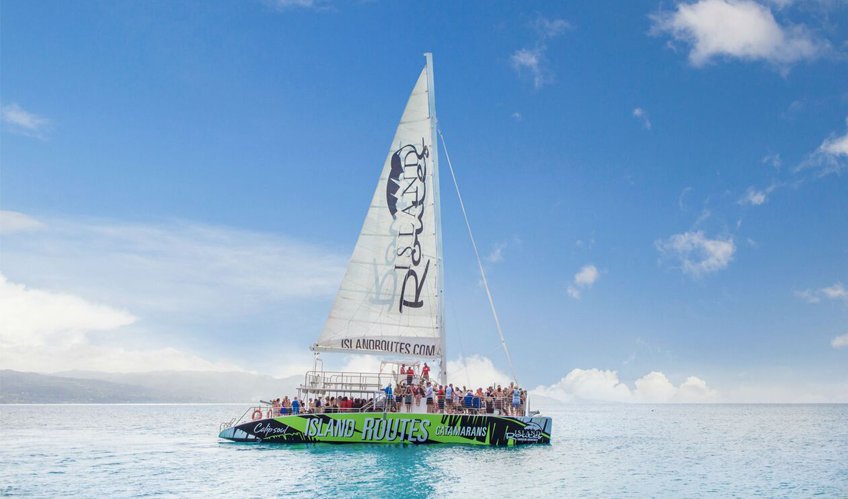
Embark on a luxury catamaran cruise adventure out of Ocho Rios, Jamaica that takes adventure to new heights.
Standing on the dock, I pause a moment to let my gaze travel slowly upwards at the gleaming catamaran floating before me. Rocking gently in the calm Caribbean Sea, the beautiful double-decker Calipsoul seems familiar yet exciting and new to me all at the same time. I had chosen Island Routes Catamaran Dunn’s River Cruise the last time I was in Ocho Rios, Jamaica. It had been the perfect combination of relaxation and excitement that I had been looking for. We had also done the romantic Lovers Rock evening cruise, literally sailing into the sunset together. Making the cruise reservation Both times it had turned out exactly as promised and this time around when I knew I was heading back to Jamaica, I reached out to the wonderfully helpful Island Routes team yet again. I spoke with them about how much I had enjoyed the last catamaran excursion I did with them and shared that this time I would be coming with a group of friends and family of all ages. I had enjoyed the snorkeling aspect of the Dunn’s River cruise so much but it had been fairly short and some of my group said they really wanted to let loose and relax.
Island Routes Reggae Family catamaran cruise They suggested the Island Routes Reggae Family catamaran cruise. They explained that it was like The Dunn’s River cruise minus the climbing, which my mom was happy to hear about, and a lot of time spent exploring the underwater world. Then they told me how great my timing was as they now have a brand new double-decker catamaran! To be honest, I couldn’t quite picture it so I didn’t know what to expect. Standing here, about to step onto the Calipsoul , I am filled with delight as the kids all leap aboard. We aren’t the only family on board that day and as my group is fairly large, coming over on the shuttle service from the Beaches all-inclusive family resort, I had been worried about feeling crowded. Yet, what we discover is the perfect blend of being able to find ample areas for ourselves while also having the opportunity to meet other people as equally excited as we are.
Snorkeling lesson Once in the water, we are directed by the crew, who have joined us, where to swim and, along the way, they make sure to point out coral formations and beautiful fish ensuring we have an amazingly immersive experience (pun intended). I explore for ages and I am very excited as I brought my waterproof camera with me this time and aim to meet my self-imposed challenge of taking an underwater selfie with tropical fish. Although unsuccessful because they move pretty quickly, I still have a blast. Suddenly, someone is tapping me on my shoulder and I pop my head up to see one of the crew members guiding me back to the boat. Making my way back I realize that, as strong a swimmer as I am, I’m pretty happy to have the life vest on as it allows me to keep looking underwater while I make my way back without having to put in too much effort in keeping myself headed in the right direction so all my focus is on the magical world below me. Trampoline for the kids, hammocks for the adults We climb aboard and the teenagers head to the trampoline area (I was told that’s what it’s called). For people who may not normally hang out on a boat, this area serves an engineering purpose but is also a pretty cool place to just hang out on as it’s like a flat stretched-out hammock where you can just lay out and chill. I divest myself of the fins, mask, and vest and realize I’m pretty hungry! Lunch on the ocean Luckily, the food comes out and everyone piles up their plates with tropical fruit, delicious wraps and chips, and salsa, and we head for a sunny spot on the upper deck of the catamaran. We start chatting with other people and decide it’s just about the right time for the rum version of that delicious fruit punch (after all we’re in Jamaica, how can we pass up the delicious rum when no one is driving or diving). My husband opts for a cold Red Stripe instead and leans back to work on his tan. Learning Jamaican dance moves We hear music and a lot of laughter below and realize the trampoline is empty. I decide to leave my husband happily tanning and I follow the music only to discover a full-blown dance class, as the crew is teaching everyone the latest Jamaican dancehall dance moves. Although I feel a little self-conscious when I join in, that quickly fades away as everyone tries their best to match the expertise of the crew. Over on the right, two little girls have their own crew member showing them what to do and they catch on quickly, delighted grins lighting up their faces. I manage to muddle through and I’m pretty sure my sister is going to show these videos to everyone once we get back home for an evening full of a similar level of laughter at my expense. In that moment though, I don’t care. I feel the salt from the sea drying on my skin, my hair is a tousled mess and I’m dancing with my children in the middle of the Caribbean Sea. This, I think, is what happiness is.
Check out the website for more information on Island Routes' catamaran cruises and other excursions they offer in Jamaica and elsewhere in the Caribbean. They’ll help you to book your perfect adventure today! You can also chat online or call US Toll-Free: 1.877.768.8370 Toll-Free Caribbean: 1.800.744.1150 International: 1.305.663.4364
Also, read Take The Driver's East Seat On An Island Routes Mini-Routes Adventure .
Stay tuned for the latest updates and discounts.
Facebook: @IslandRoutes Instagram: @IslandRoutes Twitter: @IslandRoutes

YOU MAY ALSO LIKE

5 scenic drives in Jamaica February 28th, 2017

10 best golf courses in Jamaica March 06th, 2017

10 things to do with kids in Jamaica March 06th, 2017

10 unique experiences in Jamaica March 06th, 2017
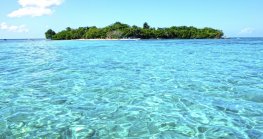
Food, Drink And Recipes

Best of Jamaica
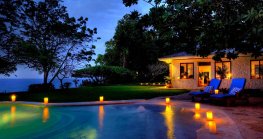
Real Estate
Lounge Experience
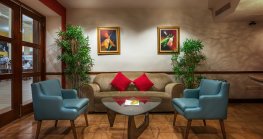
Cannabis Tourism

Posted by Facebook on Thursday, August 27, 2015
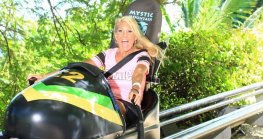
Unleash Your Inner Mystic

10 best golf courses in Jamaica

‘Wha' gwaan goodie’ - a guide to Jamaican greetings
© 2019 Jamaica Experiences All Rights Reserved

The global authority in superyachting
- NEWSLETTERS
- Yachts Home
- The Superyacht Directory
- Yacht Reports
- Brokerage News
- The largest yachts in the world
- The Register
- Yacht Advice
- Yacht Design
- 12m to 24m yachts
- Monaco Yacht Show
- Builder Directory
- Designer Directory
- Interior Design Directory
- Naval Architect Directory
- Yachts for sale home
- Motor yachts
- Sailing yachts
- Explorer yachts
- Classic yachts
- Sale Broker Directory
- Charter Home
- Yachts for Charter
- Charter Destinations
- Charter Broker Directory
- Destinations Home
- Mediterranean
- South Pacific
- Rest of the World
- Boat Life Home
- Owners' Experiences
- Interiors Suppliers
- Owners' Club
- Captains' Club
- BOAT Showcase
- Boat Presents
- Events Home
- World Superyacht Awards
- Superyacht Design Festival
- Design and Innovation Awards
- Young Designer of the Year Award
- Artistry and Craft Awards
- Explorer Yachts Summit
- Ocean Talks
- The Ocean Awards
- BOAT Connect
- Between the bays
- Golf Invitational
- Boat Pro Home
- Pricing Plan
- Superyacht Insight
- Product Features
- Premium Content
- Testimonials
- Global Order Book
- Tenders & Equipment
First Sunreef 88 double deck catamaran launched
The first hull in the Sunreef 88 range of double deck sailing catamarans has been launched in Gdansk for a European owner, the Polish yard has announced.
This fully personalised multihull superyacht measures 26.82 metres LOA and was styled inside and out by the in-house team at Sunreef Yachts .
In a statement, the Polish yard added that the design of the Sunreef 88 is “a great display of the shipyard’s non-conformist attitude and a genuine example of an avant-garde sailing catamaran concept”.
Captain Ian Sellers added: "She is a beautifully crafted, fully customised transoceanic catamaran, with superb quality and finish."
The design brief was focussed on three key themes: luxury, performance and privacy. To this end, the Sunreef 88 features more than 300 square metres of living space — an impressive figure for a yacht of this size, proving that bigger isn't always better .
This two-deck sailing yacht will feature an extensive flybridge with a central helm station and plenty of al fresco dining and relaxation spaces. Back aft, the cockpit features a central dining table with seating space for ten guests as well as a second sunbed, making good use of the Sunreef 88's 11.2 metre beam.
The in-house design includes sporty and dynamic exterior lines, as well as a fully customised interior layout. Key features include a mezzanine level in the saloon and a main-deck owner's cabin , which boasts superb views out to sea through panoramic windows.
Auxiliary power comes from a pair of 425hp engines drawing on a total fuel capacity of 8,000 litres, while her total sailplan is in excess of 345 square metres.
Sunreef added that the designers drew inspiration for this single-masted sailing yacht from the 35 metre flagship yacht Che , which was launched in 2010. The Sunreef 88 is the sixth superyacht from the Polish yard, which has also created the Sunreef 102 yacht Ipharra .
Similar yachts for sale
More stories, most popular, from our partners, sponsored listings.
36 double-decker catamaran
Alexandra resort beach, up to 25 passengers, from $1,680.00, boat details, 32 double-decker catamaran, 'what is included'.
All Your Gear (Fins, Mask, Vest), Beer, Rum Punch, Soft Drinks, Water, Grilled Fish, Gourmet Sandwiches (Half Day), Grilled Chicken (Full Day), Corn on the Cob (Full Day), Grilled Garlic Bread (Full Day), Peas & Rice (Full Day), Light Snacks
'Add-On Options'
Lobster (in season): $30/lb, Charcuterie: Small $70, Medium $120, Large $160,
Tubing: $50 Fishing: $350 + 12 fishing license for guests 16+ years old,
Veuve Clicquot Champagne: $150
'What To Bring'
Reef Safe Sunscreen, Towel, Your own reusable cup
Ice, Soda, Water : Please Check Description
Boat category : Pontoon, Catamaran
Meeting Point : The beach at The Alexandra Resort, just behind the front reception building.
Local Pick Up : Complimentary pick ups are available in the Grace Bay and Leeward areas only.
Food/Snacks : Please Check Description
Paddleboards : No
Specifications
Length : 32
Passenger Capacity : 25
Crew Capacity : 4
Sleep Capacity : 0
Year Built : 2015
Fuel Capacity : 350
Booking options
Boat location.
- How It Works
- About Boatsetter
Popular Regions
- Ibiza , Spain
- Barcelona , Spain
- Cancún , Mexico
- See all regions

DEK KAT 2680
Dek kat 2680 model.
Meet the new standard in nearshore and offshore coastal high-performance catamaran deck boats. With it’s revolutionary twin tunnel hull design, the Dek Kat 2680 is changing the game for inshore fishing by providing a large, stable fishing platform without sacrificing creature comfort options for the family.
BETTER FEATURES
With ample in deck storage, minimal bow rise on acceleration coupled with a shallow water draft of approximately 12”, the Dek Kat is fast becoming an in-shore guide favorite. At 26’ 2” inches long with a beam of 8’6” there is no other bay boat on the market that comes close to her deck space. The twin tunnels provide a stable and comfortable ride even when the weather is not fully cooperative.
If live bait fishing is your game, the 2680 comes standard with two large in deck live/release wells with the option for additional live wells above deck in the forward seating or in our custom leaning post configuration.
MORE COMFORT
The Dek Kat 2680 is a semi-custom built boat which is just as comfortable on the bay waters chasing trout and redfish as it is at the sand bar with your family. Our oversized hard tops keep the family comfortable with the shade and you will find an abundance of seating throughout the boat, including our custom Adirondack style seat built into the console. Built for fishing and comfort cruising, the Dek Kat is truly one of the most versatile bay boat designs out there. It is ready for whatever your weekend desires are upon the water.
BUILD YOUR DEK KAT
352-541-2800.
Email [email protected] Sales 352-222-7202
STAY IN TOUCH
Join our mailing list to stay up to date with our latest announcements!
- Accessibility Statement
COPYRIGHT 2024 © ALL RIGHTS RESERVED.
- Sign In or Register
- Boats for Sale
- Research Boats
- Sell a Boat
- Search Alerts
- My Listings
- Account Settings
- Dealer Advertising
- Deck Boat Catamaran
Deck Boat Catamaran Boats for sale
1-15 of 360
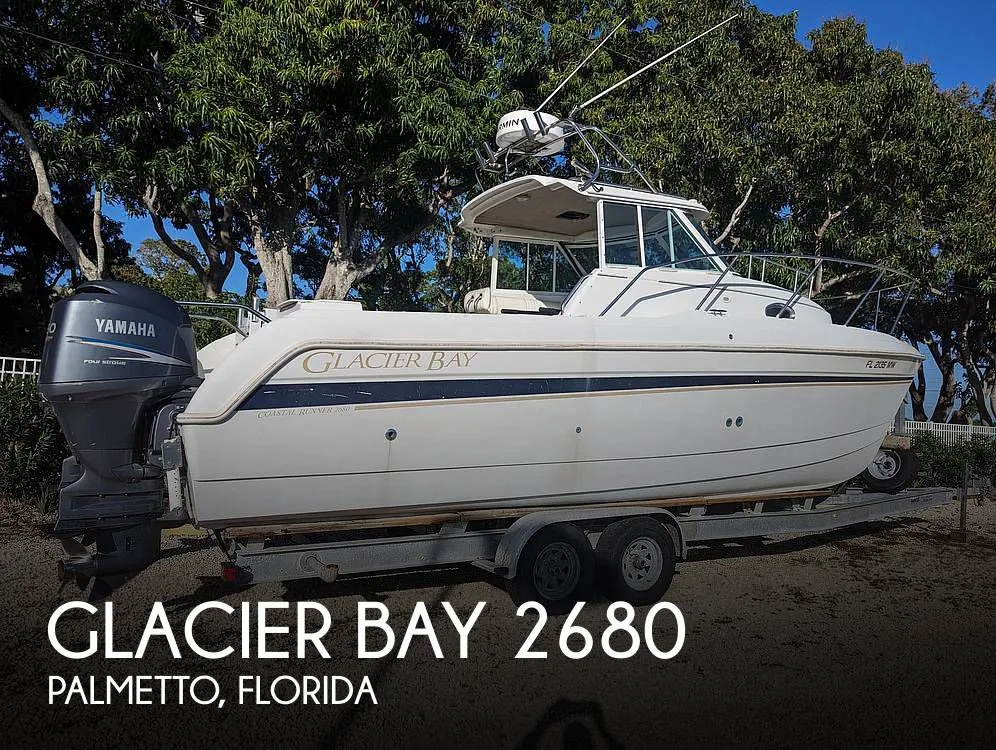
2005 Glacier Bay 2680 Coastal Runner
Palmetto, Florida
Make Glacier Bay
Model 2680 Coastal Runner
Category Power Catamaran Boats
Posted 2 Weeks Ago
This Glacier Bay is in good condition for her age. The seller just had the boat detailed and has a nice hull shine. The hull sides have a nice shine and are free from any major defects. The interior is clean and the electronics have been updated. The cabin is clean and ready for a new owner! Stock #388699 Power Catamaran! Offshore Ready! Just Detailed! Engines Run Great!! 2005 Glacier Bay 2680 Coastal Runner This is a nice power catamaran design with quality construction by Glacier Bay. This Coastal Runner features an interior cabin with room for two to sleep very comfortably and a plumbed head. The dual hull design with its wide beam, and high gunwales creates the perfect combination for a dry, stable ride, even in rough sea days. The cockpit features a wrap-around windshield and side windows with a hardtop overhead with two opening ports. The rear deck area has coaming pads for comfort, a huge live well and access to the integrated swim platform. There are plenty of rod holders and two fish boxes are in the floor. This design allows you to walk around the sides to the bow with handrails. The electronics were recently updated. There is a Garmin GPSMAPS 8612 xsv series 12" touchscreen IPS multifunction display chartplotter-sonar combo with BlueChart G3 and Lakeview G3. A Garmin GT56UHD-TM Traditional CHIRP High wide / UHD Clear-side transducer. A Garmin GMR Fantom 24x White 50 watt Solid State Radar, 60 RPM, 8 Bit Color, Dual Range, Overlay Support, and a Garmin Reactor 40 Hydraulic Corepack with SmartPump with GHC 50 Autopilot that has not been installed yet. Check out all the photos and call today to make it yours! Reason for selling is buying another boat.
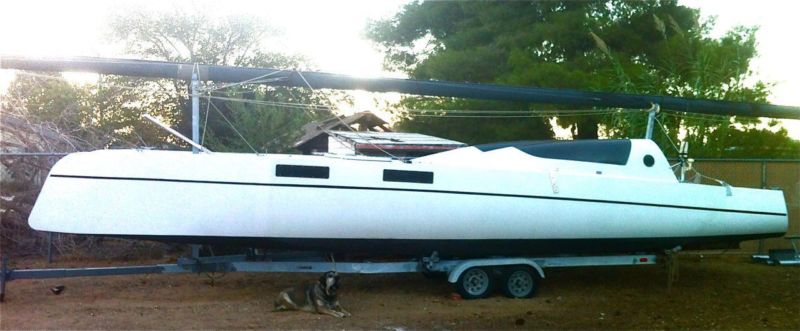
Santa Barbara, California
Posted Over 1 Month
Trailerable 34' catamaran. Demountable. Sets up in 1.75 hours. 34 LOA beam 20 mast 45' from water. This is a very fast cat with no light air problems at all. Brand new sails, sleeping in the hulls. Wave piercing bows. great galvanized trailer. Packs down to 8' wide for the road or shipping container. serious buyers only please. Asking 49k O.B.O. Here is the inventory list. This is quite possibly one of the finest custom Stilettos on earth. . Deluxe trailer. Quick set up. Racer / cruiser. Custom sleeping births in each hull. Professionally reconditioned to "like new" condition in 2005. structural glassed in bed frames with extra floatation, upsized sea hatches, Lewmar winches. 20' beam and transforms into 8' wide for trailering or fit into a shipping container and ship over seas. Set up to single hand. Room for plenty of friends or the whole family. She is wicked fast, handles like a dream with a light helm that is quick and responsive. This cat was originaly a "Stiletto 27" we added a 3' stern extention kit and a wave piercing bow off the Oracle pattern making it a full 34 feet. Length overall 34' Length at water line 34' beam 20' mast hieght from water line 45' Inventory: 12 volt gel cell. 2 Colligo endless line furliers with endless fid lines. 15 hp Mercury motor. starts and runs perfect. VHF radio with stern mounted antenna. Sony Marine AM/FM CD. Marine grade electronic panel with futures 3 12 volt charge adapters New autohelm with custom bracket Rear net/tramp from the webbing material of the big cat "Double Bullets" Two Openable port lights interior forward bow Custom Pro built mast rotator stainless differential Colligo line organizers Four Halyard clutches mast mounted Beautiful new custom centerboard. Garmin GPS Hull mounted GPS antenna. "SPOT" rescue system New gas tank. Galvanized trailer. twin axle New hevey duty hitch Custom built in sink and cabinets with fresh water tank New deluxe Porta Potti Two deck mounted anchor lockers Custom white marine grade cushions in almost new condition. 2 sets of oars new 6 new life jackets in the case. Main sail is full roach glass battens only used a couple times. w/ lazy jacks. Screecher used once. Brand new jib in the bag Second jib. Mylar very used but a lot of sailing left in it. Galvanized trailer with set of removable magnetic lighting. Custom aluminum motor mount Brand new all synthetic rigging . S.E. model with side windows at the head of the births. (Lexan) New Lexan canopies Glass high performance rudders. Two Adjustable tiller handles with shovel grips Center dagger board was custom made ( glass ) high performance foil aprox. 6' tall and its beautiful. New fire extinguisher, tool kit, compass, shade cockpit cover, big anchor with 30 feet of chain and a lot of rode, lots of extra lines and frankly I can't remember all thats in my boat so just come see it. lots of misc. This Catamaran is ready to trailer and sail right now. A ton of money and careful attention has been poured into this boat, Many more extras and lots of photos to serious qualified buyers only please. Shipping can easily be arranged. 49,000 U.S. Dollars

1999 Catamaran Berkstresser Boats 60
Clearwater, Florida
Make Catamaran
Model Berkstresser Boats 60
1999 Catamaran Berkstresser Boats 60 A 60 foot world cruiser, live aboard and term charter sailing catamaran that is fast, long, light, comfortable, efficient and easy to sail (single hand). Low maintenance design provides a safe and unsinkable vessel. Many windows, ports and hatches provide a lite, open and airy interior. Lots of locker space provides storage for gear and toys (dive gear, windsurf, kite and surfboards). Large aft deck for allows ease of setup for tender operation and setting up water toys. Large swim platform and swim steps provides for easy water access. This world cruiser, live aboard or term charter sailing catamaran provide accommodations for 1 to 10 persons in 4 cabins with queen size beds, private heads and showers and two separate crew cabins with single beds and lots of storage. Excellent opportunity exist for new owners to add to an existing fleet or to startup a new business. A real money maker with prior weekly BVI bookings in the $16,000-$22,000 range depending on the dates. Out-of-State buyers can now buy and use their boat in beautiful Florida for 180 days with No Florida Sales Tax! Ask your EYS broker for details.
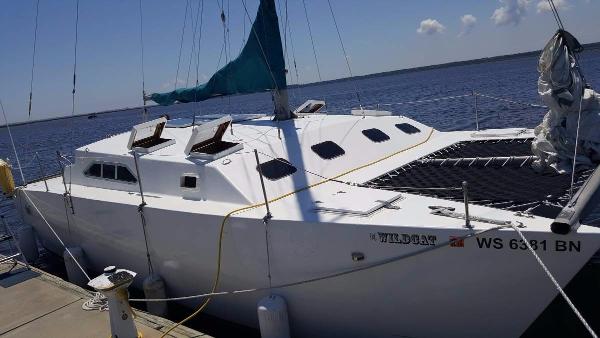
1987 Catamaran Hortsman 34'
Miami, Florida
Model Hortsman 34'
1987 Catamaran Hortsman 34' 34 1987 CATAMARAN HORTSMAN ONLY 70 HOURS PRACTICALLY BRAND NEW 2014 30HP HONDA UPGRADED ENGINE MOUNT AUTO PILOT 2017 SIMRAD GO 7XE CHART PLOTTER WITH SIDEVIEW SONAR 2, 40 GALLON FRESH WATER TANKS SOLAR PANELS UHF RADIO BRAND NEW CUSTOM BENCH BRAND NEW TOPSIDE DECK PAINTED SEA ANCHOR PARACHUTE SYSTEM HEAVY DUTY FRONT ANCHOR AND REAR ANCHOR LED LIGHTING AND TONS OF OTHER ACCESSORIES THAT WILL GO WITH THE BOAT There a ton of extras. We just upgraded everything just about for some blue water traveling. You really need nothing else to do to her. She is turn key at this moment. Financing available if needed.
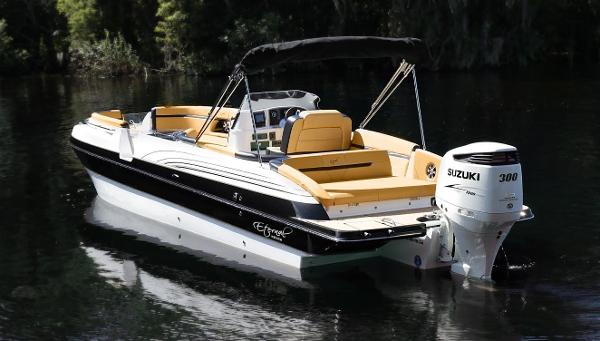
2016 Eternal Boats 28 Catamaran Deck Boat
Dunedin, Florida
Make Eternal Boats
Model 28 Catamaran Deck Boat
Category Deck Boats
2016 Eternal Boats 28 Catamaran Deck Boat Be sure to check out the above video highlighting key features of the boat! America's First True High Performance Catamaran Hull with Deck boat platform. Ladder with shower in front, Eternal door in front, Deck boat seating with plenty of storage underneath. 2 designated cooler areas. Standup porcelain head with electric flush, carbon fiber vanity with sink and shower. Under helm, double helm seat with flip up holster. Touch screen Garmin GPS with 2 digital gauges. All doors are backlit in blue. Under water blue courtesy lights. Back off the boat enhanced with play pen area which electrically raises to reveal additional storage. 2 ladders in the back with shower 1 ladder in front.
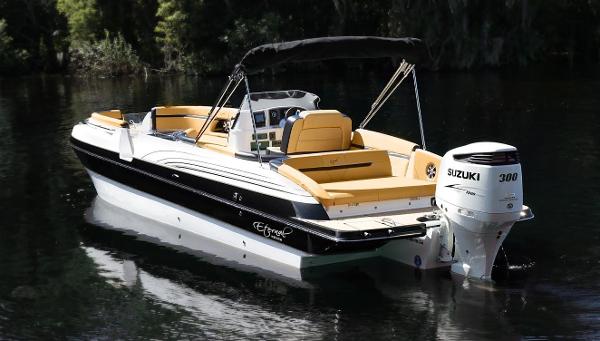
Category Powerboats
2016 Eternal Boats 28 Catamaran Deck Boat America's First True High Performance Catamaran Hull with Deck boat platform. Ladder with shower in front, Eternal door in front, Deck boat seating with plenty of storage underneath. 2 designated cooler areas. Standup porcelain head with electric flush, carbon fiber vanity with sink and shower. Under helm, double helm seat with flip up holster. Touch screen Garmin GPS with 2 digital gauges. All doors are backlit in blue. Under water blue courtesy lights. Back off the boat enhanced with play pen area which electrically raises to reveal additional storage. 2 ladders in the back with shower 1 ladder in front.
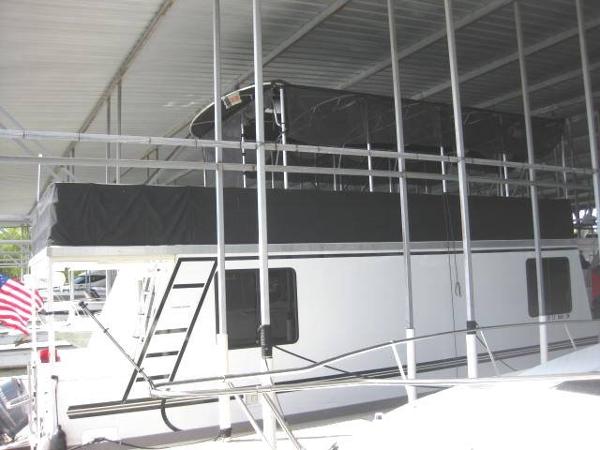
2012 Catamaran Cruisers Custom House Boat
Flower Mound, Texas
Make Catamaran Cruisers
Model Custom House Boat
Category Cruiser Boats
2012 Catamaran Cruisers Custom House Boat GREAT LIVE-A-BOARD!FRESHWATER USE ONLY!YAMAHA 115 FOUR STROKE! ONLY 48 HOURS!AIR CONDITIONING!GENERATOR!This VERY clean 39' x 12' custom houseboat is powered by a fuel efficient Yamaha 115hp four stroke outboard motor with only 48 hours. Wonderful light and bright layout with private stateroom, full galley and large head. Other features include large front and aft covered decks, docking lights, 30 amp shore power, rear & upper deck camera with monitor, depth finder, factory installed generator, roof top air conditioning, 2 flat panel TV's, High Powered Kenwood sound system with multiple speakers including six JL Audio bullet speakers outside and 3 amps, large dinette, sofa sleeper, hot water, stove, M/W, full size frost free refrigerator, private master stateroom with privacy door, large head with marine toilet and huge stall shower, lots of storage space, huge upper deck with custom made aluminum party top canopy and shade screens, fans, large flat screen TV and more. This would make a great live-a-board or weekend cruiser. NO TRAILER! All photos and videos shot October 1, 2016.Located on Lake Lewisville and turn-key ready for use!
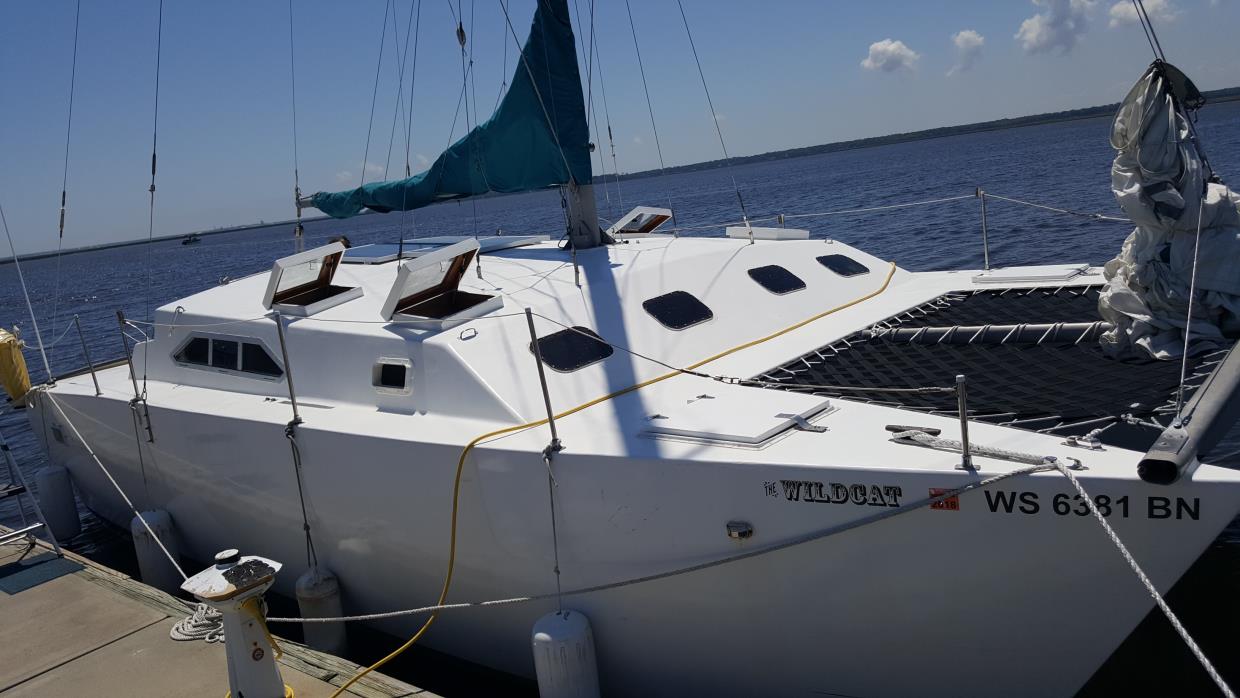
1987 Horstman Catamaran
Palm Beach Gardens, Florida
Make Horstman
Model Catamaran
Category Catamarans
1987 Horstman Catamaran Selling my beautiful sailing Catamaran. She is a 34 ft Hortsman. Built solid from wood and fiberglass. She will not sink. Great for a live aboard or just checking out beautiful places. There a ton of extras. We just upgraded everything just about for some blue water traveling. You really need nothing else to do to her. She is turn key at this moment. Comes with:3 SailsPractically brand new 2014 30hp HondaUpgraded engine mountAuto pilot2017 Simrad Go 7xe Chart plotter with sideview sonar 2016 Generator 2, 40 gallon fresh water tanks Solar panelsUHF radioBrand new custom benchBrand new topside deck paintedSea anchor parachute systemHeavy duty front anchor and rear anchorLED LightingAnd tons of other accessories that will go with the boatCall me at 904-Seven-Zero-Three-8273
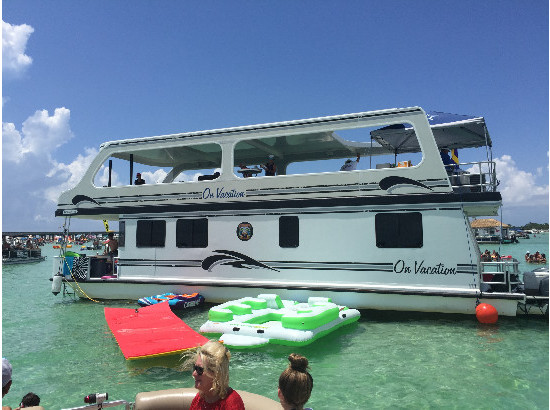
2002 Custom Catamaran
Raceland, Louisiana
Make Custom
Category Houseboats
2002 Custom Catamaran, Comfort on the water doesn't get much better!!!Introducing this 2002 Custom 52ft Catamaran Houseboat "On Vacation" manufactured by Louisiana Houseboats Inc. This 2 bedroom, 2 bath floating home has all the convenience of a fully furnished condominium with the capabilities to change your residency with the crank of an engine. The fully fiberglass hull is powered by twin 250 Yamaha outboards keeping engine maintenance low. The interior was newly refurbished for 2016 with new carpet throughout the boat as well as a new stack Whirlpool washer and dryer in the master. The 2nd story sundeck with fiberglass top features sofa style seating across the bow, with the entire deck being open to the stern maximizing the total area above. Why settle for a vacation home in one location when you can travel the coast without leaving the comfort of your living room sofa?Highlighted Features Include:-2 Bedrooms 2 Bath-New Carpet throughout the boat-New Stack Whirlpool Washer and Dryer-Fully Furnished Living room and Kitchen-Electric Cooktop stove, Oven & Microwave-Full size Refrigerator-Twin Yamaha 250 outboards (2006 model year)-600 gallon Fuel Capacity-600 gallon Fresh Water tank-Onboard Sewage treatment plant-23kw Isuzu Generator-2 50 amp shore power outlets (boats runs on 1)- Fresh water line hookup-Bose Sound system (top deck)**Boat is located in Louisiana on open waterways, No landlock transportation cost** $170000.00
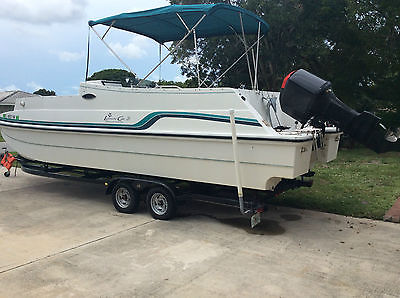
Leisure Cat 26 Catamaran Deck Boat with Trailer
Naples, Florida
Model Leisure Cat 26
Length 26.0
Leisure Cat 26 Catamaran Deck Boat with Trailer. Anchor & line, large bimini top, aft swim ladder, full cover, seat cushions, fresh water shower, and full lighted gauges. Power: 1998 225 HP Mercury outboard motor - serviced this year and runs perfectly. 2 new batteries and internal battery charger. 80 gallon fuel tank. Max capacity of 12 passengers. 2013 Bear Tritoon Trailer. Holds 24 to 26 foot Tritoon. Model PB 13-26TTL. 2 axles with drum brakes, adjustable rails, and in great condition.
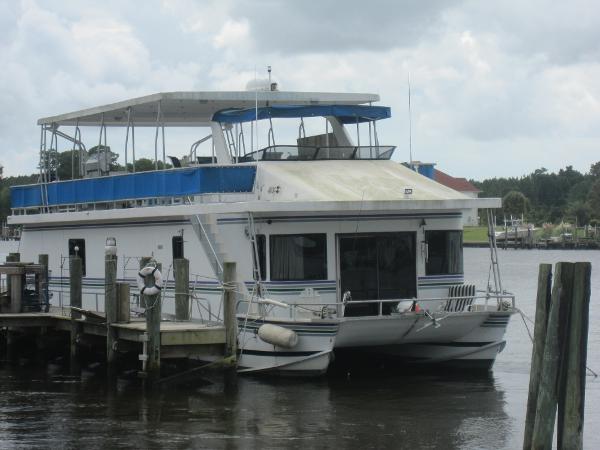
1998 New Orleans Catamaran House Boat
Wilmington, North Carolina
Make New Orleans
Model Catamaran House Boat
Category Power Catamarans
1998 New Orleans Catamaran House Boat Huge cruising home with trawler economy. With her 2002 straight inboard, prop protected 310hp cummins diesels. This three stateroom two head floating home has it all, from her upper and lower steering stations to her forward and aft decks and her massive upper deck for entertaining!!! Also available is the waterfront non-buildable lot w/90'x60' T-dock for $150K. Owner will give the buyer of the boat 6 months free dockage or will finance the sell of the land and dock.
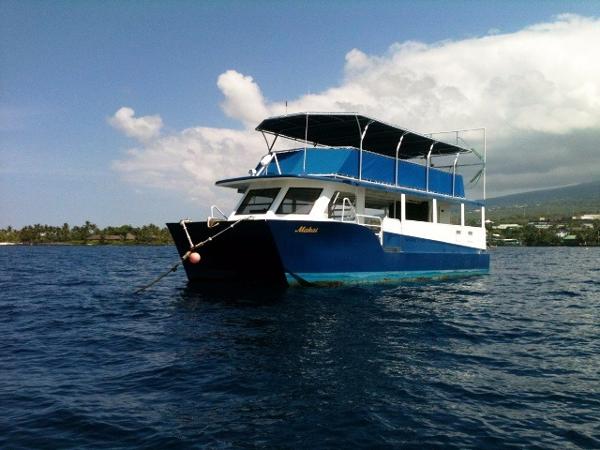
1991 Sea taxi Custom Catamaran Dive Boat
Fort Lauderdale, Florida
Make Sea Taxi
Model Custom Catamaran Dive Boat
1991 Sea taxi Custom Catamaran Dive Boat The Makai is 46 ft long 16ft wide 2-deck power catamaran. It is USCG inspected for 84 passengers. It has been used for sight seeing tours, snorkeling and scuba tours, sunset cruises, whale watching, private events and tendering for cruises ships, private yachts and the military.The vessel has 2 restrooms, fresh water shower, concessions bar, dive/swim ladder and upper deck lounge with cushioned seating. It just completed its bi-annual dry dock an annual inspection. Its hulls are solid fiberglass with glass over wood wing. Registered Dimensions: 46' x 16.4' x 5.2' Tonnage: 11 Gross / 8 Net Type/Trade: Twin Diesel Catamaran / USCG Passenger-Inspected, Coastwise Built in 1991 Opa Locka, Florida and re-powered in 2005. ADDITIONAL PERMIT AVAILABLE FOR PURCHASE: State of Hawaii commercial permit and mooring permit. This permit allows commercial operation from the Kailua Kona Hawaii pier in the heart of Kona. This pier is Kona’s cruise ship port which sees weekly cruise ship visitations. These permits are limited by the State of Hawaii.
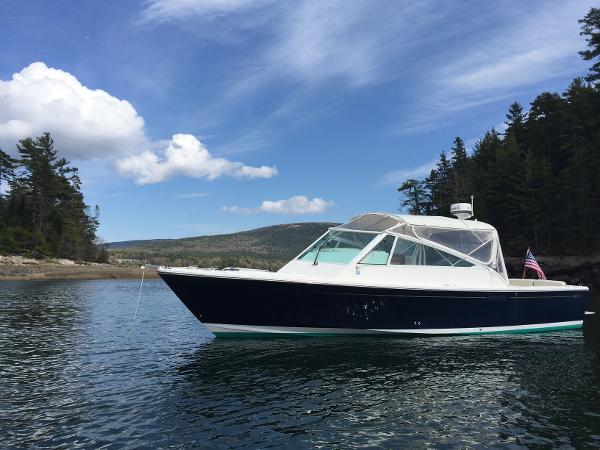
2012 Catamaran Coaches Trimaran
Make Catamaran Coaches
Model Trimaran
2012 Catamaran Coaches Trimaran PRICE REDUCTION! Want the most awesome deck boat ? Or are you thinking about launching a wildlife-watching, sea-touring, flats-fishing, kayaking, paddle-boarding or water yoga and shelling excursion business? THIS IS THE BOAT FOR YOU Custom composite and aluminum-railed 26-foot trimaran draws only 18 inches Two battery banks and an inverter power it all Great sound system Dance on the top deck or store kayaks and paddle boards there Lowrance chart plotter, VHF, live wells, wash down pump & filet table Ready for family fun or create your own business. Custom seating and a private head for your comfort Recent bottom paint No slip fees because a heavy-duty tri-axle aluminum trailer is included. Powered by a low-time (600 hours) Yamaha F350, this Florida-manufactured custom trimaran is strong, fast and reliable. Arrange a showing today.

Narrow Results
Current search reset all.
- Keyword: deck boat catamaran
- Wellcraft (19)
- Glacier Bay (11)
- Twin Vee (7)
- Glastron (5)
- Robertson And Caine (5)
- Sea Fox (5)
- Catamaran Cruisers (4)
- Fountaine Pajot (4)
- World Cat (4)
- Catamaran (3)
- 2 Criag Cats, 2 Mini Speed Boats,2 Jet Skis (2)
- Bayliner (2)
- CATAMARAN CRUISER (2)
- COBALT BOATS (2)
- Carolina Skiff (2)
- Catamaran Coaches (2)
- Catamaran Cruiser (2)
- Eternal Boats (2)
- Hysucat (2)
- Probio Plastic Boat (2)
- Sea Cat (2)
- Seawind (2)
- Splendor (2)
- 33rd Strike Group (1)
- 33rd Strike Group Power Catamaran (1)
- Advantage (1)
- Armadia (1)
- Barracuda (1)
- Beachcat (1)
- BoatYard (1)
- Carolina Cat (1)
- Chaparral (1)
- Desert Shore Yachts (1)
- Destination (1)
- Eliminator (1)
- Eric Lerouge (1)
- Force Engineering (1)
- Four Winns (1)
- GLACIER BAY (1)
- Glacier Bay* (1)
- Gulf Coast (1)
- H2X Custom (1)
- Hobie Cat (1)
- Horstman (1)
- Island Hopper (1)
- Island Packet (1)
- Lightning Power Boats (1)
- Mowdy Boats (1)
- New Orleans (1)
- OFFSHORE CATAMARANS (1)
- Ocean Cat (1)
- Pedigree (1)
- Perfection Boats (1)
- Pro Sports (1)
- Robertson & Caine (1)
- Sea Taxi (1)
- Shoalwater (1)
- Shuttleworth (1)
- Solaris (1)
- Sport Cat (1)
- Sportcraft (1)
- WorldCat (1)
- Catamarans (17)
- Power Catamarans (17)
- Sport Fishing Boats (11)
- Power Catamaran Boats (9)
- Powerboats (8)
- Center Consoles (7)
- Deck Boats (7)
- Houseboats (7)
- Sailboats (6)
- Bowrider Boats (5)
- Cruiser Boats (5)
- Bay Boats (4)
- Dual Console Boats (4)
- Fishing Boats (4)
- Center Console Boats (3)
- Racer Boats (3)
- Saltwater Fishing Boats (3)
- Catamaran Sailboats (2)
- Tender Boats (2)
- Aft Cabin (1)
- Aluminum Fishing Boats (1)
- Cuddy Cabin Boats (1)
- Flats Boats (1)
- Inflatable Boats (1)
- Motor Yachts (1)
- Pilothouse Boats (1)
- Pontoon Boats (1)
- Skiff Boats (1)
- Small Boats (1)
- Trawler Boats (1)
- Walkarounds (1)
- Florida (267)
- California (9)
- New York (8)
- Tennessee (7)
- North Carolina (6)
- Washington (6)
- Maryland (5)
- Connecticut (3)
- New Jersey (3)
- South Carolina (3)
- Virginia (3)
- British Columbia (2)
- England (2)
- Georgia (2)
- Illinois (2)
- Louisiana (2)
- Minnesota (2)
- West Virginia (2)
- Colorado (1)
- District Of Columbia (1)
- Eastern Cape (1)
- Kentucky (1)
- Massachusetts (1)
- Michigan (1)
- Mississippi (1)
- Provence-Alpes-Cote D'Azur (1)
- POP Yachts (9)
- Search Title Only
- Has Picture
- Include Sold Listings
Showcase Ads

2003 Harbor Master 520 Wide Body
Lecanto, FL

1998 ShoreLand'r LEB46TCBL

2006 Boston Whaler 150 Montauk
Chenequa, WI

2004 Sea Ray 270 Sundeck
Phoenix, AZ

2016 Malibu Wakesetter 22 MXZ
Browns Summit, NC

2004 Sea Ray 260 Sundancer
University of Richmond, VA

2010 Tige Z1
Create Alert
Please, name this search
Select Interval
Alert Successfully Created
- 1-855-932-1711
- My Account Hello Credits My Account Log out
Catamaran Sightseeing Cruise: Sea, Salt & Klein Bonaire
Kralendijk, Bonaire
Activity Level
Excursion Type
Local Sightseeing,25,All
Wheelchair Accessible
Starting At
Minimum Age
Information Not Currently Available
Approximately 2 Hours
Meals Included
Meals not included
Savor Bonaire's breathtaking seascapes from the Sea Breeze double-decker power catamaran .
You'll stop at the famous pink salt flats and white mountains of salt. Your guide will explain the salt production process.
Offshore from the historical white slave huts, learn some Caribbean facts and discover why these centuries-old huts are built next to the sea.
The catamaran approaches the uninhabited island of Klein Bonaire by way of the famous Bonaire Marine Park . Its protected reef makes it a divers' paradise. From up close, you will see Bonaire's most attractive white-sand beach. Its name, of course, is No-Name Beach.
Follow the coastline for exceptional panoramic views, and don't forget to look down into the crystal-clear turquoise water. Oceanfront hotels and restaurants and beautiful Dutch Caribbean mansions line the way back to the port.
Maximum age is 70 years. Maximum height is 6'6". Maximum weight is 330 lbs. Guests who are more than five months pregnant or have a heart condition, asthma, or leg or chest injuries and/or recent surgery are not allowed to participate. Not advisable for guests with mobility limitations.
- Popular Professionals
- Design & Planning
- Construction & Renovation
- Finishes & Fixtures
- Landscaping & Outdoor
- Systems & Appliances
- Interior Designers & Decorators
- Architects & Building Designers
- Design-Build Firms
- Kitchen & Bathroom Designers
- General Contractors
- Kitchen & Bathroom Remodelers
- Home Builders
- Roofing & Gutters
- Cabinets & Cabinetry
- Tile & Stone
- Hardwood Flooring Dealers
- Landscape Contractors
- Landscape Architects & Landscape Designers
- Home Stagers
- Swimming Pool Builders
- Lighting Designers and Suppliers
- 3D Rendering
- Sustainable Design
- Basement Design
- Architectural Design
- Universal Design
- Energy-Efficient Homes
- Multigenerational Homes
- House Plans
- Home Remodeling
- Home Additions
- Green Building
- Garage Building
- New Home Construction
- Basement Remodeling
- Stair & Railing Contractors
- Cabinetry & Cabinet Makers
- Roofing & Gutter Contractors
- Window Contractors
- Exterior & Siding Contractors
- Carpet Contractors
- Carpet Installation
- Flooring Contractors
- Wood Floor Refinishing
- Tile Installation
- Custom Countertops
- Quartz Countertops
- Cabinet Refinishing
- Custom Bathroom Vanities
- Finish Carpentry
- Cabinet Repair
- Custom Windows
- Window Treatment Services
- Window Repair
- Fireplace Contractors
- Paint & Wall Covering Dealers
- Door Contractors
- Glass & Shower Door Contractors
- Landscape Construction
- Land Clearing
- Garden & Landscape Supplies
- Deck & Patio Builders
- Deck Repair
- Patio Design
- Stone, Pavers, & Concrete
- Paver Installation
- Driveway & Paving Contractors
- Driveway Repair
- Asphalt Paving
- Garage Door Repair
- Fence Contractors
- Fence Installation
- Gate Repair
- Pergola Construction
- Spa & Pool Maintenance
- Swimming Pool Contractors
- Hot Tub Installation
- HVAC Contractors
- Electricians
- Appliance Services
- Solar Energy Contractors
- Outdoor Lighting Installation
- Landscape Lighting Installation
- Outdoor Lighting & Audio/Visual Specialists
- Home Theater & Home Automation Services
- Handyman Services
- Closet Designers
- Professional Organizers
- Furniture & Accessories Retailers
- Furniture Repair & Upholstery Services
- Specialty Contractors
- Color Consulting
- Wine Cellar Designers & Builders
- Home Inspection
- Custom Artists
- Columbus, OH Painters
- New York City, NY Landscapers
- San Diego, CA Bathroom Remodelers
- Minneapolis, MN Architects
- Portland, OR Tile Installers
- Kansas City, MO Flooring Contractors
- Denver, CO Countertop Installers
- San Francisco, CA New Home Builders
- Rugs & Decor
- Home Improvement
- Kitchen & Tabletop
- Bathroom Vanities
- Bathroom Vanity Lighting
- Bathroom Mirrors
- Bathroom Fixtures
- Nightstands & Bedside Tables
- Kitchen & Dining
- Bar Stools & Counter Stools
- Dining Chairs
- Dining Tables
- Buffets and Sideboards
- Kitchen Fixtures
- Wall Mirrors
- Living Room
- Armchairs & Accent Chairs
- Coffee & Accent Tables
- Sofas & Sectionals
- Media Storage
- Patio & Outdoor Furniture
- Outdoor Lighting
- Ceiling Lighting
- Chandeliers
- Pendant Lighting
- Wall Sconces
- Desks & Hutches
- Office Chairs
- View All Products
- Side & End Tables
- Console Tables
- Living Room Sets
- Chaise Lounges
- Ottomans & Poufs
- Bedroom Furniture
- Nightstands
- Bedroom Sets
- Dining Room Sets
- Sideboards & Buffets
- File Cabinets
- Room Dividers
- Furniture Sale
- Trending in Furniture
- View All Furniture
- Bath Vanities
- Single Vanities
- Double Vanities
- Small Vanities
- Transitional Vanities
- Modern Vanities
- Houzz Curated Vanities
- Best Selling Vanities
- Bathroom Vanity Mirrors
- Medicine Cabinets
- Bathroom Faucets
- Bathroom Sinks
- Shower Doors
- Showerheads & Body Sprays
- Bathroom Accessories
- Bathroom Storage
- Trending in Bath
- View All Bath
- How to Choose a Bathroom Vanity

- Patio Furniture
- Outdoor Dining Furniture
- Outdoor Lounge Furniture
- Outdoor Chairs
- Adirondack Chairs
- Outdoor Bar Furniture
- Outdoor Benches
- Wall Lights & Sconces
- Outdoor Flush-Mounts
- Landscape Lighting
- Outdoor Flood & Spot Lights
- Outdoor Decor
- Outdoor Rugs
- Outdoor Cushions & Pillows
- Patio Umbrellas
- Lawn & Garden
- Garden Statues & Yard Art
- Planters & Pots
- Outdoor Sale
- Trending in Outdoor
- View All Outdoor
- 8 x 10 Rugs
- 9 x 12 Rugs
- Hall & Stair Runners
- Home Decor & Accents
- Pillows & Throws
- Decorative Storage
- Faux Florals
- Wall Panels
- Window Treatments
- Curtain Rods
- Blackout Curtains
- Blinds & Shades
- Rugs & Decor Sale
- Trending in Rugs & Decor
- View All Rugs & Decor
- Pendant Lights
- Flush-Mounts
- Ceiling Fans
- Track Lighting
- Wall Lighting
- Swing Arm Wall Lights
- Display Lighting
- Table Lamps
- Floor Lamps
- Lamp Shades
- Lighting Sale
- Trending in Lighting
- View All Lighting
- Bathroom Remodel
- Kitchen Remodel
- Kitchen Faucets
- Kitchen Sinks
- Major Kitchen Appliances
- Cabinet Hardware
- Backsplash Tile
- Mosaic Tile
- Wall & Floor Tile
- Accent, Trim & Border Tile
- Whole House Remodel
- Heating & Cooling
- Building Materials
- Front Doors
- Interior Doors
- Home Improvement Sale
- Trending in Home Improvement
- View All Home Improvement
- Cups & Glassware
- Kitchen & Table Linens
- Kitchen Storage and Org
- Kitchen Islands & Carts
- Food Containers & Canisters
- Pantry & Cabinet Organizers
- Kitchen Appliances
- Gas & Electric Ranges
- Range Hoods & Vents
- Beer & Wine Refrigerators
- Small Kitchen Appliances
- Cookware & Bakeware
- Tools & Gadgets
- Kitchen & Tabletop Sale
- Trending in Kitchen & Tabletop
- View All Kitchen & Tabletop
- Storage & Organization
- Baby & Kids
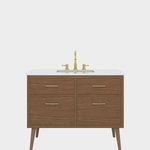
- View all photos
- Dining Room
- Breakfast Nook
- Family Room
- Bed & Bath
- Powder Room
- Storage & Closet
- Outdoor Kitchen
- Bar & Wine
- Wine Cellar
- Home Office
- Popular Design Ideas
- Kitchen Backsplash
- Deck Railing
- Privacy Fence
- Small Closet
- Stories and Guides
- Popular Stories
- Renovation Cost Guides
- Fence Installation Cost Guide
- Window Installation Cost Guide
- Discussions
- Design Dilemmas
- Before & After
- Houzz Research
- View all pros
- View all services
- View all products
- View all sales
- Living Room Chairs
- Dining Room Furniture
- Coffee Tables
- Home Office Furniture
- Join as a Pro
- Interior Design Software
- Project Management
- Custom Website
- Lead Generation
- Invoicing & Billing
- Landscape Contractor Software
- General Contractor Software
- Remodeler Software
- Builder Software
- Roofer Software
- Architect Software
- Takeoff Software
- Lumber & Framing Takeoffs
- Steel Takeoffs
- Concrete Takeoffs
- Drywall Takeoffs
- Insulation Takeoffs
- Stories & Guides
- LATEST FROM HOUZZ
- HOUZZ DISCUSSIONS
- SHOP KITCHEN & DINING
- Kitchen & Dining Furniture
- Sinks & Faucets
- Kitchen Cabinets & Storage
- Knobs & Pulls
- Kitchen Knives
- KITCHEN PHOTOS
- FIND KITCHEN PROS
- Bath Accessories
- Bath Linens
- BATH PHOTOS
- FIND BATH PROS
- SHOP BEDROOM
- Beds & Headboards
- Bedroom Decor
- Closet Storage
- Bedroom Vanities
- BEDROOM PHOTOS
- Kids' Room
- FIND DESIGN PROS
- SHOP LIVING
- Fireplaces & Accessories
- LIVING PHOTOS
- SHOP OUTDOOR
- Pool & Spa
- Backyard Play
- OUTDOOR PHOTOS
- FIND LANDSCAPING PROS
- SHOP LIGHTING
- Bathroom & Vanity
- Flush Mounts
- Kitchen & Cabinet
- Outdoor Wall Lights
- Outdoor Hanging Lights
- Kids' Lighting
- Decorative Accents
- Artificial Flowers & Plants
- Decorative Objects
- Screens & Room Dividers
- Wall Shelves
- About Houzz
- Houzz Credit Cards
- Privacy & Notice
- Cookie Policy
- Your Privacy Choices
- Mobile Apps
- Copyright & Trademark
- For Professionals
- Houzz vs. Houzz Pro
- Houzz Pro vs. Ivy
- Houzz Pro Advertising Reviews
- Houzz Pro 3D Floor Planner Reviews
- Trade Program
- Buttons & Badges
- Your Orders
- Shipping & Delivery
- Return Policy
- Houzz Canada
- Review Professionals
- Suggested Professionals
- Accessibility
- Houzz Support
- COUNTRY COUNTRY
Deck Builders & Contractors in Elektrostal'
Location (1).
- Use My Current Location
Popular Locations
- Albuquerque
- Cedar Rapids
- Grand Rapids
- Indianapolis
- Jacksonville
- Kansas City
- Little Rock
- Los Angeles
- Minneapolis
- New Orleans
- Oklahoma City
- Orange County
- Philadelphia
- Portland Maine
- Salt Lake City
- San Francisco
- San Luis Obispo
- Santa Barbara
- Washington D.C.
- Elektrostal', Moscow Oblast, Russia
Featured Reviews for Deck Builders & Contractors in Elektrostal'
- Reach out to the pro(s) you want, then share your vision to get the ball rolling.
- Request and compare quotes, then hire the Decks, Patio & Outdoor Enclosures professional that perfectly fits your project and budget limits.
- Deck Building
- Deck Lighting Installation
- Deck Refinishing
- Deck Staining
- Deck Waterproofing
- Gazebo Design & Construction
Some of the best decking materials include:
- Wood: Cedar, redwood, and tropical hardwoods offer a classic look but require regular maintenance.
- Pressure-Treated Lumber: Affordable pine that resists rot and insects but may need staining.
- Composite Decking: Low-maintenance blend of wood fibers and recycled plastic, available in various colors.
- PVC Decking: Synthetic option resistant to stains, scratches, and fading, but can be pricey.
- Aluminum Decking: Lightweight, durable, rust-resistant, suitable for water areas, but more expensive.
- Vinyl Decking: Low-maintenance, moisture, and rot-resistant, but quality varies.
It’s better to build a patio when:
- Privacy is a priority: Patio provides a sense of privacy, especially when enclosed.
- Budget and low maintenance are the priority: Patios are generally more cost-effective to build and require less maintenance.
- The ground is flat: For even ground, constructing a patio is easier and more straightforward.
It’s better to build a deck when:
- Scenic views are desired: Decks offer better views.
- You are fine with obtaining building permits and inspections: Decks typically require permits and inspections due to their structural impact on the home.
- The ground is uneven: If your backyard has slopes or uneven terrain, a deck can provide a stable and level outdoor space.
What services do deck and patio companies in Elektrostal', Moscow Oblast, Russia provide?
Questions to ask a prospective elektrostal', moscow oblast, russia deck installers and patio builder:, business services, connect with us.
Things to Do in Elektrostal, Russia - Elektrostal Attractions
Things to do in elektrostal.
- 5.0 of 5 bubbles
- 4.0 of 5 bubbles & up
- Good for a Rainy Day
- Good for Kids
- Good for Big Groups
- Adventurous
- Budget-friendly
- Hidden Gems
- Good for Couples
- Honeymoon spot
- Good for Adrenaline Seekers
- Things to do ranked using Tripadvisor data including reviews, ratings, photos, and popularity.

1. Electrostal History and Art Museum

2. Statue of Lenin

3. Park of Culture and Leisure
4. museum and exhibition center.

5. Museum of Labor Glory

7. Galereya Kino
8. viki cinema, 9. smokygrove.

10. Gandikap
11. papa lounge bar, 12. karaoke bar.
- Statue of Lenin
- Electrostal History and Art Museum
- Park of Culture and Leisure
- Museum and Exhibition Center
- Museum of Labor Glory

test. The Sunreef 88 DD hasn't forgotten any of the rules of super-yachting. Attention to detail and refinement is everywhere on board, making life enjoyable. The cockpit interior offers a good view forward across the water. From here, you can handle the boat while staying warm during night watches.
At the water, the Portless Catamaran inflates into an impressive 14.8-foot (4.5-m) cat with upper and lower decks designed to accommodate a total of six people. It's meant to go from car trunk to ...
The start of the ambitious Sunreef 88 Double Deck project was officially communicated during Sunreef Yachts' press conference at the Cannes Yachting Festival 2016. After eight months of intensive work, the shipyard proudly announced the launch of this catamaran with a zealous, sporty look. An experienced yachtsman switching from a massive ...
The Sunreef 92 Double Deck features almost 430 square meters of living space, twice as much as the Sunreef 82 Double Deck introduced in 2012. The enlarged deckhouse gives the owners greater comfort and the possibility to invite even more guests on a luxury cruise. The yacht will comfortably accommodate up to 12 guests giving each of them the ...
The double decker is capable of carrying 200 passengers out of the US,and 149 in US waters. The price is the base price without power and can be customized to fit your needs. This boat is fast and economical. Ron Cooper has built over 165 passenger catamarans, from 39' to 107'.
Using integrated stepped hull chins, the Sunreef 92 Double Deck catamaran increases interior space, without compromising performance. Now this yacht can accommodate up to 10 guests, in up to 5 double luxury suites, as well as a crew of four. ... Draft maximum (dagger boat): 1.60 m/5.2 ft
Check out the website for more information on Island Routes' catamaran cruises and other excursions they offer in Jamaica and elsewhere in the Caribbean. They'll help you to book your perfect adventure today! You can also chat online or call. US Toll-Free: 1.877.768.8370. Toll-Free Caribbean: 1.800.744.1150.
The first hull in the Sunreef 88 range of double deck sailing catamarans has been launched in Gdansk for a European owner, the Polish yard has announced. This fully personalised multihull superyacht measures 26.82 metres LOA and was styled inside and out by the in-house team at Sunreef Yachts.
To sum it up, embarking on a double-decker catamaran tour to discover Isla Mujeres is an incredible adventure that combines natural beauty, snorkeling, and island exploration. With the convenience of making a reservation and paying later, along with free cancellation up to 24 hours in advance, this tour offers flexibility for travelers.
32 Double-Decker Catamaran36 ft double deck power catamaran that can accommodate up to 30 guests comfortably. It features a built in bar, 2 loungers on the top deck, a diving board, a waterslide and bathroom. This is a great boat for a private charter.'What is Included' All Your Gear (Fins, Mask, Vest), Beer, ...
Spend the day soaking up the rays on the Caribbean Sea and Isla Mujeres when you book this great-value double-decker catamaran cruise with open bar. Stop to snorkel in the open sea, amid vibrant fish, coral and sculptures. Next, savor a delicious buffet lunch at an island beach club, with free time before you sail back to Cancun amid a spectacular sunset. Upgrade for transfers; all packages ...
Meet the new standard in nearshore and offshore coastal high-performance catamaran deck boats. With it's revolutionary twin tunnel hull design, the Dek Kat 2680 is changing the game for inshore fishing by providing a large, stable fishing platform without sacrificing creature comfort options for the family. Build Your Dek Kat.
Isla Mujeres Catamaran Tour with Snorkel, Open bar and Transportation from hotel. 1,088. Spring Break. from. $75.00. per adult (price varies by group size) Catamaran Tour to Isla Mujeres from Cancún with Bar and Lunch. 10.
Bays of Huatulco and Snorkeling on a Double Decker Catamaran cancellation policy: For a full refund, cancel at least 24 hours in advance of the start date of the experience. ... Surf was rough even for the large boat and 1 person got sea sick. Snorkelling was very good. The crew was great and we had a lot of fun. Read more. Written December 1 ...
Leisure Cat 26 Catamaran Deck Boat with Trailer. Anchor & line, large bimini top, aft swim ladder, full cover, seat cushions, fresh water shower, and full lighted gauges. Power: 1998 225 HP Mercury outboard motor - serviced this year and runs perfectly. 2 new batteries and internal battery charger. 80 gallon fuel tank.
Our Happy Fish II, is a Double Decker 34 feet Motor Catamaran with capacity for 30 guests that will give you a different experience of cruising along the Punta Cana and Cape Engaño crystal clear shallow waters. The Happy Fish II is a very accommodating boat, it has 1 bathroom, a Slide Toboggan, big shade area, upper deck and sound system.
Happy Fish II. Our Happy Fish II, is a Double Decker 34 feet Motor Catamaran with capacity for 30 guests that will give you a different experience of cruising along the Punta Cana and Cape Engaño crystal clear shallow waters. Only offered for Private Tours. The Happy Fish II is a very accommodating boat, it has 1 bathroom, a Slide Toboggan ...
Our Catamaran Party Boat Tour is a MUST when it comes to Punta Cana experiences. This booze cruise takes you along the Coast of Bavaro to the most popular Natural Pool in the Dominican Republic - and that's only the beginning! ... Private, All Inclusive, Double-Decker Catamaran in Punta Cana cancellation policy: For a full refund, cancel at ...
Approximately 2 Hours. Meals Included. Meals not included. Savor Bonaire's breathtaking seascapes from the Sea Breeze double-decker power catamaran. You'll stop at the famous pink salt flats and white mountains of salt. Your guide will explain the salt production process. Offshore from the historical white slave huts, learn some Caribbean facts ...
Search 1,121 Elektrostal' new & custom home builders to find the best custom home builder for your project. See the top reviewed local custom home builders in Elektrostal', Moscow Oblast, Russia on Houzz.
Find deck & patio builders near me on Houzz Before you hire a deck or patio builder in Elektrostal', Moscow Oblast, browse through our network of over 104 local deck & patio builders. Read through customer reviews, check out their past projects and then request a quote from the best deck & patio builders near you.
Strip Club 54 Sunset Boat Party Off Road Fury Barbados Camel Safari Las Vegas Three Tables Dive Site Ice Lagoon Adventure Boat Tours Elephant Jungle Sanctuary Samui Swift Creek Outfitters & Teton Horseback Adventures Odyssey Whale Watching Giorgos Pame Walking Tours
Find company research, competitor information, contact details & financial data for ELGLASS, OOO of Elektrostal, Moscow region. Get the latest business insights from Dun & Bradstreet.

Russia establishes special site to fabricate fuel for China’s CFR-600
!{Model.Description}
A special production site to fabricate fuel for China’s CFR-600 fast reactor under construction has been established at Russia’s Mashinostroitelny Zavod (MSZ - Machine-Building Plant) in Elektrostal (Moscow region), part of Rosatom’s TVEL Fuel Company.
As part of the project, MSZ had upgraded existing facilities fo the production of fuel for fast reactors, TVEL said on 3 March. Unique equipment has been created and installed, and dummy CFR-600 fuel assemblies have already been manufactured for testing.
The new production site was set up to service an export contract between TVEL and the Chinese company CNLY (part of China National Nuclear Corporation - CNNC) for the supply of uranium fuel for CFR-600 reactors. Construction of the first CFR-600 unit started in Xiapu County, in China's Fujian province in late 2017 followed by the second unit in December 2020. The contract is for the start-up fuel load, as well as refuelling for the first seven years. The start of deliveries is scheduled for 2023.
“The Russian nuclear industry has a unique 40 years of experience in operating fast reactors, as well as in the production of fuel for such facilities,” said TVEL President Natalya Nikipelova. “The Fuel Division of Rosatom is fulfilling its obligations within the framework of Russian-Chinese cooperation in the development of fast reactor technologies. These are unique projects when foreign design fuel is produced in Russia. Since 2010, the first Chinese fast neutron reactor CEFR has been operating on fuel manufactured at the Machine-Building Plant, and for the supply of CFR-600 fuel, a team of specialists from MSZ and TVEL has successfully completed a complex high-tech project to modernise production,” she explained.
A special feature of the new section is its versatility: this equipment will be used to produce fuel intended for both the Chinese CFR-600 and CEFR reactors and the Russian BN-600 reactor of the Beloyarsk NPP. In the near future, the production of standard products for the BN-600 will begin.
The contract for the supply of fuel for the CFR-600 was signed in December 2018 as part of a governmental agreement between Russia and China on cooperation in the construction and operation of a demonstration fast neutron reactor in China. This is part of a wider comprehensive programme of cooperation in the nuclear energy sector over the coming decades. This includes serial construction of the latest Russian NPP power units with generation 3+ VVER-1200 reactors at two sites in China (Tianwan and Xudabao NPPs). A package of intergovernmental documents and framework contracts for these projects was signed in 2018 during a meeting between Russian President Vladimir Putin and Chinese President Xi Jinping.
- Terms and conditions
- Privacy Policy
- Newsletter sign up
- Digital Edition
- Editorial Standards

- History of cooperation
- Areas of cooperation
- Procurement policy
- Useful links
- Becoming a supplier
- Procurement
- Rosatom newsletter
© 2008–2024Valtiollinen Rosatom-ydinvoimakonserni

- Rosatom Global presence
- Rosatom in region
- For suppliers
- Preventing corruption
- Press centre
Rosatom Starts Life Tests of Third-Generation VVER-440 Nuclear Fuel
- 16 June, 2020 / 13:00
This site uses cookies. By continuing your navigation, you accept the use of cookies. For more information, or to manage or to change the cookies parameters on your computer, read our Cookies Policy. Learn more

IMAGES
COMMENTS
6) Builders such as Outremer provide stopper knots for the daggerboard control lines; a good way to judge the position when the daggerboard is not visible. 7) Once the daggerboard is out of its case, it is easier to judge: the lifelines are an excellent adjustment indicator!
This concept is proven as the fastest smallish catamaran in Australia right now is setup like this (40fter). Round the bouys racing is usually won on the upwind performance - less so on the downwind and reach legs. Assymetric boards is another consideration - again is depends on the intended usage.
Daggerboards. Do you really need them on a cruising cat? Or is just for all the racers? In the second of our Technical Tuesday series on Catamaran design we ...
You could essentially say that a catamaran with keels is a bit like a long-keel monohull, and the daggerboard catamaran is a fin keel monohull in more terms. I think we all know and all agree that the best sailing boats are going to be the one with fin keels. ... Everything in design, it's always interconnected. Going back to the comfort, and ...
In very light winds, the standard practice is to lift the windward daggerboard all the way and only trim the leeward board. When both daggerboards are down, (for simplicity) there is now double the 'underwater sail' area. This would likely imbalance how much power there is from the light winds on the sail above the water, and literally ...
A foil daggerboard is a type of retractable daggerboard that is designed to provide additional lift and stability to the catamaran, allowing it to perform better in heavier winds. There are also battened daggerboards, which are a type of fixed daggerboard that is designed to provide additional lift and stability to the catamaran.
Catamaran daggerboard pros and cons breakdown compared to a fixed keel Catamaran. Written by New England Catamaran broker Derek Escher. FEATURED LISTINGS. TEL: +1 (954)589-2343. ... This, of course, creates some problems in sailboat design. There are many compromises that go into catamaran design, and monohull design for that matter, so this is ...
First things first - let's understand what a catamaran is. A catamaran is a multi-hulled vessel consisting of two parallel hulls connected by a deck structure. Unlike traditional monohulls, catamarans offer increased stability due to their wider beam. This stability means more balance when sailing through choppy waters or in heavy winds.However, even with their inherent stability advantage ...
Daggerboards. The majority of today's cruising catamarans are equipped with mini keels for reliable and hassle-free operation. There are fewer than a handful of production daggerboard catamarans, which provide the sailor slightly more pointing ability and other advantages as illustrated in previous chapters. Their operation is generally ...
Every single HH Catamaran daggerboard goes into our monster testing jig and we apply the full force of the known working load to fly a hull with two reefs and the two times "dynamic load factor". So, an HH66 board gets tested to a staggering 17,000kg, which is really scary. Even with our new HH50, the boards are tested all the way to 10 tons.
Further Design Considerations. Boards can be daggerboards (ie adjusted vertically) or centerboards (ie adjusted by rotating). ... The Stiletto catamaran started with a central daggerboard but owners quickly found that converting to ones in the hulls improved performance significantly. The bottom of a LAR keel should be horizontal, otherwise you ...
The boat with a fixed keel is likely to point nearly as high as one with dagger boards, but will lose ground though increased leeway. As the wind strength increases the fixed keels will typically operate much more efficiently and from personal experience the difference in performance between two similar cats -one with efficient fixed keels, the ...
The best cruising catamarans with daggerboards or centerboards provide great cruising capability, comfortable living, ease of handling, and strong construction. Based on different styles, designs, sizes, and prices, some of the best catamarans are Outremer 45, Catana 50, and Balance 526. If catamaran cruising is a passion you have been longing ...
There is nothing mystical about cats that make them inherently poor performers going to wind. In fact, the opposite is true, cats have inherent qualities that make them better than a keel yacht in windward performance. Not leaning over is one of them. The daggerboard seems to be one of the most misunderstood pieces of equipment on a multihull.
Obviously the most critical area in daggerboard design is the construction of the daggerboard trunk. It is usually heavily reinforced with massive gussets, especially at its aft bottom end and extends from the bilge to the overhead. Typical forces on the trunk easily exceed the pressure of the wind on the sails.
This catamaran instructional video teaches you how to Use daggerboards on a catamarancome and learn to sail with us! www.adventuresailing.com.au
In the case of the Seward 46RK, the daggerboard, or lifting keel, is comprised of a solid polyester composite, with a fiberglass skin and a series of stainless rods running the length of the foil to both increase stiffness and carry a 7,500lb cast-lead ballast bulb. An electric motor, operated by a set of buttons at the mast, raises and lowers ...
While close reaching the daggerboard design has less of an advantage than when beating, as can be seen from Table 2: While close reaching the daggerboard design is expected to sail 0.5 knots faster and 0.75 degrees higher. As the true wind angle approaches 90° for a beam reach, the keel and daggerboards become more closely matched.
A daggerboard is a removable vertical keel that is inserted through a "trunk" in the center of a vessel's hull, usually amidships. Daggerboards are usually found in small sailing craft such as day sailers, which are easily handled by a single person. Daggerboards are not usually ballasted but are locked in place by a clip or pin.
test. The Sunreef 88 DD hasn't forgotten any of the rules of super-yachting. Attention to detail and refinement is everywhere on board, making life enjoyable. The cockpit interior offers a good view forward across the water. From here, you can handle the boat while staying warm during night watches.... At the water, the Portless Catamaran inflates into an impressive 14.8-foot (4.5-m) cat with ...
Along with the journey through the Golden Ring of Russia, every travel guide includes a trip to another interesting ring. The ring of Moscow metro stations. We have collected for you the best metro stations of Moscow. Just look for yourself at what amazing art is presented in underground area.
These are unique projects when foreign design fuel is produced in Russia. Since 2010, the first Chinese fast neutron reactor CEFR has been operating on fuel manufactured at the Machine-Building Plant, and for the supply of CFR-600 fuel, a team of specialists from MSZ and TVEL has successfully completed a complex high-tech project to modernise ...
Dukovany NPP with 2040 MWe of installed capacity has four power units powered by VVER-440 reactors which were commissioned one by one in 1985-1987. The plant generates about 13 billion kWh of electricity annually covering approximately 20% of power consumption in the Czech Republic. Together with Temelin NPP (two units with VVER-1000), ČEZ ...